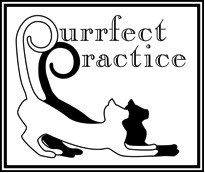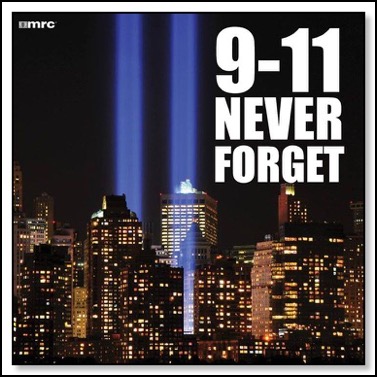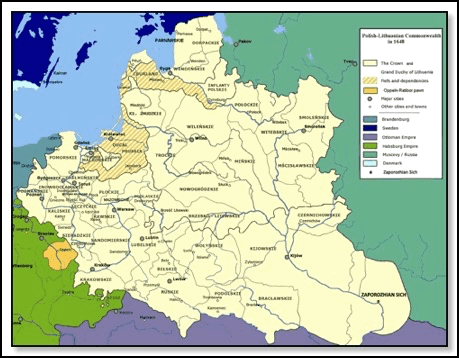History
Mt. St. Helens 2024
25/08/24 13:32
A week ago, we traveled up to southwest Washington State to go to the Mt. St. Helens Volcanic National Monument. We watched the eruption and subsequent ash clouds on May 18, 1980 and on from our home then in Vancouver, WA. We have pictures from that time.
The drive was beautiful and the information centers were informative. This all brought back memories. The Johnston Ridge Observatory and Spirit Lake were off limits due to a road landslide which will be another 2 years to repair. Harry Truman who lived at Spirit Lake and lost his life there that Sunday is buried under 150 feet of volcanic ash and mountain slide plus lake level.
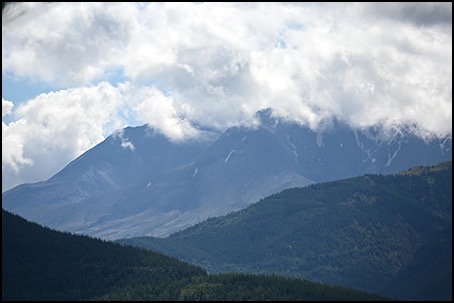
The drive was beautiful and the information centers were informative. This all brought back memories. The Johnston Ridge Observatory and Spirit Lake were off limits due to a road landslide which will be another 2 years to repair. Harry Truman who lived at Spirit Lake and lost his life there that Sunday is buried under 150 feet of volcanic ash and mountain slide plus lake level.

Comments
Greenwich England and Time
27/07/24 09:32
How did Greenwich England just alongside London become the center of time for the world? We did visit in one of our trips to London the Royal Observatory and learned about this history and the discovery of longitude which was important for ships traveling the global seas.
See more in this article.
See more in this article.
George Washington, General
06/07/24 17:55
George Washington lost more battles and won them. More details:
"General George Washington embodies the phrase “losing the battle but winning the war,” because during the American Revolution, he lost more battles than he won. Despite some experience in the British army, Washington had little experience fielding a large fighting force, and the Continental Army was filled with soldiers who were far from professional fighters. However, Washington’s resilience, determination, and long-term strategy eventually won the day. According to Washington’s aide Alexander Hamilton, the plan was simple: “Our hopes are not placed in any particular city, or spot of ground, but in preserving a good army … to take advantage of favorable opportunities, and waste and defeat the enemy by piecemeal.” Washington, also aided by competent generals and assisted by the French navy, decisively ended British ambitions in the colonies at the Battle of Yorktown in 1781. "
"General George Washington embodies the phrase “losing the battle but winning the war,” because during the American Revolution, he lost more battles than he won. Despite some experience in the British army, Washington had little experience fielding a large fighting force, and the Continental Army was filled with soldiers who were far from professional fighters. However, Washington’s resilience, determination, and long-term strategy eventually won the day. According to Washington’s aide Alexander Hamilton, the plan was simple: “Our hopes are not placed in any particular city, or spot of ground, but in preserving a good army … to take advantage of favorable opportunities, and waste and defeat the enemy by piecemeal.” Washington, also aided by competent generals and assisted by the French navy, decisively ended British ambitions in the colonies at the Battle of Yorktown in 1781. "
Human Species
01/06/24 13:56
Most of us do not realize that there have been around 21 human species that have lived on this planet Earth. I came across this article that gives an introduction to the past history of humans.
| "Each one of the billions of people living on Earth today belongs to the same species: |
| The first humans in the same genus as |
Roots of the Kentucky Derby
11/05/24 08:47
Having been to see some horse racing at Churchill Downs in Louisville, KY, I find the horse race of the Kentucky Derby fascinating. I didn't think I'd like to watch horse racing yet I did.
Here is some background on how this race began…
"The Kentucky Derby is a global sports spectacle and, in the eyes of many, America’s definitive sporting tradition. The event was forged, remarkably, by two of the great epic events in United States history: the triumph of the Lewis and Clark Expedition and the tragedy of the Civil War.The bluegrass seeds of the world's most famous horse race were planted by a fascinating man with a uniquely American heritage. His name: Meriwether Lewis Clark Jr., grandson of Lewis Clark, one-half of the Lewis-Clark Expedition. He founded both the Kentucky Derby, which has been run every year since 1875, and the Louisville Jockey Club, later known as Churchill Downs."
Here is some background on how this race began…
"The Kentucky Derby is a global sports spectacle and, in the eyes of many, America’s definitive sporting tradition. The event was forged, remarkably, by two of the great epic events in United States history: the triumph of the Lewis and Clark Expedition and the tragedy of the Civil War.The bluegrass seeds of the world's most famous horse race were planted by a fascinating man with a uniquely American heritage. His name: Meriwether Lewis Clark Jr., grandson of Lewis Clark, one-half of the Lewis-Clark Expedition. He founded both the Kentucky Derby, which has been run every year since 1875, and the Louisville Jockey Club, later known as Churchill Downs."
Lincoln and Secret Service
06/05/24 14:36
An interesting Presidential history fact:
On April 14, 1865, just hours before he was tragically shot by John Wilkes Booth at Ford’s Theatre in Washington, D.C., President Abraham Lincoln signed legislation creating the Secret Service. At the time, however, the new department’s purpose was not to provide presidential protection — it was to combat counterfeit currency.
By the end of the Civil War, nearly one-third of the U.S. currency in circulation was forged; the Secret Service was founded as a bureau within the Treasury Department to rehabilitate and safeguard the country’s monetary system. The night of Lincoln’s assassination, just one local police officer was assigned to escort the President from the White House to the theater, but the officer’s whereabouts at the time of the shooting are unknown. It was not until after the assassination of President William McKinley in 1901, when Vice President Theodore Roosevelt took over, that the Secret Service’s mandate was expanded to include the protection of the President.
Theodore Roosevelt attended and watched Lincoln's funeral train at the age of six. Another Mt. Rushmore historical incident.
On April 14, 1865, just hours before he was tragically shot by John Wilkes Booth at Ford’s Theatre in Washington, D.C., President Abraham Lincoln signed legislation creating the Secret Service. At the time, however, the new department’s purpose was not to provide presidential protection — it was to combat counterfeit currency.
By the end of the Civil War, nearly one-third of the U.S. currency in circulation was forged; the Secret Service was founded as a bureau within the Treasury Department to rehabilitate and safeguard the country’s monetary system. The night of Lincoln’s assassination, just one local police officer was assigned to escort the President from the White House to the theater, but the officer’s whereabouts at the time of the shooting are unknown. It was not until after the assassination of President William McKinley in 1901, when Vice President Theodore Roosevelt took over, that the Secret Service’s mandate was expanded to include the protection of the President.
Theodore Roosevelt attended and watched Lincoln's funeral train at the age of six. Another Mt. Rushmore historical incident.
Stillness At Appomattox
24/04/24 08:51
Bob and I were staying at a lovely B&B just outside Charlottesville, VA while doing a drive around northern Virginia. We were seeing historic sights, beautiful countryside, and battlefields. At one breakfast there, we heard another party at the B&B talk about a visit to the Appomattox battlefield area and where Lee surrendered to Grant at the end of the Civil War. They commented that the area seemed to have an extra "quiet" and "hush", likely a stillness to it due to the significance of the surrender. Bob and I talked and decided it was worth a 3 hour drive to the location to see it. It was definitely worth a visit and there was a stillness to it.
Here is info on the site from the list of battlefields to visit:
No battlefield tour is complete without a visit to the village of Appomattox Court House, the place where the American Civil War ended on April 9, 1865. After a series of battles known as the Appomattox Campaign, which engaged almost 90,000 soldiers, Confederate General Robert E. Lee officially surrendered to Union General Ulysses S. Grant at McLean House, bringing an end to the war. The park covers approximately 1,800 acres and encompasses many of the village’s original structures and over two dozen restored buildings, including a reconstruction of the McLean House. Visitors can walk on the same dirt road where Lee’s army folded their flags, visit the Confederate cemetery, and discover the quaint village of Appomattox Court House.
Our photo of McLean House.
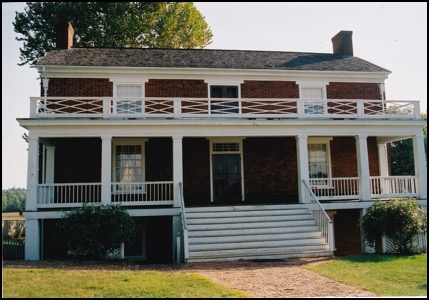
An old photo from an internet site.
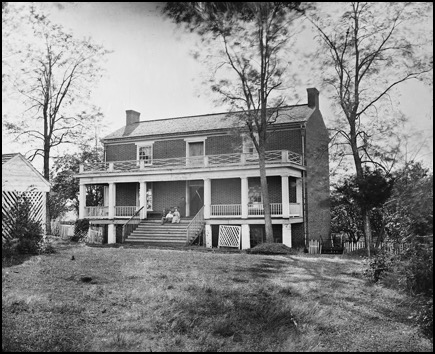
Here is info on the site from the list of battlefields to visit:
No battlefield tour is complete without a visit to the village of Appomattox Court House, the place where the American Civil War ended on April 9, 1865. After a series of battles known as the Appomattox Campaign, which engaged almost 90,000 soldiers, Confederate General Robert E. Lee officially surrendered to Union General Ulysses S. Grant at McLean House, bringing an end to the war. The park covers approximately 1,800 acres and encompasses many of the village’s original structures and over two dozen restored buildings, including a reconstruction of the McLean House. Visitors can walk on the same dirt road where Lee’s army folded their flags, visit the Confederate cemetery, and discover the quaint village of Appomattox Court House.
Our photo of McLean House.

An old photo from an internet site.

Gettysburg-The Turning Point
20/04/24 15:40
Bob and I visited Gettysburg one summer and made the driving tour around the town and battlefield. It is an amazing location and story of a battle that changed a war, then history.
We stayed at a lovely B&B there and had dinner with a person Bob knew from his work in logistics. It would be great to go back there. Here is more on Gettysburg…
"Those immortal words spoken by President Abraham Lincoln in the Gettysburg Address — “four score and seven years ago…” — were inspired by a major turning point in the American Civil War. The Battle of Gettysburg, which took place from July 1 to 3, 1863, marked the end of General Robert E. Lee’s second failed invasion of the North. The Union victory defeated the Confederacy’s ambition of bringing the war to a swift end, but with over 51,000 casualties, the battle stands as the deadliest in the war."
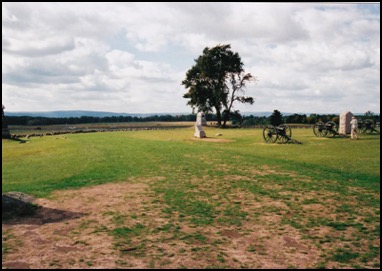
The Angle
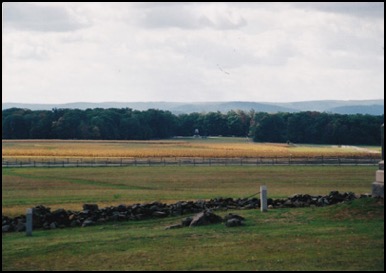
Seminary Ridge
We stayed at a lovely B&B there and had dinner with a person Bob knew from his work in logistics. It would be great to go back there. Here is more on Gettysburg…
"Those immortal words spoken by President Abraham Lincoln in the Gettysburg Address — “four score and seven years ago…” — were inspired by a major turning point in the American Civil War. The Battle of Gettysburg, which took place from July 1 to 3, 1863, marked the end of General Robert E. Lee’s second failed invasion of the North. The Union victory defeated the Confederacy’s ambition of bringing the war to a swift end, but with over 51,000 casualties, the battle stands as the deadliest in the war."

The Angle

Seminary Ridge
Fort Sumter-Charleston
30/03/24 14:20
We got to see Fort Sumter National Monument, not by a regular tour, but by a friend of a friend who took us out be boat to the small island outcropping. We clambered up some stairs above the Charleston harbor waters. It was a glorious day to visit.
More on Fort Sumpter:
On April 12, 1861, Confederate forces fired on Fort Sumter — marking the beginning of the American Civil War. Fort Sumter and Fort Moultrie National Historical Park protects both these historical forts standing guard over Charleston Harbor, in addition to the Charleston Light and Liberty Square. Fort Sumter is accessible only by the official ferry boat, departing from Patriots Point Naval and Maritime Museum and Fort Sumter Visitor Center. There, you can learn about how the fort was built and the events leading to the 1861 battle. Activities at the fort include rangers talks and — for visitors taking the first and last ferries — the raising and lowering of the American flag.
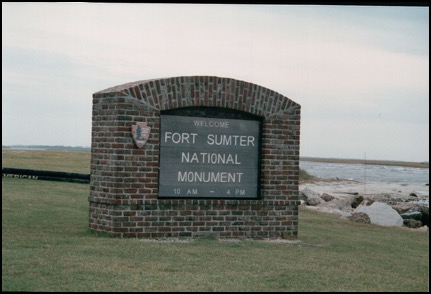
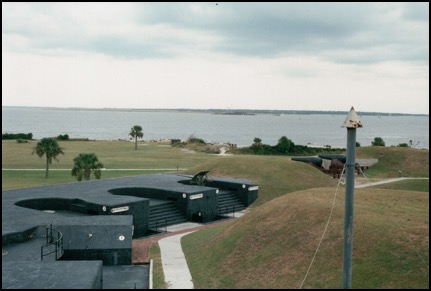
More on Fort Sumpter:
On April 12, 1861, Confederate forces fired on Fort Sumter — marking the beginning of the American Civil War. Fort Sumter and Fort Moultrie National Historical Park protects both these historical forts standing guard over Charleston Harbor, in addition to the Charleston Light and Liberty Square. Fort Sumter is accessible only by the official ferry boat, departing from Patriots Point Naval and Maritime Museum and Fort Sumter Visitor Center. There, you can learn about how the fort was built and the events leading to the 1861 battle. Activities at the fort include rangers talks and — for visitors taking the first and last ferries — the raising and lowering of the American flag.


Antietam Battlefield
29/03/24 10:01
Bob and I have visited the Antietam National Battlefield near Sharpsburg, MD. It was quite the experience driving along the points of interest and listening to the tour CD. We could get a great sense of the battle and loss of so many soldiers lives. I have different photos from the visit, one of my favorites is a view of Bloody Lane. I have used this photo as a screenshot backdrop for computers.
Here is some additional information about Antietam.
Known as the Battle of Sharpsburg in some Southern states, the Battle of Antietam marked the deadliest single day of combat in American history. Part of the Maryland Campaign, the battle was the first field army engagement to take place on Union soil in the Eastern Theater of the Civil War. It not only put an end to the first invasion into the North by the Confederate Army of Northern Virginia, but also paved the way for Abraham Lincoln to issue the preliminary Emancipation Proclamation.
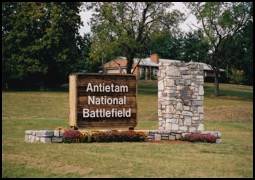
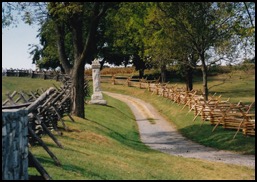
Here is some additional information about Antietam.
Known as the Battle of Sharpsburg in some Southern states, the Battle of Antietam marked the deadliest single day of combat in American history. Part of the Maryland Campaign, the battle was the first field army engagement to take place on Union soil in the Eastern Theater of the Civil War. It not only put an end to the first invasion into the North by the Confederate Army of Northern Virginia, but also paved the way for Abraham Lincoln to issue the preliminary Emancipation Proclamation.


Vasa Museum Sweden
11/03/24 12:18
Bob and I visited a fascinating museum when we visited Stockholm Sweden in 1997 on a travel trip from Stockholm over to Norway. We saw a lot of the countryside on the drive across.The food selection was better than Norway at that time in restaurants and not as expensive.
While in Stockholm we took a sightseeing boat around the harbor and at one stop went to see the Vasa Museum. The ship in the museum is enclosed in a large dark architectural building. When one enters, you get to see the story of how this ship was sunk in the harbor and raised to become part of the museum. One of the best places to visit I have been.
The following is a description in an article on different museums plus a photo of the museum on the right looking from the harbor.
A massive wooden warship might not seem like most people's first choice for a museum, but then again Sweden has never done things by the book. The Vasa Museum displays an almost fully-intact 17th-century ship, which sunk in 1628 and has since been salvaged. The museum was built around the ship, which stands on a dry dock. You can tour the ship and the accompanying exhibits that detail its history for an engaging and awe-inspiring experience.

While in Stockholm we took a sightseeing boat around the harbor and at one stop went to see the Vasa Museum. The ship in the museum is enclosed in a large dark architectural building. When one enters, you get to see the story of how this ship was sunk in the harbor and raised to become part of the museum. One of the best places to visit I have been.
The following is a description in an article on different museums plus a photo of the museum on the right looking from the harbor.
A massive wooden warship might not seem like most people's first choice for a museum, but then again Sweden has never done things by the book. The Vasa Museum displays an almost fully-intact 17th-century ship, which sunk in 1628 and has since been salvaged. The museum was built around the ship, which stands on a dry dock. You can tour the ship and the accompanying exhibits that detail its history for an engaging and awe-inspiring experience.

Chalmette Battlefield Next
27/02/24 11:07
Another one of the six battlefields one can visit and we have is in Louisiana, just outside New Orleans…
Located downriver from New Orleans, Chalmette Battlefield was the site of the last great battle of the War of 1812, fought between the U.S. and Great Britain. Although the Treaty of Ghent was signed in late 1814, the war continued. On January 8, 1815, General Andrew Jackson assembled troops from across Louisiana and the southeastern U.S. to defeat the British military and prevent them from gaining control of a critical port on the Mississippi River. The Battle of New Orleans was hailed as the final victory in the “Second War of Independence,” and for decades it was celebrated as a national holiday, much like the Fourth of July. A visit to Chalmette Battlefield offers the chance to walk in the footsteps of General Jackson (who went on to become the seventh U.S. President) and his troops. It contains a reconstructed American rampart, an original home from the 1830s, and the stunning,100-foot-high Chalmette Monument. Delve further into the history of the battle site via films and exhibits at the visitor center, where you’ll find outdoor exhibits, self-guided tours, and daily ranger talks. Also of interest is Chalmette National Cemetery: Established during the Civil War in 1864, it shelters more than 14,000 graves of Americans, dating from the War of 1812 to the Vietnam War.
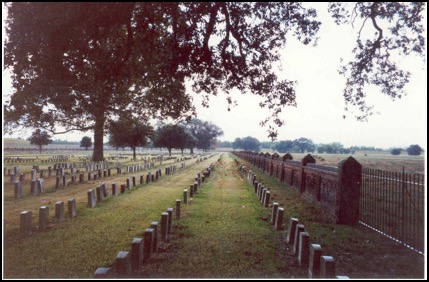
Located downriver from New Orleans, Chalmette Battlefield was the site of the last great battle of the War of 1812, fought between the U.S. and Great Britain. Although the Treaty of Ghent was signed in late 1814, the war continued. On January 8, 1815, General Andrew Jackson assembled troops from across Louisiana and the southeastern U.S. to defeat the British military and prevent them from gaining control of a critical port on the Mississippi River. The Battle of New Orleans was hailed as the final victory in the “Second War of Independence,” and for decades it was celebrated as a national holiday, much like the Fourth of July. A visit to Chalmette Battlefield offers the chance to walk in the footsteps of General Jackson (who went on to become the seventh U.S. President) and his troops. It contains a reconstructed American rampart, an original home from the 1830s, and the stunning,100-foot-high Chalmette Monument. Delve further into the history of the battle site via films and exhibits at the visitor center, where you’ll find outdoor exhibits, self-guided tours, and daily ranger talks. Also of interest is Chalmette National Cemetery: Established during the Civil War in 1864, it shelters more than 14,000 graves of Americans, dating from the War of 1812 to the Vietnam War.

Six Must See Battlefields
26/02/24 18:02
While reading through a Daily Passport email, one of their story leads was about six must-see battlefields in the United States. We have visited all six at some point. I will start with the last one we visited last October, Shiloh Battlefield, located in southern Tennessee just over the Tennessee-Mississippi border. The largest loss of life in a battle in the U.S. and in some respects a draw between the Union and Rebel forces.
From the article:
The Battle of Shiloh, also known as the Battle of Pittsburg Landing, was one of the most significant battles in the Mississippi Valley Campaign of the Civil War. The Union’s victory on April 7, 1862, came at a high cost, resulting in more casualties than in all of America’s previous wars combined. Occupying over 5,000 acres, Shiloh National Military Park offers visitors the chance to discover several historic sites. These include the Corinth Battlefield Unit, which preserves the Siege and Battle of Corinth, and the Shiloh National Cemetery, the resting place of around 4,000 fallen soldiers. Also found here are the Shiloh Indian Mounds, an archeological remnant of the South Appalachian Mississippi culture that lived in the area around 1200 CE. A great way to explore the park is by driving its 12.7-mile, 22-stop self-guided tour of the battlefield. Alternatively, visitors can hike along trails or ride a bicycle or e-bike around the paved roads. Whichever way you get around, you’ll get the chance to spot local wildlife, including 186 bird species, such as the majestic bald eagle and great-horned owl.

From the article:
The Battle of Shiloh, also known as the Battle of Pittsburg Landing, was one of the most significant battles in the Mississippi Valley Campaign of the Civil War. The Union’s victory on April 7, 1862, came at a high cost, resulting in more casualties than in all of America’s previous wars combined. Occupying over 5,000 acres, Shiloh National Military Park offers visitors the chance to discover several historic sites. These include the Corinth Battlefield Unit, which preserves the Siege and Battle of Corinth, and the Shiloh National Cemetery, the resting place of around 4,000 fallen soldiers. Also found here are the Shiloh Indian Mounds, an archeological remnant of the South Appalachian Mississippi culture that lived in the area around 1200 CE. A great way to explore the park is by driving its 12.7-mile, 22-stop self-guided tour of the battlefield. Alternatively, visitors can hike along trails or ride a bicycle or e-bike around the paved roads. Whichever way you get around, you’ll get the chance to spot local wildlife, including 186 bird species, such as the majestic bald eagle and great-horned owl.

Post Presidency-Theodore Roosevel
20/02/24 19:17
President's Holiday was just yesterday. I did not get a post written. I plan to catch up today in posting about Theodore Roosevelt. He was a President who had an interesting and active life before and after his Presidency. This is information from History Facts.
"Theodore Roosevelt was never a man to sit on the sidelines twiddling his thumbs. Following his disappointing loss to Woodrow Wilson in the 1912 presidential election (which would have given Roosevelt a third term in office), the 55-year-old decided to embark upon a dangerous expedition down an uncharted tributary of the Brazilian Amazon called the Rio da Dúvida, or River of Doubt. Accompanied by his 23-year-old son Kermit and a team of porters, explorers, and scientists, Roosevelt set off in December 1913. By the time they reached the River of Doubt in February 1914, they had already lost a number of team members to tropical illnesses, and half their pack animals had died. As they ventured farther down the unmapped territory, they had to contend with everything from mosquitoes to alligators to the potential threat of attack from Indigenous peoples in the area. Roosevelt got malaria during the lengthy expedition, and became dangerously ill. Still, the team managed to reach the end of their journey, at which point Roosevelt sent an understated telegram describing it as “a hard and somewhat dangerous, but very successful trip.”
"Theodore Roosevelt was never a man to sit on the sidelines twiddling his thumbs. Following his disappointing loss to Woodrow Wilson in the 1912 presidential election (which would have given Roosevelt a third term in office), the 55-year-old decided to embark upon a dangerous expedition down an uncharted tributary of the Brazilian Amazon called the Rio da Dúvida, or River of Doubt. Accompanied by his 23-year-old son Kermit and a team of porters, explorers, and scientists, Roosevelt set off in December 1913. By the time they reached the River of Doubt in February 1914, they had already lost a number of team members to tropical illnesses, and half their pack animals had died. As they ventured farther down the unmapped territory, they had to contend with everything from mosquitoes to alligators to the potential threat of attack from Indigenous peoples in the area. Roosevelt got malaria during the lengthy expedition, and became dangerously ill. Still, the team managed to reach the end of their journey, at which point Roosevelt sent an understated telegram describing it as “a hard and somewhat dangerous, but very successful trip.”
What Friendship Means
12/02/24 19:25
Today is Abraham Lincoln's birthday and part of the upcoming federal holiday of President's Day which is shared with another special President, George Washington.
This column shares how Lincoln had a gift for friendship that carried him into greatness and the Presidency. How special is it to have friends who could be your enemy yet see a potential rival as a best friend. It is wonderful to have such support in life.
"His genius for friendship manifested itself in memorable ways. As a young man, for example, Lincoln’s physical stature and strength made him a formidable wrestler. He made friends by wrestling, although this was not the kind of wrestling that is a branch of show business or in which the outcome of the match is agreed upon by the contestants in advance."
This column shares how Lincoln had a gift for friendship that carried him into greatness and the Presidency. How special is it to have friends who could be your enemy yet see a potential rival as a best friend. It is wonderful to have such support in life.
"His genius for friendship manifested itself in memorable ways. As a young man, for example, Lincoln’s physical stature and strength made him a formidable wrestler. He made friends by wrestling, although this was not the kind of wrestling that is a branch of show business or in which the outcome of the match is agreed upon by the contestants in advance."
Mary Todd Lincoln
21/01/24 17:12
I have long been a Abraham Lincoln fan and admire his speeches and writings. His wife's story is fascinating and she has had controversial coverage in history. This following information is not something I have come across in the past. She was also courted by Stephen Douglas, the man most associated with Lincoln in his rise in politics and to the Presidency.
While Abraham Lincoln and Stephen Douglas famously sparred in a series of debates for a U.S. Senate seat in 1858, they also competed for the affections of the same fiery Kentucky woman some 20 years earlier. After moving to Springfield, Illinois, in the late 1830s, Mary drew the attention of promising suitors like Douglas, then a rising lawyer and politician. However, the ambition and charisma of the "Little Giant" wasn't enough to win her over; when Douglas asked for her hand in marriage, she reportedly replied, "I can't consent to be your wife. I shall become Mrs. President, or I am the victim of false prophets, but it will not be as Mrs. Douglas."
While Abraham Lincoln and Stephen Douglas famously sparred in a series of debates for a U.S. Senate seat in 1858, they also competed for the affections of the same fiery Kentucky woman some 20 years earlier. After moving to Springfield, Illinois, in the late 1830s, Mary drew the attention of promising suitors like Douglas, then a rising lawyer and politician. However, the ambition and charisma of the "Little Giant" wasn't enough to win her over; when Douglas asked for her hand in marriage, she reportedly replied, "I can't consent to be your wife. I shall become Mrs. President, or I am the victim of false prophets, but it will not be as Mrs. Douglas."
Roman Mosaic Discovered
24/12/23 07:41
Recently archeologists in Rome found a buried mosaic in a large banquet room from the first or second century B.C. Amazing!!
The article is found here.
Estimated to be around 2,300 years old, the work is part of a larger aristocratic mansion, located near the Roman Forum, that has been under excavation since 2018.
Almost five meters long (16.4 ft) and featuring depictions of vines, lotus leaves, tridents, trumpets, helmets and mythological marine creatures, the mosaic scene was painstakingly created using mother of pearl, shells, corals, shards of precious glass and flecks of marble. The piece is framed by polychrome crystals, spongy travertine, and exotic, ancient Egyptian blue tiles.
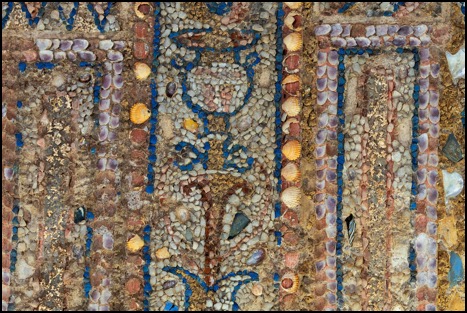
Credit for photo in article
The article is found here.
Estimated to be around 2,300 years old, the work is part of a larger aristocratic mansion, located near the Roman Forum, that has been under excavation since 2018.
Almost five meters long (16.4 ft) and featuring depictions of vines, lotus leaves, tridents, trumpets, helmets and mythological marine creatures, the mosaic scene was painstakingly created using mother of pearl, shells, corals, shards of precious glass and flecks of marble. The piece is framed by polychrome crystals, spongy travertine, and exotic, ancient Egyptian blue tiles.

Credit for photo in article
Gettysburg Address at 160 Years
20/11/23 08:18
Yesterday was the 160th anniversary of Abraham Lincoln's Gettysburg Address commemorating the loss of soldiers' lives at battle of Gettysburg in Pennsylvania. It is considered the best speech of any President and was only 2 minutes long. The speech was actually ridiculed for being short at that time. History has shown differently. The address:
Four score and seven years ago our fathers brought forth on this continent, a new nation, conceived in Liberty, and dedicated to the proposition that all men are created equal.
Now we are engaged in a great civil war, testing whether that nation, or any nation so conceived and so dedicated, can long endure. We are met on a great battle-field of that war. We have come to dedicate a portion of that field, as a final resting place for those who here gave their lives that that nation might live. It is altogether fitting and proper that we should do this.
But, in a larger sense, we can not dedicate — we can not consecrate — we cannot hallow — this ground. The brave men, living and dead, who struggled here, have consecrated it, far above our poor power to add or detract. The world will little note, nor long remember what we say here, but it can never forget what they did here. It is for us the living, rather, to be dedicated here to the unfinished work which they who fought here have thus far so nobly advanced. It is rather for us to be here dedicated to the great task remaining before us — that from these honored dead we take increased devotion to that cause for which they gave the last full measure of devotion — that we here highly resolve that these dead shall not have died in vain — that this nation, under God, shall have a new birth of freedom — and that government of the people, by the people, for the people, shall not perish from the earth.
Four score and seven years ago our fathers brought forth on this continent, a new nation, conceived in Liberty, and dedicated to the proposition that all men are created equal.
Now we are engaged in a great civil war, testing whether that nation, or any nation so conceived and so dedicated, can long endure. We are met on a great battle-field of that war. We have come to dedicate a portion of that field, as a final resting place for those who here gave their lives that that nation might live. It is altogether fitting and proper that we should do this.
But, in a larger sense, we can not dedicate — we can not consecrate — we cannot hallow — this ground. The brave men, living and dead, who struggled here, have consecrated it, far above our poor power to add or detract. The world will little note, nor long remember what we say here, but it can never forget what they did here. It is for us the living, rather, to be dedicated here to the unfinished work which they who fought here have thus far so nobly advanced. It is rather for us to be here dedicated to the great task remaining before us — that from these honored dead we take increased devotion to that cause for which they gave the last full measure of devotion — that we here highly resolve that these dead shall not have died in vain — that this nation, under God, shall have a new birth of freedom — and that government of the people, by the people, for the people, shall not perish from the earth.
Kristallnacht
09/11/23 08:40
Today this the 85th Anniversary of Kristallnacht in Germany. It was felt to be the visible beginning of the Holocaust for the Jews.
Information from The Lid Blog about that day and the Anniversary follows —
Kristallnacht, the Night of Broken Glass, was a nationwide anti-Jewish pogrom in Nazi Germany. It began on the evening of November 9, 1938, and continued through the next day…
Kristallnacht was a coordinated attack on the Jewish people and their property, 99 Jews were murdered, 25,000 to 30,000 were arrested and placed in concentration camps. Two hundred and sixty-seven synagogues were destroyed, and thousands of homes and businesses were ransacked. Just Like Hamas did to Kibbutzim on Oct. 7th.
The attacks were carried out by the Hitler Youth, the Gestapo, and the SS. Kristallnacht also served as a pretext and a means for the wholesale confiscation of firearms from German Jews and was part of the broader Nazi policy of Antisemitism. Kristallnacht was followed by more horrific anti-Semitic economic and political abuses and horrible genocide.
Information from The Lid Blog about that day and the Anniversary follows —
Kristallnacht, the Night of Broken Glass, was a nationwide anti-Jewish pogrom in Nazi Germany. It began on the evening of November 9, 1938, and continued through the next day…
Kristallnacht was a coordinated attack on the Jewish people and their property, 99 Jews were murdered, 25,000 to 30,000 were arrested and placed in concentration camps. Two hundred and sixty-seven synagogues were destroyed, and thousands of homes and businesses were ransacked. Just Like Hamas did to Kibbutzim on Oct. 7th.
The attacks were carried out by the Hitler Youth, the Gestapo, and the SS. Kristallnacht also served as a pretext and a means for the wholesale confiscation of firearms from German Jews and was part of the broader Nazi policy of Antisemitism. Kristallnacht was followed by more horrific anti-Semitic economic and political abuses and horrible genocide.
Bob Plays Grant
31/10/23 14:57
We visited Pittsburg Landing at the Shiloh National Battlefield. It is right alongside (west side) of the battlefield especially where the Union soldiers were stationed and near Grant's headquarters. The photo shows where the Union soldiers were ferried and unloaded from transport boats on the Tennessee River. Bob is walking alongside the river at the beachhead. We are just south of the Catfish Hotel Restaurant location, maybe 1/4th mile.
It is good that we were able to visit and have a decent weather day, slightly warm with a mix of clouds and sun. There was recently a cold snap with snow and rolling blackouts in central and eastern Tennessee.
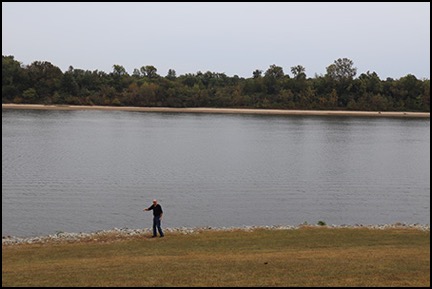
It is good that we were able to visit and have a decent weather day, slightly warm with a mix of clouds and sun. There was recently a cold snap with snow and rolling blackouts in central and eastern Tennessee.

The Graves-Shiloh Battlefield Cemetery
25/10/23 11:15
One strikingly serene and beautiful spot at the Shiloh Battlefield National Park was the cemetery. The grass and trees on the rolling terrain evoked the sadness of the loss of soldiers on both sides of the fight. There is a larger memorial than in the accompanying photo that announces the location of General Grant's headquarters and tent in that location. Along this area was the Union Army's center which they needed to hold in the face of Confederate troops. The Union almost lost this battle though they came back when additional troops arrived from other parts of Tennessee. Both sides battled to a draw and lived to fight another day or 3 years.
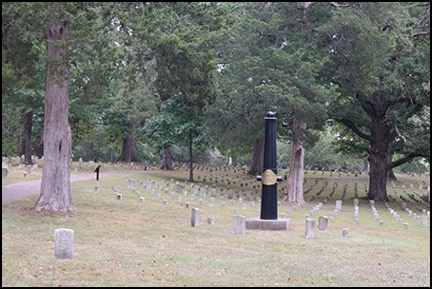

General Albert Sydney Johnston At Shiloh
23/10/23 08:32
One of the Shiloh Battlefield tour stops (#17) Bob and I visited during our trip to Shiloh was where General Albert Sydney Johnston died during the battle. He had a bullet wound to his leg and was unaware he was bleeding heavily into his boot until he collapsed. He was considered one of the top generals with General Robert E. Lee and his loss was devastating to the Confederate Army. He was a measured military man with significant knowledge of the battlefield. Below is the monument at Shiloh to where he died. Information about him and the battle can be found here and here.
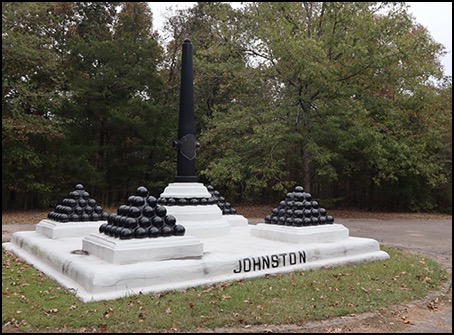

Shiloh Civil War Battlefied
20/10/23 15:16
Bob and I just got back from Memphis Tennessee earlier this week. One week ago we drove 2 hours east to the Shiloh National Park Battlefield near Shiloh TN. This covers a lot of area around the town and west of the Tennessee River. This is probably 15-20 miles north of Corinth, MS where the Confederate forces were bivouacked. Corinth was a major railroad connection in the South and one of the targets of the Union army under General Grant.
We had a great trip and saw a bit of the area while there. We also watched a 30 minutes film at the Visitor's Center while there.
Here is the sign for the entrance to the visitor's part of the park.

We had a great trip and saw a bit of the area while there. We also watched a 30 minutes film at the Visitor's Center while there.
Here is the sign for the entrance to the visitor's part of the park.

What Is In A Name Again
30/09/23 16:21
We are back at "What Is In A Name" with Mt. Rushmore. It is such a cool place to visit and awe-inspiring. This information comes from an Interesting Facts email I get daily. Enjoy the information!
The iconic mountain that bears the giant stone faces of four U.S. Presidents is named after a lawyer from New York. In 1884, Charles E. Rushmore was sent to the Black Hills in South Dakota to secure land for tin mining (on lands considered sacred by the Lakota Sioux). He spent many weeks exploring the area with guides, and at one point, he inquired as to the name of an impressive peak nearby. Since the mountain had no name, a prospector with him replied, “We will name it now, and name it Rushmore Peak.” From then on, it was referred to as Rushmore Peak, Rushmore Mountain, or Rushmore Rock. When the national memorial was finished in 1927, it officially became known as Mount Rushmore.
The iconic mountain that bears the giant stone faces of four U.S. Presidents is named after a lawyer from New York. In 1884, Charles E. Rushmore was sent to the Black Hills in South Dakota to secure land for tin mining (on lands considered sacred by the Lakota Sioux). He spent many weeks exploring the area with guides, and at one point, he inquired as to the name of an impressive peak nearby. Since the mountain had no name, a prospector with him replied, “We will name it now, and name it Rushmore Peak.” From then on, it was referred to as Rushmore Peak, Rushmore Mountain, or Rushmore Rock. When the national memorial was finished in 1927, it officially became known as Mount Rushmore.
Presidents on Mt. Rushmore
21/09/23 15:19
The four Presidents depicted on Mount Rushmore were chosen for their key roles in American history. The carved face of George Washington, completed in 1930, is the most prominent figure on the memorial and represents the founding of the nation. Thomas Jefferson, dedicated in 1936, stands for the growth of the United States, thanks to his authorship of the Declaration of Independence and his roles in the Louisiana Purchase and the Lewis and Clark expedition. Borglum chose the figure of Abraham Lincoln, dedicated in 1937, to represent American unity for his efforts to preserve the nation during the Civil War. Theodore Roosevelt, finished in 1939, symbolizes the development of the United States as a world power (he helped negotiate the construction of the Panama Canal, among other achievements) and champion of the worker as he fought to end corporate monopolies. (From Interesting Facts).
Little Bighorn National Monument
08/08/23 17:05
"Little Bighorn Battlefield National Monument is a memorial to those who lost their lives on June 25-26, 1876. It was then that Lieutenant Colonel George Armstrong Custer led the Seventh Cavalry Regiment into battle against the Lakota Sioux and Cheyenne tribes, led by Sitting Bull. They hoped to take advantage of the element of surprise but found themselves outnumbered and up against warriors who fought bravely to defend their way of life. But although the Native American forces won the battle, Custer’s fate galvanized public opinion and it would have devastating long-term consequences for the Lakota Sioux and Cheyenne people. Within a year, the U.S. government annexed their land and established reservations. Over a century later, the monument was renamed to honor losses on both sides and present a more balanced account of what happened. The visitor center and museum recounts the events and consequences of the battle and also provides an insight into the lives of the Plains Indians at that time."
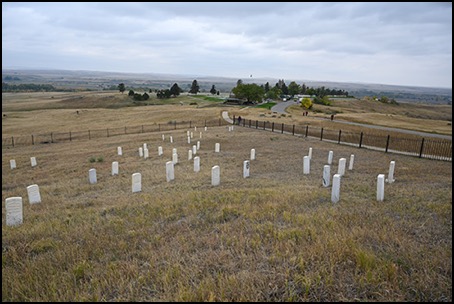

President Warren Harding
02/08/23 19:12
Was President Warren G. Harding murdered? He died 100 years ago today and there has been a mystery around what was the cause of death and why - since he died rather quickly and not of a lingering illness. Did his wife murder him as some suggested due to he may have had a witness who had his child? Politics is brutal currently and it sounds like there was some familiar characters then to ones who live in current times. All without social media.
The speculation can be read here.
The speculation can be read here.
Crazy Horse Memorial
31/07/23 13:59
From the Epoch Times:
Almost everyone has heard of Mount Rushmore. But far fewer know that just 8 miles away, work is now taking place on the world’s largest sculpture—orders of magnitude larger than that homage to American presidents. The carving is called Crazy Horse, and its roots are a world apart from modern-day politics. It’s so enormous that if you were to pile the four presidential heads of Mount Rushmore on top of one another, they wouldn’t even reach halfway up the colossal work in progress.
This memorial is truly epic. Its carving began 75 years ago and was sparked by an unlikely friendship. Chief Henry Standing Bear, a local Native American, was a legendary character in Native culture; this visionary Lakota Indian, a great public speaker and thinker, was passionate about finding new ways of preserving his people’s history and tradition. But it was his cousin, a war hero by the name of Crazy Horse, who was revered by the Lakota as a truly iconic warrior.
When Standing Bear caught wind of plans to build a memorial in honor of Crazy Horse in Nebraska, he appealed to the one spearheading the project. The rightful place for such a carving, he said, was the Black Hills in western South Dakota, which are considered sacred by the Lakota. This small, isolated mountain range covered in pine forest is the oldest in the United States, and Native Americans have inhabited the region for almost 10,000 years.
It’s hard to know just when—or whether at all—the Crazy Horse Memorial will be finished. If it eventually is, it would measure 641 feet (195 meters) long and 563 feet (171 meters) high; and the dream started by Standing Bear and Mr. Ziolkowski 76 years ago, will at long last be realized.
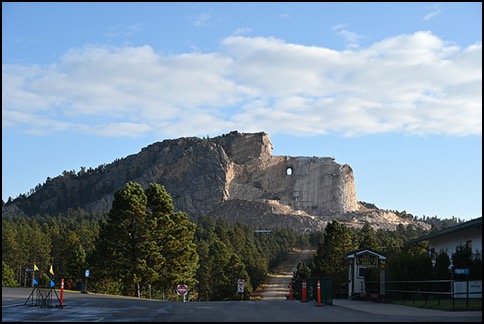
Almost everyone has heard of Mount Rushmore. But far fewer know that just 8 miles away, work is now taking place on the world’s largest sculpture—orders of magnitude larger than that homage to American presidents. The carving is called Crazy Horse, and its roots are a world apart from modern-day politics. It’s so enormous that if you were to pile the four presidential heads of Mount Rushmore on top of one another, they wouldn’t even reach halfway up the colossal work in progress.
This memorial is truly epic. Its carving began 75 years ago and was sparked by an unlikely friendship. Chief Henry Standing Bear, a local Native American, was a legendary character in Native culture; this visionary Lakota Indian, a great public speaker and thinker, was passionate about finding new ways of preserving his people’s history and tradition. But it was his cousin, a war hero by the name of Crazy Horse, who was revered by the Lakota as a truly iconic warrior.
When Standing Bear caught wind of plans to build a memorial in honor of Crazy Horse in Nebraska, he appealed to the one spearheading the project. The rightful place for such a carving, he said, was the Black Hills in western South Dakota, which are considered sacred by the Lakota. This small, isolated mountain range covered in pine forest is the oldest in the United States, and Native Americans have inhabited the region for almost 10,000 years.
It’s hard to know just when—or whether at all—the Crazy Horse Memorial will be finished. If it eventually is, it would measure 641 feet (195 meters) long and 563 feet (171 meters) high; and the dream started by Standing Bear and Mr. Ziolkowski 76 years ago, will at long last be realized.

Sesquicentennial Thayer Farm
17/07/23 19:39
We did it!!!! I applied for the Farm Bureau's Sesquicentennial Farm status here in Oregon. It was a lot of work and research. Thankfully, there were and are family members who have kept track of Joab and Ann Beeler Powell's history from the mid-1800s from East Tennessee to Missouri and over the Oregon Trail to Oregon. Their 4th child, Peter Powell, brought his wife, Nancy, and the children born by 1852 to settle on a donation land claim of 320 acres. This piece of property has descended to me through Peter to Rachael Arminta Powell Peterson to Goldie Peterson Wolfenbarger to William E. Wolfenbarger then to me. We should receive a sign and certificate plus the award given during a ceremony at the Oregon State Fair. I am so glad that all the work culminated in the family recognition.
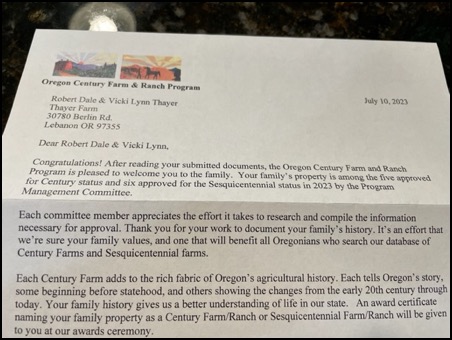

Providence Church and Me
25/06/23 07:16
Yesterday, Bob and I went to the last regularly planned Powell-McKinney reunion at the Providence Church between Lacomb and Scio. The church was established by Joab Powell and Ann Peeler Powell along with others in the 1850s. Joab and Ann were my great-great-great grandparents who came over the Oregon Trail from Missouri to settle in Oregon. Joab was a well-known circuit preacher in Oregon.
Bob took a photo of me beside the monument to Joab and the founders of the Church. The stone needs some cleaning to show the inscriptions better. I'm sure they will get there.
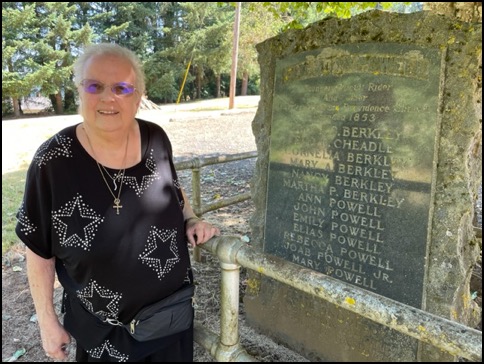
Bob took a photo of me beside the monument to Joab and the founders of the Church. The stone needs some cleaning to show the inscriptions better. I'm sure they will get there.

Behind Lincoln's Head
01/05/23 16:33
We are headed out in the morning to drive 3 days to see David, Renee, Nicolas, Ryan, and Jesse in Aberdeen, SD. It is a long trip yet there is a lot to see along the way (and back). The last trip we went by and saw Mt. Rushmore! It was awesome and worth viewing. I guess you could say I cried for having a beautiful morning to visit.
I did come across this article about the vault and tunnel hidden behind Lincoln's head at the monument.
Here is some detail:
"The sculptor of Mount Rushmore, Danish American Gutzon Borglum, had the heads basically completed for all intents and purposes and, one year prior to his wrapping up the project in 1941, he somewhat clandestinely commenced work on what was to be a grand Hall of Records for the monument.
Within a nook behind Lincoln’s lithic likeness, the hall would delve deep into the living granite rock. It would feature 14-foot-high twin doors, beyond which there would be a chamber whose ceiling would soar 100 feet overhead. There would be glorious statues of famous Americans lining this hall, including American Indian leaders and important political figures. The majestic space would display, among other writings, the nation’s founding documents: the Declaration of Independence, the Constitution, and the Bill of Rights…
Yet his work went unfinished. The war effort saw funds dry up, and Congress ordered him to just finish the heads and be done. Yet he persisted in his excavation of the hall until the House found out and promptly squelched his foray. He insisted its completion was necessary.
Though Borglum’s grand scheme survives on paper, only a rough passage saw fruition in carving. Boring diagonally up into the mountain, the markings of old tools bear testament to this effort—air-powered chisels and dynamite were used to bite away chunks of the dense granite while finer tools finished it. Jagged within, the tunnel evens out nearer the opening as workers meticulously “bumped” raw surfaces into walls as straight and smooth as finished concrete."
I did come across this article about the vault and tunnel hidden behind Lincoln's head at the monument.
Here is some detail:
"The sculptor of Mount Rushmore, Danish American Gutzon Borglum, had the heads basically completed for all intents and purposes and, one year prior to his wrapping up the project in 1941, he somewhat clandestinely commenced work on what was to be a grand Hall of Records for the monument.
Within a nook behind Lincoln’s lithic likeness, the hall would delve deep into the living granite rock. It would feature 14-foot-high twin doors, beyond which there would be a chamber whose ceiling would soar 100 feet overhead. There would be glorious statues of famous Americans lining this hall, including American Indian leaders and important political figures. The majestic space would display, among other writings, the nation’s founding documents: the Declaration of Independence, the Constitution, and the Bill of Rights…
Yet his work went unfinished. The war effort saw funds dry up, and Congress ordered him to just finish the heads and be done. Yet he persisted in his excavation of the hall until the House found out and promptly squelched his foray. He insisted its completion was necessary.
Though Borglum’s grand scheme survives on paper, only a rough passage saw fruition in carving. Boring diagonally up into the mountain, the markings of old tools bear testament to this effort—air-powered chisels and dynamite were used to bite away chunks of the dense granite while finer tools finished it. Jagged within, the tunnel evens out nearer the opening as workers meticulously “bumped” raw surfaces into walls as straight and smooth as finished concrete."
Use of Horses In America
08/04/23 13:16
A recent study published in Science Magazine indicates horses were first used by Native Americans earlier than previously believed. The theory before was that horses were more widespread by the late 1600s but different factors indicate they were widespread by the early 1600s.
"Native American people integrated horses into their communities much earlier than European colonial records suggest, according to an innovative study Thursday that combined archaeological and genetic analysis with Indigenous oral traditions. The study is the first using both Western science and traditional knowledge to be published in the prestigious Science journal, the researchers said.
Based on European records from colonial times, historians have long contended that Native American people did not interact much with horses in the American West until the late 1600s.
Scholars often say the turning point was the Pueblo Revolt of 1680, when Indigenous people staged an uprising against Spanish colonizers in what is now New Mexico, releasing many European horses in the process.
However, the new research, which traces the spread of horses from the American Southwest into the Great Plains and Rocky Mountains regions, contradicts this widely accepted theory."
Original post on regarding this time.
"Native American people integrated horses into their communities much earlier than European colonial records suggest, according to an innovative study Thursday that combined archaeological and genetic analysis with Indigenous oral traditions. The study is the first using both Western science and traditional knowledge to be published in the prestigious Science journal, the researchers said.
Based on European records from colonial times, historians have long contended that Native American people did not interact much with horses in the American West until the late 1600s.
Scholars often say the turning point was the Pueblo Revolt of 1680, when Indigenous people staged an uprising against Spanish colonizers in what is now New Mexico, releasing many European horses in the process.
However, the new research, which traces the spread of horses from the American Southwest into the Great Plains and Rocky Mountains regions, contradicts this widely accepted theory."
Original post on regarding this time.
The Man Most Needed
22/02/23 12:06
Today is the anniversary of George Washington's Birthday. It comprises a holiday with Lincoln's birthday earlier to make up President's Day holiday. Washington's reputation has taken hits in recent years. He is thought in the opinion of this blogger the most needed or indispensable man for his time as a military leader then President. He gave up the power of being king as some of his contemporaries wished him to be, to resign and retire to his home on the Potomac.
Here is more information from a blog article from Powerline.
Today we celebrate the anniversary of the birth of George Washington. Of all the great men of the revolutionary era to whom we owe our freedom, Washington’s greatness was the rarest and the most needed. At this remove in time, it is also the hardest to comprehend.
Take, for example, Washington’s contribution to the Constitutional Convention of 1787. Washington’s mere presence lent the undertaking and its handiwork the legitimacy that resulted in success. The convention’s first order of business was the election of a presiding officer. Washington was the delegates’ unanimous choice.
Here is more information from a blog article from Powerline.
Today we celebrate the anniversary of the birth of George Washington. Of all the great men of the revolutionary era to whom we owe our freedom, Washington’s greatness was the rarest and the most needed. At this remove in time, it is also the hardest to comprehend.
Take, for example, Washington’s contribution to the Constitutional Convention of 1787. Washington’s mere presence lent the undertaking and its handiwork the legitimacy that resulted in success. The convention’s first order of business was the election of a presiding officer. Washington was the delegates’ unanimous choice.
Lincoln Makes Friends
12/02/23 17:21
Today is Lincoln's official birthday. He is a person I respect as a man, a human, and a politician.
This is a wonderful article about how Lincoln was a genius at making friendships throughout his career (other than John Wilkes Booth I suppose). Here are some examples of this skill.
The young Lincoln
In 1831 Lincoln left home at age 22 to strike out on his own in the struggling frontier town of New Salem, Illinois. He had no trade and few prospects. The single most striking fact about him as a young man is his genius for friendship.
He was obviously one of the most likable men who ever lived, a man who radiated decency. Moreover, the better his acquaintances got to know him, the more they liked him. Those who got to know him best, such as the acquaintances with whom he shared boarding rooms as an impoverished young man, became lifelong friends. The student of Lincoln who can see him through the eyes of these friends will have a similar experience.
His genius for friendship manifested itself in memorable ways. As a young man, for example, Lincoln’s physical stature and strength made him a formidable wrestler. He made friends by wrestling, although this was not the kind of wrestling that is a branch of show business or in which the outcome of the match is agreed upon by the contestants in advance.
Upon his arrival in New Salem, he was challenged to a match by Jack Armstrong, the leader of a gang called Clary’s Grove Boys. The match is famous in the annals of Lincoln lore and was examined in extraordinary detail by Lincoln scholar Douglas Wilson in the first chapter of his book Honor’s Voice. Although several conflicting eyewitness accounts of the match exist, the accounts generally agree that Armstrong narrowly escaped losing to Lincoln by some sort of sharp practice. The match ended in rancor, but Lincoln and Armstrong immediately became fast friends. Their friendship had momentous consequences in Lincoln’s legal career.
Rest from the blog.
This is a wonderful article about how Lincoln was a genius at making friendships throughout his career (other than John Wilkes Booth I suppose). Here are some examples of this skill.
The young Lincoln
In 1831 Lincoln left home at age 22 to strike out on his own in the struggling frontier town of New Salem, Illinois. He had no trade and few prospects. The single most striking fact about him as a young man is his genius for friendship.
He was obviously one of the most likable men who ever lived, a man who radiated decency. Moreover, the better his acquaintances got to know him, the more they liked him. Those who got to know him best, such as the acquaintances with whom he shared boarding rooms as an impoverished young man, became lifelong friends. The student of Lincoln who can see him through the eyes of these friends will have a similar experience.
His genius for friendship manifested itself in memorable ways. As a young man, for example, Lincoln’s physical stature and strength made him a formidable wrestler. He made friends by wrestling, although this was not the kind of wrestling that is a branch of show business or in which the outcome of the match is agreed upon by the contestants in advance.
Upon his arrival in New Salem, he was challenged to a match by Jack Armstrong, the leader of a gang called Clary’s Grove Boys. The match is famous in the annals of Lincoln lore and was examined in extraordinary detail by Lincoln scholar Douglas Wilson in the first chapter of his book Honor’s Voice. Although several conflicting eyewitness accounts of the match exist, the accounts generally agree that Armstrong narrowly escaped losing to Lincoln by some sort of sharp practice. The match ended in rancor, but Lincoln and Armstrong immediately became fast friends. Their friendship had momentous consequences in Lincoln’s legal career.
Rest from the blog.
Smallpox New Discovery
15/01/23 09:48
Smallpox has been a scourge and major source of human deaths in recent history or centuries. It is one of the most lethal and frightening viral diseases known to humans. Amazingly, smallpox has been eradicated across the planet and is now only found within Level 4 containment facilities. There has been a recent discovery that the virus has been present among humans longer than previously believed.
"While the origins of smallpox has remained a mystery for centuries, researchers now believe that it dates back 2,000 years earlier than previously thought.
Until recently, the earliest genetic evidence of smallpox, the variola virus, was from the 1600s. And in 2020, researchers found evidence of it in the dental remains of Viking skeletons, pushing its existence 1,000 years earlier.
Now, Italian scientists have used a mathematical equation to pinpoint the beginnings of smallpox, and coupled with pox scarring seen on ancient Egyptian mummies, they have pushed the emergence of the virus back 3,800 years."
A link to the article.
"While the origins of smallpox has remained a mystery for centuries, researchers now believe that it dates back 2,000 years earlier than previously thought.
Until recently, the earliest genetic evidence of smallpox, the variola virus, was from the 1600s. And in 2020, researchers found evidence of it in the dental remains of Viking skeletons, pushing its existence 1,000 years earlier.
Now, Italian scientists have used a mathematical equation to pinpoint the beginnings of smallpox, and coupled with pox scarring seen on ancient Egyptian mummies, they have pushed the emergence of the virus back 3,800 years."
A link to the article.
Jewish Trove Found in Lodz Poland
10/01/23 08:57
One of the most heartbreaking and evil acts was the removal and extermination of Jews by the Nazis during World War ll from long established Jewish population centers. Man's inhumanity to other men or what they believe is an inferior culture. Have we move past this sort of behavior? I doubt it. What is called othering is still occurring today and will in the future.
Construction workers renovating an old tenement house in Lodz, Poland, unearthed a surprising find: an untouched cache of hundreds of Jewish artifacts believed to have been hidden in advance of the Nazi occupation of the city.
The trove — which included menorahs, kiddush and ritual washing cups and items from everyday life, all wrapped carefully in newspaper — was buried next to a building just beyond the ghetto in which Lodz’s Jews were imprisoned during the Holocaust. Only about 10,000 Lodz Jews survived until the end of the war, out of a prewar population of about 230,000.
https://www.jpost.com/diaspora/article-728088
Construction workers renovating an old tenement house in Lodz, Poland, unearthed a surprising find: an untouched cache of hundreds of Jewish artifacts believed to have been hidden in advance of the Nazi occupation of the city.
The trove — which included menorahs, kiddush and ritual washing cups and items from everyday life, all wrapped carefully in newspaper — was buried next to a building just beyond the ghetto in which Lodz’s Jews were imprisoned during the Holocaust. Only about 10,000 Lodz Jews survived until the end of the war, out of a prewar population of about 230,000.
https://www.jpost.com/diaspora/article-728088
Oldest Projectile Points
08/01/23 11:50
In the local news today from Oregon State University…
OSU archaeology teams have carried out expeditions in west central Idaho for more than a decade, unearthing clues about life at Cooper's Ferry, along the Salmon River canyon.They have uncovered tools that add to a new understanding of the timeline of human life in the Americas - projectile points (or arrowheads as we call them).
The projectile points, or spear tips; razor sharp and ranging from half an inch to two inches long, that are so telling about the people who came here to hunt, to fish and to gather. They are about 3000 years older than what had been found before.
“This record is notable because now we realize it extends back to 16,000 years ago or probably a little earlier,” said OSU Anthropology Professor Loren Davis who has led expeditions of students to Cooper's Ferry for the duration of the project.
In 2019 they found bones and other items that gave them evidence of human life arriving here roughly 3000 years sooner than was previously believed.
Now carbon dating of these sharp hunting tools confirms it — and shows how advanced those native peoples were early on.
“Something in your hand that's that old, and to think about somebody actually took a block of rock through a series of steps, turned it into a spear point that I have in my hand is really pretty amazing,” said Davis.
In collaboration with the Nez Perce Tribe and the Bureau of Land Management (BLM), Davis and more than 200 students have spent thousands of hours carefully clearing the dirt, discovering signs of the first human life in the Americas, right here in the Pacific Northwest.
OSU archaeology teams have carried out expeditions in west central Idaho for more than a decade, unearthing clues about life at Cooper's Ferry, along the Salmon River canyon.They have uncovered tools that add to a new understanding of the timeline of human life in the Americas - projectile points (or arrowheads as we call them).
The projectile points, or spear tips; razor sharp and ranging from half an inch to two inches long, that are so telling about the people who came here to hunt, to fish and to gather. They are about 3000 years older than what had been found before.
“This record is notable because now we realize it extends back to 16,000 years ago or probably a little earlier,” said OSU Anthropology Professor Loren Davis who has led expeditions of students to Cooper's Ferry for the duration of the project.
In 2019 they found bones and other items that gave them evidence of human life arriving here roughly 3000 years sooner than was previously believed.
Now carbon dating of these sharp hunting tools confirms it — and shows how advanced those native peoples were early on.
“Something in your hand that's that old, and to think about somebody actually took a block of rock through a series of steps, turned it into a spear point that I have in my hand is really pretty amazing,” said Davis.
In collaboration with the Nez Perce Tribe and the Bureau of Land Management (BLM), Davis and more than 200 students have spent thousands of hours carefully clearing the dirt, discovering signs of the first human life in the Americas, right here in the Pacific Northwest.
Genetic Ancestry of Scandinavians
07/01/23 09:39
In a new international study, researchers found that DNA from archeological remains reveals exceptional immigration to Scandinavia during the Viking era.
Researchers say that the Viking Age left an imprint on the genetics of present day Scandinavians. The authors analyzed 297 ancient Scandinavian genomes dating back two millennia with the genomic data of 16,638 present-day Scandinavians. Women from the east Baltic region and, to a lesser extent, the British and Irish isles contributed more to the gene pool of Scandinavia than the men from those regions during that time.
"With this level of resolution, we not only confirm the Viking Age migration. We are also able to trace it to the east Baltic region, the British-Irish Isles, and southern Europe," Ricardo Rodríguez-Varela of the Centre for Palaeogenetics said in a statement.
"But not all parts of Scandinavia received the same amounts of gene flow from these areas. For example, while British-Irish ancestry became widespread in Scandinavia, the eastern Baltic ancestry mainly reached Gotland and central Sweden." The study also found that British-Irish ancestry was widespread in Scandinavia starting during the Viking Age, which extended from about 750 to 1050 A.D. The authors said that eastern Baltic ancestry was found to be more localized to Gotland, Sweden's largest island, and central Sweden. "The increase of eastern Baltic ancestry in these regions during the Viking Age is consistent with historical sources attesting to contacts such as tributary relations and treaties," Rodriguez-Varela, one of the study's leaders, said. "Therefore, we don't see any evidence with the present data to support that women were abducted and brought back during raids."
While ancestry from southern European locations like Sardinia was concentrated in people in southern Scandinavia, the group determined that modern Scandinavians have less non-local ancestry than Viking Age samples.
Researchers say that the Viking Age left an imprint on the genetics of present day Scandinavians. The authors analyzed 297 ancient Scandinavian genomes dating back two millennia with the genomic data of 16,638 present-day Scandinavians. Women from the east Baltic region and, to a lesser extent, the British and Irish isles contributed more to the gene pool of Scandinavia than the men from those regions during that time.
"With this level of resolution, we not only confirm the Viking Age migration. We are also able to trace it to the east Baltic region, the British-Irish Isles, and southern Europe," Ricardo Rodríguez-Varela of the Centre for Palaeogenetics said in a statement.
"But not all parts of Scandinavia received the same amounts of gene flow from these areas. For example, while British-Irish ancestry became widespread in Scandinavia, the eastern Baltic ancestry mainly reached Gotland and central Sweden." The study also found that British-Irish ancestry was widespread in Scandinavia starting during the Viking Age, which extended from about 750 to 1050 A.D. The authors said that eastern Baltic ancestry was found to be more localized to Gotland, Sweden's largest island, and central Sweden. "The increase of eastern Baltic ancestry in these regions during the Viking Age is consistent with historical sources attesting to contacts such as tributary relations and treaties," Rodriguez-Varela, one of the study's leaders, said. "Therefore, we don't see any evidence with the present data to support that women were abducted and brought back during raids."
While ancestry from southern European locations like Sardinia was concentrated in people in southern Scandinavia, the group determined that modern Scandinavians have less non-local ancestry than Viking Age samples.
Older Family Memories
09/02/22 19:20
Bob and I are hoping while we are visiting South Dakota in March that the weather will be good enough that we can take a day trip directly south to NE Nebraska to see where my grandparents and mother moved from in 1932. My great-grandfather had moved to the area between Monowi and Verdel NE to homestead with his children. My grandmother was born there and the youngest of 11 children. When she married my grandfather, they lived on 100 acres just south of Lynch, NE along Louse Creek, south of the Niobrara River. My mother was born in the area and I grew up hearing stories of life there. My great-grandparents and some of their children are buried in the Alford Cemetery just south of Monowi and north of the Niobrara River.
In much homework, I did come across this photo of Gram's that is of a house and she wrote "Home" on it. Which of her homes there, as a Masden girl, or a Lansberry wife I cannot tell.
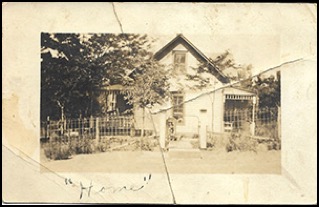
In much homework, I did come across this photo of Gram's that is of a house and she wrote "Home" on it. Which of her homes there, as a Masden girl, or a Lansberry wife I cannot tell.

Vikings in America
25/09/20 06:21
We know through an archeological dig on the northern tip of Newfoundland that the Vikings had a settlement in North America. How far did they travel in the Western Hemisphere? Could it have reached as far as Central America?
"The most credible claim – that the Vikings reached North America around the year 1000 – deserves more attention. It arose in the 19th century, following the publication of C C Rafn’s Antiquitates Americanae (1837), which proposed that the place the Icelandic sagas called Vinland (meaning ‘vine land&rsquo was located somewhere near Cape Cod in Massachusetts, or the islands of Nantucket and Martha’s Vineyard. (The Vinland Sagas refers to two different orally transmitted sagas about these early voyages: Erik the Red’s saga was written down shortly after 1264, and the Greenlanders’ saga was copied into a collection of different materials in 1387.)"
was located somewhere near Cape Cod in Massachusetts, or the islands of Nantucket and Martha’s Vineyard. (The Vinland Sagas refers to two different orally transmitted sagas about these early voyages: Erik the Red’s saga was written down shortly after 1264, and the Greenlanders’ saga was copied into a collection of different materials in 1387.)"
More information can be found here.
"The most credible claim – that the Vikings reached North America around the year 1000 – deserves more attention. It arose in the 19th century, following the publication of C C Rafn’s Antiquitates Americanae (1837), which proposed that the place the Icelandic sagas called Vinland (meaning ‘vine land&rsquo
More information can be found here.
Viking DNA Shows Diversity
24/09/20 06:13
In a recent article and using modern Science, researchers are finding that not all Vikings were Scandanavian. The genetic picture is more complex than expected.
"The so-called Viking Age begins with the earliest record of a Viking raid, dated to 800 A.D. The age lasted through the 1050s. During that time, Vikings raided monasteries and coastal cities, but also engaged in less violent activities, trading fur, tusks and seal fat.
Researchers knew the Vikings altered the political and economic landscape of Europe. In the 11th century, a Viking, Cnut the Great, ascended to the thrown of the North Sea Empire, comprising Denmark, England and Norway. But until now, researchers weren't really sure what the Vikings looked like, genetically speaking."
One can learn more about this research here.
"The so-called Viking Age begins with the earliest record of a Viking raid, dated to 800 A.D. The age lasted through the 1050s. During that time, Vikings raided monasteries and coastal cities, but also engaged in less violent activities, trading fur, tusks and seal fat.
Researchers knew the Vikings altered the political and economic landscape of Europe. In the 11th century, a Viking, Cnut the Great, ascended to the thrown of the North Sea Empire, comprising Denmark, England and Norway. But until now, researchers weren't really sure what the Vikings looked like, genetically speaking."
One can learn more about this research here.
Wyatt Earp
05/09/20 06:48
One movie I enjoy watching over and over is Tombstone. The lead is Kurt Russell yet the star of the show is Val Kilmer as Doc Holliday. It was an acting virtuoso performance. Kurt Russell though portrayed Wyatt Earp who was a character in his own right.
Here is a review of two books outlining Wyatt Earp's life.
Here is a review of two books outlining Wyatt Earp's life.
<
He’s been portrayed by more actors than any American president — Walter Huston, Henry Fonda, Burt Lancaster, Hugh O’Brian, James Stewart, James Garner, Kurt Russell, and Kevin Costner, to name just a few. But the only years Hollywood has taken notice of are those spent in the cow towns of Wichita and Dodge City, Kansas, and the silver mining camp, Tombstone, Arizona. What happened over that brief span has engendered enough books to fill a small library.
The theme song for the 1950s Wyatt Earp TV series declared: "Long may his story be told.".>>
Shakespeare's Richards
31/07/20 10:07
Shakespeare is the greatest author of all time IMO. The history and politics behind Richard II and Richard III almost a century apart is a fascinating study. This article is an interesting look at the two plays, the two people and what they more likely would be if truly known and not so much caricatures.
"The Richard of Richard III is often regarded as a caricature, a cardboard-cutout villain rather like the Sweeney Todd of Victorian melodrama. But he is far more: in fact, he is a fascinating figure, from a psychological point of view."
"The Richard of Richard III is often regarded as a caricature, a cardboard-cutout villain rather like the Sweeney Todd of Victorian melodrama. But he is far more: in fact, he is a fascinating figure, from a psychological point of view."
Entebbe Hijackers
29/07/20 07:49
One of the most gripping stories from the last or 20th Century was the amazing rescue of hostages taken by terrorists when an Israeli plane was hijacked and taken to Entebbe, Uganda. It was an amazing rescue with a small loss of life that I am not sure would be done in this day and age. Few would have the courage and take the risks now.
Here is a description of the hijacking and rescue with a focus on who were the hijackers. L'Audace.
Here is a description of the hijacking and rescue with a focus on who were the hijackers. L'Audace.
Smallpox Vaccine Strains
23/07/20 08:19
I came across an interesting story. Smallpox was one of the disease scourges of history. It is now conquered from the world and probably found in Level IV deadly pathogen labs. We began to conquer the disease when Edward Jenner developed an inoculation technique by using milder cowpox to infect people to develop immunity. Queen Elizabeth I is believed to have had smallpox in her earlier girlhood years. Just think of how history would have changed if she had succumbed.
Back to the story where scientists have determined the smallpox strains used to vaccinate Civil War soldiers. The story is here.
Back to the story where scientists have determined the smallpox strains used to vaccinate Civil War soldiers. The story is here.
Battle of Saratoga
09/07/20 11:18
How did the smaller Continental Army win crucial battles against a larger (often) and more disciplined British Army during the Revolutionary War. One of those crucial battles was the Battle of Saratoga (New York). Here is a short summary about the battle and why it was significant - plus who was involved.
Life in Ancient Rome
30/06/20 07:01
I suppose this would be something that doesn't stick in the average person's mind on a summer day. Well, if we had a summer day which much of June is like Juneuary this year (blah!!).
Someone did post recently what living in Rome was like for Roman citizens. They lived in high rise apartment type buildings and living on the top floor was not cool, in more ways than one.
"Most Romans lived in tall (up to 100 feet), rectangular apartment buildings called insula, meaning "island." Rome was crammed with these buildings, which were spaced very closely together, creating a labyrinth-esque network of narrow alleys.
These buildings were built so close together that one man wrote that he and the man in the apartment across from him could stretch their arms out and shake hands from their windows. And unlike today, the worst apartments were on the top floor, where it was darker, more cramped, and less safe. If the building burned, you'd need to haul it down those stairs. Richer citizens lived on the bottom floors.
There was no running water or sanitation in the insulae. Poorer folk had to rent apartments with several other roommates, who were day laborers, so the places stunk. It also was not uncommon to hear the agony of childbirth if your neighbor was a pregnant woman, as women gave birth at home in Rome.
And the buildings were cheap, so the insulation was terrible."
More details here.
Someone did post recently what living in Rome was like for Roman citizens. They lived in high rise apartment type buildings and living on the top floor was not cool, in more ways than one.
"Most Romans lived in tall (up to 100 feet), rectangular apartment buildings called insula, meaning "island." Rome was crammed with these buildings, which were spaced very closely together, creating a labyrinth-esque network of narrow alleys.
These buildings were built so close together that one man wrote that he and the man in the apartment across from him could stretch their arms out and shake hands from their windows. And unlike today, the worst apartments were on the top floor, where it was darker, more cramped, and less safe. If the building burned, you'd need to haul it down those stairs. Richer citizens lived on the bottom floors.
There was no running water or sanitation in the insulae. Poorer folk had to rent apartments with several other roommates, who were day laborers, so the places stunk. It also was not uncommon to hear the agony of childbirth if your neighbor was a pregnant woman, as women gave birth at home in Rome.
And the buildings were cheap, so the insulation was terrible."
More details here.
Grant Moves Now
29/05/20 07:24
Earlier this week The History Channel had a 3-night, 2-hour TV program on Ulysses S. Grant. It was quite well done with a mix of re-enactments and commentary by current military figures and cultural historians. It laid out the Civil War battle strategies well to where they were understood. Grant has always been Misunderestimated as a figure in history. Much has been covered and yet much needs still to be learned.
I have written on this blog previously about having a leather bound set of The Personal Memoirs of U. S. Grant. I likely have 4-5 other books on Grant in our library. The books pictured following are the set of Memoirs that I have inherited.

I have written on this blog previously about having a leather bound set of The Personal Memoirs of U. S. Grant. I likely have 4-5 other books on Grant in our library. The books pictured following are the set of Memoirs that I have inherited.

Kipling and the first World War
24/05/20 07:07
Rudyard Kipling is a famous figure in English Literature and part of English history and culture during the early 20th Century. He gave an ultimate sacrifice with the loss of his son in the Battle of Loos during World War I. So many gave the ultimate and in so many ways, unnecessarily.
Kipling and his wife went after the war to visit the battlefield hoping to find their son's body or to hear more of the story around his death. It is hard to say if they got comfort by doing this.
Here is an article about this and how this episode relates to the current pandemic.
Kipling and his wife went after the war to visit the battlefield hoping to find their son's body or to hear more of the story around his death. It is hard to say if they got comfort by doing this.
Here is an article about this and how this episode relates to the current pandemic.
Various Shakespeare
30/04/20 13:53
I mentioned Blackadder insults a few days ago. Now it is to get more highbrow with Shakespearean insults.
"When Hamlet refers to mankind as the “quintessence of dust” he acknowledges that while we are human, we are also just dust."
If you want to be insulted more, just check out this story of the best Shakespearean insults here.
At the same time, one can get some good online source information on Shakespeare. This is a piece of analysis on lectures given by Paul Cantor at the University of Virginia. This sounds interesting and well worth checking out! Go here.
"When Hamlet refers to mankind as the “quintessence of dust” he acknowledges that while we are human, we are also just dust."
If you want to be insulted more, just check out this story of the best Shakespearean insults here.
At the same time, one can get some good online source information on Shakespeare. This is a piece of analysis on lectures given by Paul Cantor at the University of Virginia. This sounds interesting and well worth checking out! Go here.
Finding Shackleton's Lost Ship
29/04/20 11:14
In the early 1900s, many explorers planned and executed expeditions to find unexplored parts of the globe. From the Arctic or Antarctic Seas to the deepest jungles of Central and South America. One expedition that made the history books and legends was the one of the Antarctic by Ernest Shackleton. His ship, Endurance, went down and was lost in the Weddell Sea in 1915. He and his men hiked out across the snow and ice on the continent after their ship was lost. They have not been able to find the lost ship though they are trying. The story of this effort is found in National Geographic here.
Dubrovnik the Ancient city
25/04/20 19:11
During the mid to late 1300s, the Black Death as a plague raged around the world and into Europe. Venice was one city that was a port of entry for the disease. In fact, the word quarantine is rooted in Italian.
"The word “quarantine” has Italian roots: in an effort to protect coastal cities from the Black Death ravaging 14th-Century Europe, ships arriving in Venice from infected ports were required to sit at anchor for 40 days (quaranta giorni) before landing, a practice that eventually became known as quarantine – derived from ‘quarantino’, the Italian word for a 40-day period."
In addition, across the Adriatic Sea, the early city of Ragusa (later Dubrovnik) passed a law preventing ships and trade caravans from entering the city until they submitted to 30 days of isolation.
More about these quarantine medieval cities here.
"The word “quarantine” has Italian roots: in an effort to protect coastal cities from the Black Death ravaging 14th-Century Europe, ships arriving in Venice from infected ports were required to sit at anchor for 40 days (quaranta giorni) before landing, a practice that eventually became known as quarantine – derived from ‘quarantino’, the Italian word for a 40-day period."
In addition, across the Adriatic Sea, the early city of Ragusa (later Dubrovnik) passed a law preventing ships and trade caravans from entering the city until they submitted to 30 days of isolation.
More about these quarantine medieval cities here.
Earlier Epidemics in History
24/04/20 06:33
Was our nation's capital planned to be another city other than the Washington, DC area? What may have happened to make that change? Could it have been an unforeseen epidemic?
Was the potential capitol Philadelphia which was the business and cultural center of the new nation made up of states (or former colonies). It appears that Philadelphia was hit with a significant epidemic of yellow fever in the year 1793 which devastated and changed the city. While DC was likely going to be the capitol location, Philadelphia was still being considered. No longer - after this epidemic. The tiny mosquito knocked down this big city's plans and reputation. Hard to believe this could happen and Yellow Fever was not understood as far as cause and pathogenesis until a century later at the time of the Spanish-American War. Much like how history changed in the eastern Roman world if you read Justinian's Flea about the onset of the plague.
Read more about this epidemic here.
Was the potential capitol Philadelphia which was the business and cultural center of the new nation made up of states (or former colonies). It appears that Philadelphia was hit with a significant epidemic of yellow fever in the year 1793 which devastated and changed the city. While DC was likely going to be the capitol location, Philadelphia was still being considered. No longer - after this epidemic. The tiny mosquito knocked down this big city's plans and reputation. Hard to believe this could happen and Yellow Fever was not understood as far as cause and pathogenesis until a century later at the time of the Spanish-American War. Much like how history changed in the eastern Roman world if you read Justinian's Flea about the onset of the plague.
Read more about this epidemic here.
Blood Red Century
03/12/17 11:27
The New York Times believes they think and speak for all of us or how we should think. Not me. I am too much of a history buff and have read of what the Soviet regime was like under Lenin and Stalin. It cannot be swept under the rug as soft socialism and romantic.
Here is one article about what the Blood Red Century was really like.
Here is one article about what the Blood Red Century was really like.
Caesar in Britain
02/12/17 11:22
It is hard to believe that archeologists just found the evidence of the first Roman invasion by Julius Caesar. History is coming to life!
"The first Roman invasion of Britain by Julius Caesar in 55BC is a historical fact, with vivid accounts passed down by Tacitus, Cicero and Caesar himself.
Yet, despite a huge landing force of legionaries from 800 ships, no archaeological evidence for the attack or any physical remains of encampments have ever been found."
Here at the link.
"The first Roman invasion of Britain by Julius Caesar in 55BC is a historical fact, with vivid accounts passed down by Tacitus, Cicero and Caesar himself.
Yet, despite a huge landing force of legionaries from 800 ships, no archaeological evidence for the attack or any physical remains of encampments have ever been found."
Here at the link.
The Esmeralda, Lost and Found
04/02/17 13:48
Vasco de Gama was one of the great explorers during the Age of Discovery, looking for trade routes to India and other parts of the world. On one of his voyages, his uncle broke off with 5 ships to attack Arab ships to plunder. One was the Esmeralda which sank losing all on board. Parts of the ship have been found off the coast of Oman. More can be found here.
More Battle of the Bulge
03/02/17 13:44
The internet seems to be putting out more photos and information around the Battle of the Bulge from World War II. This article explains why it was Hitler's last hoorah and the stake through his heart.
The Lost Kingdom of Rheged
02/02/17 13:40
History refound? Archeologists may have found the lost kingdom of Rheged, an elusive kingdom from the 6th century of Dark Age Britain. More here.
"The mysterious kingdom was pre-eminent in northern Britain in the sixth century, but faded into obscurity after it was deliberately destroyed in the beginning of the following century.
Historians had speculated that the kingdom was headquartered in Cumbria, a county in north west England, but no evidence of it was ever found. Then digs carried in 2012 at Trusty's Hill, which overlooks the Fleet valley in Galloway in south-west Scotland, revealed clues of the presence of a royal stronghold."
"The mysterious kingdom was pre-eminent in northern Britain in the sixth century, but faded into obscurity after it was deliberately destroyed in the beginning of the following century.
Historians had speculated that the kingdom was headquartered in Cumbria, a county in north west England, but no evidence of it was ever found. Then digs carried in 2012 at Trusty's Hill, which overlooks the Fleet valley in Galloway in south-west Scotland, revealed clues of the presence of a royal stronghold."
Victoria and Albert
25/01/17 17:17
The Masterpiece TV series on Queen Victoria is going on currently. This link shows the progeny and grandchildren of Victoria.
"Albert's nine children and 26 of their 34 grandchildren, who survived childhood, married into royal and noble families across the continent, tying them together and earning her the nickname "the grandmother of Europe".
Victoria's reign of 63 years and 7 months, which is longer than that of any other British monarch and the longest of any female monarch in history, is known as the Victorian era. It was a period of industrial, cultural, political, scientific, and military change within the United Kingdom, and was marked by a great expansion of the British Empire. She was the last British monarch of the House of Hanover; her son and successor Edward VII belonged to the House of Saxe-Coburg and Gotha."
"Albert's nine children and 26 of their 34 grandchildren, who survived childhood, married into royal and noble families across the continent, tying them together and earning her the nickname "the grandmother of Europe".
Victoria's reign of 63 years and 7 months, which is longer than that of any other British monarch and the longest of any female monarch in history, is known as the Victorian era. It was a period of industrial, cultural, political, scientific, and military change within the United Kingdom, and was marked by a great expansion of the British Empire. She was the last British monarch of the House of Hanover; her son and successor Edward VII belonged to the House of Saxe-Coburg and Gotha."
1901 World's Fair
23/01/17 17:08
The World's Fair that was part of the book, Devil in the White City, is pretty well known in history. Details about the 1901 World's Fair is less known but it is where President McKinley was shot and he died several days later as the result of the bullet remaining in his abdomen. More details can be found in this article.
Grave of John Wilkes Booth
19/01/17 10:27
John Wilkes Booth is infamous in history for his assassination of Abraham Lincoln. After a large manhunt through Maryland and Virginia, he was cornered and killed. He was eventually buried in the family plot located in Baltimore. More found here with pictures of the gravesite.
"The assassin’s body was transported to Baltimore, the city of his youth, and buried in the Booth family plot in Green Mount Cemetery. The family plot is easy to find due to Junius Brutus Booth’s towering obelisk. But the Booth family, John Wilkes’ brother Edwin in particular, believed that an elaborate headstone for John Wilkes might attract unwanted attention and vandalism. Visitors today believe the small, plain, unmarked headstone denotes John Wilkes Booth’s final resting spot. In lieu of flowers or stones, people leave pennies behind on the headstone, as if to give Lincoln the final word."
"The assassin’s body was transported to Baltimore, the city of his youth, and buried in the Booth family plot in Green Mount Cemetery. The family plot is easy to find due to Junius Brutus Booth’s towering obelisk. But the Booth family, John Wilkes’ brother Edwin in particular, believed that an elaborate headstone for John Wilkes might attract unwanted attention and vandalism. Visitors today believe the small, plain, unmarked headstone denotes John Wilkes Booth’s final resting spot. In lieu of flowers or stones, people leave pennies behind on the headstone, as if to give Lincoln the final word."
Elizabeth I Clothing Found
10/01/17 12:06
A skirt of Elizabeth I, Queen of England, has been found as being part of an altar skirt in a church in England. The is the only piece of clothing of hers that seems to remain from that time. When we were going through the Tower Of London's museum on a tour, we were told that much of the monarchy's belongings were lost, destroyed or given away during Cromwell's time. Such may be the case here.
Read about this find here.
Read about this find here.
America and Shakespeare
09/01/17 12:22
What is it about America that we love and some (idiots) hate Shakespeare? We certainly do perform his plays and often many variations of it. I loved watching OPB's Great Performances of Henry VI Parts I and II followed by Richard III. It was great TV.
Read more about Shakespeare and his impact on Americans.
Read more about Shakespeare and his impact on Americans.
Digitally Archiving Union Telegrams
02/10/16 16:31
Work is being done to bring thousands of telegrams from the Union side of the Civil War into the digital age. More about the work here.
<<Today we use our digital devices to text, tweet, and email, but during the Civil War, telegrams were deployed to do things like request artillery or even to say “We have met with a serious disaster.” Now, a new project is bringing thousands of telegrams that carried information between Union officers, Abraham Lincoln, and his cabinet into the digital age.>>
<<Today we use our digital devices to text, tweet, and email, but during the Civil War, telegrams were deployed to do things like request artillery or even to say “We have met with a serious disaster.” Now, a new project is bringing thousands of telegrams that carried information between Union officers, Abraham Lincoln, and his cabinet into the digital age.>>
President Garfield
25/09/16 15:26
One historian and author has written a book on the premise that President Garfield was not assassinated so much as killed by medical ineptness and malpractice. His doctor was more a poor practitioner and a charlatan. This story is fascinating but sad because it sounds like he may not have had to die. Alexander Graham Bell had devised an invention to find metal such as bullets when hard to locate in the body (no radiographs in those days). The doctor did not follow Bell's instructions and essentially sabotaged the use of the invention.
The Soviet LifeStyle
03/09/16 08:51
Bob and I have a number of history books about Russia and the period of communism as the Soviet Union. One knows of the horror of communism as it was put upon the Russian people if you delve into it. Sadly the horrors of Nazi Germany and Hitler are taught more with the horrors of Stalin is glossed over. The books of Robert Conquest of "The Great Terror" and "Harvest of Sorrow" will set you correct. The detail is horrifying to say the least. This article goes on to summarize the worst of totalitarianism.
"Ninety-nine years ago, Tsar Nicholas II abdicated, and, after a few months of weak parliamentary rule, the Bolsheviks seized power. We call that seizure the Russian (or October) Revolution, but it might better be designated the Bolshevik coup d’état. A party of 10,000 people gained control of an empire occupying one-sixth of the earth’s land area.
From the start, they made up for their small numbers with outsized violence. If at first their executions of liberals, socialists, workers who showed independence, and peasants from whom grain was seized at gunpoint seemed like a short-term necessity, it soon became evident that the violence would never stop. In fact, it was to grow, with Stalin proclaiming “the intensification of the class struggle” when Bolshevik control had long been total."
"Ninety-nine years ago, Tsar Nicholas II abdicated, and, after a few months of weak parliamentary rule, the Bolsheviks seized power. We call that seizure the Russian (or October) Revolution, but it might better be designated the Bolshevik coup d’état. A party of 10,000 people gained control of an empire occupying one-sixth of the earth’s land area.
From the start, they made up for their small numbers with outsized violence. If at first their executions of liberals, socialists, workers who showed independence, and peasants from whom grain was seized at gunpoint seemed like a short-term necessity, it soon became evident that the violence would never stop. In fact, it was to grow, with Stalin proclaiming “the intensification of the class struggle” when Bolshevik control had long been total."
Pompeii
29/08/16 09:22
Sunken Aircraft Carrier
23/08/16 08:15
What does a sunken aircraft carrier look like in the depths of the ocean? Mighty or not mighty in appearance? The carrier, the USS Independence, of Jaws movie fame came into being in World War II. It was sunk purposefully in the 1950s. Now they are exploring the vessel deep in the ocean to gather its secrets. More here.
"The USS Independence joined the Pacific Fleet in 1943, participating in several raids on Japanese installations before encountering the business end of a torpedo. After a patch-up, it returned to fighting for the remainder of WWII, before encountering the business end of two nuclear bombs".
"The USS Independence joined the Pacific Fleet in 1943, participating in several raids on Japanese installations before encountering the business end of a torpedo. After a patch-up, it returned to fighting for the remainder of WWII, before encountering the business end of two nuclear bombs".
Unconquered by Rome
20/08/16 11:49
So what was so tough about Scotland. Why was it hard to hold and conquer Scotland when they managed to do so with England and France. Rome lasted only 80 years as conqueror north of Hadrian's Wall. A description of their troubles can be found in this article.
Radiation Effects
19/08/16 11:41
The Iceman Cometh
12/08/16 11:37
You want to see what your ancestors wore in their fashion days. Look here.
"The Iceman was recovered back in 1991 with a full assortment of clothing, including a hide coat, skin leggings, fur hat, and hay-stuffed shoes. Due to the decomposition of the leather and fur over thousands of years, however, researchers have been unable to conclusively pinpoint specific animal species for some of the components of Ötzi's wardrobe."
"The Iceman was recovered back in 1991 with a full assortment of clothing, including a hide coat, skin leggings, fur hat, and hay-stuffed shoes. Due to the decomposition of the leather and fur over thousands of years, however, researchers have been unable to conclusively pinpoint specific animal species for some of the components of Ötzi's wardrobe."
A New Human Ancestor
10/08/16 11:32
A new human ancestor has been discovered. More about it here.
"This species, called Homo naledi, is the largest discovery of hominin fossils in Africa. So far, over 1,500 fossils have been found, and at least 15 individuals identified. This is the largest discovery of a single hominin species in ever found in Africa. H. naledi contains a mixture of ape-like characteristics, including a small brain, mixed in with more modern, human-like traits."
"This species, called Homo naledi, is the largest discovery of hominin fossils in Africa. So far, over 1,500 fossils have been found, and at least 15 individuals identified. This is the largest discovery of a single hominin species in ever found in Africa. H. naledi contains a mixture of ape-like characteristics, including a small brain, mixed in with more modern, human-like traits."
Mary Todd Lincoln and Her Mental State
13/07/16 11:33
History has considered that Mary Todd Lincoln, wife of Abraham Lincoln, had many strange and difficult behaviors. There has not been one accepted theory of what may be the underlying cause of these behaviors. It has been said this was a trial to Lincoln in his life to deal with her problems.
One physician, a cardiologist, suggests that Mary Todd Lincoln may have had pernicious anemia due to a Vitamin B12 deficiency and this could have been a possibly inherited condition.
Read more about this theory and why Dr. Sotos believes in his theory.
One physician, a cardiologist, suggests that Mary Todd Lincoln may have had pernicious anemia due to a Vitamin B12 deficiency and this could have been a possibly inherited condition.
Read more about this theory and why Dr. Sotos believes in his theory.
The Biblical Philistines
12/07/16 11:28
The Somme
10/07/16 11:15
It is almost a century later after the Battle of the Somme. Unbelievably, the loss of life for the British and the French was staggering at 1.2 million lives. That is inconceivable. More here.
"The observation that one death is a “catastrophe,” one hundred thousand deaths a “statistic,” is both callous and flippant. But it carries with it some truth. How do we begin to conceptualize death on the Great War’s scale? In England, the chosen medium is ceramic poppies, which have been laid before the Tower of London en masse. On August 5, when this memorial was inaugurated, just 120,000 were in place — still enough to encircle the building. By November 11, there will be 888,246 — one for each British or Commonwealth soldier who died abroad. The installation has a fitting, if macabre, title: “Blood Swept Lands and Seas of Red.” "
"The observation that one death is a “catastrophe,” one hundred thousand deaths a “statistic,” is both callous and flippant. But it carries with it some truth. How do we begin to conceptualize death on the Great War’s scale? In England, the chosen medium is ceramic poppies, which have been laid before the Tower of London en masse. On August 5, when this memorial was inaugurated, just 120,000 were in place — still enough to encircle the building. By November 11, there will be 888,246 — one for each British or Commonwealth soldier who died abroad. The installation has a fitting, if macabre, title: “Blood Swept Lands and Seas of Red.” "
Ancient Naval Base
23/06/16 11:00
Archeologists have found evidence of ship sheds off the coast of Greece that may have held ships that fought the Persians in the Battle of Salamis (one of the greatest battles of all time). More detail about the finding is here.
"Although the Greeks were outnumbered, they won the battle, which took place in the straits between the Greek mainland and the island of Salamis.
"This naval battle was a pivotal event in Greek history; it is difficult to predict what would have happened if the Greek fleet had lost at Salamis, but it is clear that a Persian victory would have had immense consequences for subsequent cultural and social developments in Europe,” said Loven. “The victory at Salamis rightly echoes through history and awakens awe and inspiration around the world today." "
"Although the Greeks were outnumbered, they won the battle, which took place in the straits between the Greek mainland and the island of Salamis.
"This naval battle was a pivotal event in Greek history; it is difficult to predict what would have happened if the Greek fleet had lost at Salamis, but it is clear that a Persian victory would have had immense consequences for subsequent cultural and social developments in Europe,” said Loven. “The victory at Salamis rightly echoes through history and awakens awe and inspiration around the world today." "
Early Terror Weapons
16/06/16 07:57
Having a surprise edge in battle or war can be the key to victory. They have found that the Romans had "whistling" sling bullets they used to terrorize their barbarian foe. More about it here.
"Some 1,800 years ago, Roman troops used "whistling" sling bullets as a "terror weapon" against their barbarian foes, according to archaeologists who found the cast lead bullets at a site in Scotland.
Weighing about 1 ounce, each of the bullets had been drilled with a 0.2-inch hole that the researchers think was designed to give the soaring bullets a sharp buzzing or whistling noise in flight.
The bullets were found recently at Burnswark Hill in southwestern Scotland, where a massive Roman attack against native defenders in a hilltop fort took place in the second century A.D."
"Some 1,800 years ago, Roman troops used "whistling" sling bullets as a "terror weapon" against their barbarian foes, according to archaeologists who found the cast lead bullets at a site in Scotland.
Weighing about 1 ounce, each of the bullets had been drilled with a 0.2-inch hole that the researchers think was designed to give the soaring bullets a sharp buzzing or whistling noise in flight.
The bullets were found recently at Burnswark Hill in southwestern Scotland, where a massive Roman attack against native defenders in a hilltop fort took place in the second century A.D."
The Mongols
29/05/16 08:58
Scientists may now know what stopped the Mongol horde from taking over Europe…it rained too much and this affected the crops to feed their war horses. Ghengis Khan did have a foe and one he could not defeat.
"In 1206, Genghis Khan, a fierce tribal chieftain from northern Mongolia, began to take over the world. The khan’s ruthless tactics and loyal horde swept across Asia.
One territory after another fell under the overwhelming force of the Mongol Empire, which would eventually stretch from the eastern shores of China. A series of successful forays in Hungary and Poland made even Europe seem within reach of conquering.
But this unstoppable wave of victories in Europe suddenly ended. Almost as soon as the Mongols set their sights set on Austria, they abruptly returned to Asia."
"In 1206, Genghis Khan, a fierce tribal chieftain from northern Mongolia, began to take over the world. The khan’s ruthless tactics and loyal horde swept across Asia.
One territory after another fell under the overwhelming force of the Mongol Empire, which would eventually stretch from the eastern shores of China. A series of successful forays in Hungary and Poland made even Europe seem within reach of conquering.
But this unstoppable wave of victories in Europe suddenly ended. Almost as soon as the Mongols set their sights set on Austria, they abruptly returned to Asia."
Antiquities
23/05/16 11:57
The British Museum in London is displaying some ancient statues that are the sunken cities of Egypt. A world lost to us until found in recent years. The British Museum is amazing. We just spent part of a day there and it would require many more days.
The Greatest Documentary
17/05/16 15:43
The Amerikans
11/05/16 15:25
I have watched the TV show, The Amerikans, on FX since it started. The concept is a deep cover family, parents came over from Russia and are very American like spies for the Soviet Union in the 1980s. Their children do not know they are spies and they assume they are a normal American family.
I came across this story of a family of much similar circumstances. The parents were deep cover spies for Russia and the children did not know of the deception until the FBI arrested the parents. Now the sons must live in Europe and wish to be able to return to the U.S. Read the story.
I came across this story of a family of much similar circumstances. The parents were deep cover spies for Russia and the children did not know of the deception until the FBI arrested the parents. Now the sons must live in Europe and wish to be able to return to the U.S. Read the story.
Holocaust Liberation
02/05/16 12:17
A beautiful photo and story about the liberation of some Holocaust survivors. I imagine it was an incredibly liberating experience to see someone coming to their rescue after being on the edge of death for so long.
Archeology
29/04/16 12:22
Alexander Hamilton
28/04/16 16:40
Bob has spoken highly over time of the Ron Chernow biography of Alexander Hamilton. He thoroughly enjoyed this book. I could not get through it, more a timing issue, not enough time I am afraid. Now Hamilton has been redeemed to some respect through a Pulitzer winning Broadway play of that name. This article talks about the play and book. How cool is this information!
Vikings, A Trip
27/04/16 16:36
I like to watch the TV series on the History Channel called Vikings. I have been to Norway and have visited the Viking museum. We have seen Viking ships that have been restored. They are not large. It is hard to believe they crossed the Atlantic in them but they did. They are now going to cross the Atlantic in a Viking ship again. The story of the voyage is found here.
JFK, Another Assassination Attempt?
26/04/16 14:56
Did JFK's assassination in Dallas, TX possibly followed an attempt in Springfield, IL that was a bit of a premonition for Dallas? JFK and the Secret Service were not careful with checking his route and keeping him protected in a car with a bubble shield. I knew had heard of this so it is an interesting piece of news and trivia.
More Archeology
23/04/16 14:44
A Roman Villa
22/04/16 13:32
Rome included the British Isles in the large mass of territory they conquered and ruled over. Caesar never stopped or it seemed like he didn't. They have recently found one of the largest villas under a home in Wiltshire England. More on it here.
"It is thought the villa, which had around 20 to 25 rooms on the ground floor alone, was built sometime between 175 AD and 220 AD, and was repeatedly re-modelled right up until the mid - 4th century."
"It is thought the villa, which had around 20 to 25 rooms on the ground floor alone, was built sometime between 175 AD and 220 AD, and was repeatedly re-modelled right up until the mid - 4th century."
Fort Hoskins
19/04/16 13:11
As we drove up the valley toward Kings Valley we saw signs directing us a short distance on another road to Fort Hoskins historical park. I had not heard of it. It was a spot where a small army fort was located in the mid-1800s to over see the Kalapuya and Luckiamute natives. There were at one time about 200-300 soldiers located there. It is a pretty area overlooking the river valley. Lots of blooming apple trees around. One homestead is still there.


Witness to the Assassination
12/04/16 13:30
The ability to look at old TV and movie archives is one of the benefits of living in this day and age. It was really fascinating to come across this clip from 1956 from the TV show, "I've Got A Secret". The link on YouTube was removed but the current link evaluated the story that was covered on the TV show. He had an elderly man who was the last witness to the assassination of Abraham Lincoln at Ford Theatre in Washington DC. Just amazing to see this testimony and also how well the panelists got to the point of knowing his secret.
Lost Ancient Ancestors
05/03/16 15:45
Some of our ancient ancestors from Europe vanished and were replaced overall by others. Why did this happen?
"The genetic turnover was likely the result of a rapidly changing climate, which the earlier inhabitants of Europe couldn't adapt to quickly enough, said the study's co-author, Cosimo Posth, an archaeogenetics doctoral candidate at the University of Tübingen in Germany.
The temperature change around that time was "enormous compared to the climactic changes that are happening in our century," Posth told Live Science. "You have to imagine that also the environment changed pretty drastically.""
"The genetic turnover was likely the result of a rapidly changing climate, which the earlier inhabitants of Europe couldn't adapt to quickly enough, said the study's co-author, Cosimo Posth, an archaeogenetics doctoral candidate at the University of Tübingen in Germany.
The temperature change around that time was "enormous compared to the climactic changes that are happening in our century," Posth told Live Science. "You have to imagine that also the environment changed pretty drastically.""
A Lost Spanish Settle
26/02/16 12:38
George Washington
22/02/16 08:20
Today is George Washington's birthday. He is the epitome of a great man. I think the greatest thing he did was stepping aside for the natural progression of a presidency for the country in its infancy instead of becoming a reigning monarch as some would have made him. I cannot see many recent Presidents acting this way, especially Barack Obama. Power and money means too much for the oligarchy now. Here is an article on Powerline celebrating our first President.
Enemy of the State
17/02/16 08:44
Too many people are flirting with the thought of socialism (democratic or not). They have not read history. They have not read how the Soviet Union turned people into enemies of the state without them realizing why they were considered so. Often these people were convinced or made to be convinced they were guilty. Here is a description of how the NKVD operated in the 1930s of the Soviet Union. Read and weep.
President's Day
15/02/16 14:50
While I can like and admire Thomas Jefferson for his intellect and a number of the things he did for this nation, he has been reported as a not so good friend, more the back stabber even. He and John Adams were good friends and became estranged for many years. Now I read about how he tried to "take down" George Washington through the use of Washington's friendship with Alexander Hamilton. Good that it didn't succeed. We can see currently how mean-spirited and not in the best interests of our American spirit politics can be. This is an interesting post about the subject.
Lincoln's Birthday
12/02/16 14:42
Since I like Abraham Lincoln, I like to post any remembrances of his great speeches and works. This article is a lovely tribute found on Powerline to one of the greatest and bravest men every known.
The French Resistance
11/02/16 14:38
There has always been a mix of romance and controversy surrounding the French Resistance movement from World War II. Now there are two books out about this part of our more recent history. Read about it in the NYRB.
The Rhodes
10/02/16 14:33
Well, I have not been to Africa. I have not visited South Africa nor Zimbabwe. I do remember when there was a Rhodesia. I can also say that I have met a large number of people living in the UK who used to live in South Africa and Rhodesia who returned to the mother country. A bit of understanding of Cecil Rhodes and his influence on southern Africa and how it reflects in current affairs along with the Rhodes Scholarship, please read this article from New Criterion.
Vikings and Navigation
05/02/16 06:40
So did the Vikings use crystal 'sunstones' to discover America? This article discusses the possibility.
"Ancient records tell us that the intrepid Viking seafarers who discovered Iceland, Greenland and eventually North America navigated using landmarks, birds and whales, and little else.
There's little doubt that Viking sailors would also have used the positions of stars at night and the sun during the daytime, and archaeologists have discovered what appears to be a kind of Viking navigational sundial.
But without magnetic compasses, like all ancient sailors they would have struggled to find their way once the clouds came over.
However, there are also several reports in Nordic sagas and other sources of a sólarsteinn 'sunstone'.
The literature doesn't say what this was used for but it has sparked decades of research examining if this might be a reference to a more intriguing form of navigational tool."
"Ancient records tell us that the intrepid Viking seafarers who discovered Iceland, Greenland and eventually North America navigated using landmarks, birds and whales, and little else.
There's little doubt that Viking sailors would also have used the positions of stars at night and the sun during the daytime, and archaeologists have discovered what appears to be a kind of Viking navigational sundial.
But without magnetic compasses, like all ancient sailors they would have struggled to find their way once the clouds came over.
However, there are also several reports in Nordic sagas and other sources of a sólarsteinn 'sunstone'.
The literature doesn't say what this was used for but it has sparked decades of research examining if this might be a reference to a more intriguing form of navigational tool."
The Forgotten Genocide
29/01/16 06:17
One book that has stuck with me in its telling is "The Burning Tigris". I purchased "American Golgotha" as a followup though I have not read it yet. The story behind these books is the story that Turkey denies, the Armenian genocide. Christians killed for their faith and difference as a culture in Turkey during the first World War. I came across this article today and if the picture with it alone does not chill your blood, it is hard to say what will. Armenian Christian women crucified during the genocide.
Stalin's Size
14/01/16 15:25
I've posted several blogs about Stalin, a thoroughly evil man. He was short though still taller than me. Maybe he had small man's syndrome. Nope, he was a megalomaniac without that I believe. He did try to hide his small stature and look larger in photos than he was in real life. Check it out.
Other European Ancestors
06/01/16 11:34
Archeology has found a fourth set of ancestors based on DNA results.
"Prior to summer 2015, researchers believed that all Europeans had a shared ancestry stemming from three tribal populations: European hunter-gatherers, early European farmers, and ancient North Eurasians. According to an article published this week in the journal Nature Communications, by studying the genomes of ancient skeletons found in two caves in Western Georgia (Kotias Klde and Satsurblia), geneticists have discovered a fourth group, Caucasus hunter-gatherers, who also contributed DNA to the continent."
Read more of the details here.
"Prior to summer 2015, researchers believed that all Europeans had a shared ancestry stemming from three tribal populations: European hunter-gatherers, early European farmers, and ancient North Eurasians. According to an article published this week in the journal Nature Communications, by studying the genomes of ancient skeletons found in two caves in Western Georgia (Kotias Klde and Satsurblia), geneticists have discovered a fourth group, Caucasus hunter-gatherers, who also contributed DNA to the continent."
Read more of the details here.
Trench Railways
03/01/16 11:20
I came across an interesting article about trench railways from World War I. They were a technologic advance, light rail.
"Sir Eric Geddes spearheaded a revolution in logistics during World War I. But in terms of the railways, perhaps his most radical recommendation was the wholesale adoption of a new kind of technology. Light rail. From 1916, the British-held areas of the Western Front were transformed, as miniature railways began snaking their way across the trenches. In photographs, the dinky tracks and the scaled-down trains that worked them looked more suited to scenic tourist trains than life in the firing line. But what these narrow gauge-railways lacked in size they more than made up for in impact. They extended the railways’ reach all the way to the front line. Providing the struggling Tommies with a vital artery for essential supplies. However, convincing the British Army leadership of their advantages was an uphill struggle."
More of a look here.
"Sir Eric Geddes spearheaded a revolution in logistics during World War I. But in terms of the railways, perhaps his most radical recommendation was the wholesale adoption of a new kind of technology. Light rail. From 1916, the British-held areas of the Western Front were transformed, as miniature railways began snaking their way across the trenches. In photographs, the dinky tracks and the scaled-down trains that worked them looked more suited to scenic tourist trains than life in the firing line. But what these narrow gauge-railways lacked in size they more than made up for in impact. They extended the railways’ reach all the way to the front line. Providing the struggling Tommies with a vital artery for essential supplies. However, convincing the British Army leadership of their advantages was an uphill struggle."
More of a look here.
The Oldest European Settlement in the U.S.
21/12/15 13:41
"We know that St. Augustine (established in 1565) is the oldest existing European community in the U.S. We know Jamestown (1607) is the oldest English community, and although the Roanoke colony was settled earlier, it did not survive. Such was the case of the Luna settlement, a Spanish colony in Florida that was the first multi-year European settlement in what would became the United States. Spanish conquistador Tristán de Luna y Arellano settled his expedition in what is now Pensacola, Florida, in 1559. Stranded by a hurricane that wrecked their ships, the colony lasted until 1561. It’s exact location was lost to history -until now. "
Learn more about this settlement and the discovery here.
Learn more about this settlement and the discovery here.
A Knight's Tale Had Some Truth
17/12/15 13:32
I do like reading about Medieval times. The times of chivalry and knighthood. I also have seen the movie, The Knight's Tale, with Heath Ledger. A bit far fetched but the knight he claimed to be impersonating did really exist. This knight was Ulrich von Liechtenstein. One can read a bit more of this history on my trivia site, Today I Found Out.
The Death of George Washington
16/12/15 06:53
George Washington was a great man and a great servant to this country. We owe him a debt of gratitude to have delivered us our freedom and the United States. I hope we can keep it. I have visited Mount Vernon twice and it was a great experience. Here is a description of the final time of George Washington. Too bad medicine was not more like what we see today. No blood letting allowed.
The Ardennes in 1944
13/12/15 06:34
I have a fair size collection of history books about World War II. One author I also have read and have at least one of his books is Antony Beevor. He has a new book out about the Battle of the Bulge, a significant battle in the month of December in 1944. Watch Band of Brothers as a TV show and one will see. A bit more about the book can be found here.
"Antony Beevor, one of the finest narrative military historians now writing, is a master of revealing vignettes like this one. The Battle of the Bulge, from mid-December 1944 through January 1945, the subject of “Ardennes 1944,” is a known story — Hitler’s last roll of the dice in the West, stripping other fronts (including the East) of prime armored and infantry units to hurl some 30 divisions at the weakly defended American line in the Ardennes forest. It was here that the Germans had dazzlingly shattered French resistance in May 1940, driving tank armies through the forests, defiles and villages of this compact hill country. The hope now was to split the Allied armies, shattering the Americans and driving the British into an evacuation. It was a fantasy: The German military — sorely lacking in fuel; its cadres of experienced sergeants and officers depleted by years of high casualties; short of food and ammunition, let alone the transport to move them; and inferior in the air — could probably not have succeeded. But at the price of around 80,000 casualties on each side, it gave the Americans and British a real scare."
"Antony Beevor, one of the finest narrative military historians now writing, is a master of revealing vignettes like this one. The Battle of the Bulge, from mid-December 1944 through January 1945, the subject of “Ardennes 1944,” is a known story — Hitler’s last roll of the dice in the West, stripping other fronts (including the East) of prime armored and infantry units to hurl some 30 divisions at the weakly defended American line in the Ardennes forest. It was here that the Germans had dazzlingly shattered French resistance in May 1940, driving tank armies through the forests, defiles and villages of this compact hill country. The hope now was to split the Allied armies, shattering the Americans and driving the British into an evacuation. It was a fantasy: The German military — sorely lacking in fuel; its cadres of experienced sergeants and officers depleted by years of high casualties; short of food and ammunition, let alone the transport to move them; and inferior in the air — could probably not have succeeded. But at the price of around 80,000 casualties on each side, it gave the Americans and British a real scare."
Munich, An Earlier Terror
04/12/15 06:56
In 1969, I was lucky to visit Europe while I was still in high school. Our trip took us to Munich where I saw the initial construction of the Olympic sites for the 1972 Olympics. During the Olympics, Palestinian terrorists took Israeli athletes and coaches hostage. The hostages died or were killed. Here is a recent article about newer information released that showed some were severely tortured during their captivity. Sadly, we don't see much changed in terror in this day and age.
Pagan Roman Basilica
23/11/15 06:07
Nuremberg Anniversary
20/11/15 05:49
Seventy years ago today was the start of the Nuremberg Trial of German leaders for war crimes. Here is an interesting article about three men who advocated for the trials and three roads to achieve the end results.
"Much of what we now understand as the Holocaust—the persecution of the German Jews in the 1930s, the evolution of systematic, European-wide mass murder during the Second World War, the number 6 million, ghettoization, the rampages of the Einsatzgruppen, the death camps in Eastern Europe, the uprising of the Warsaw Ghetto—became part of the proceedings of the Nuremberg Trial of 1945-46 thanks in good measure to three Jewish advocates, none of whom was formally part of the prosecution. Each of them was a lawyer; each was an émigré from an Eastern Europe ravaged by the slaughter of Jewish people during the war, and each, in his own way, drew an important conclusion drawn from the catastrophe that his community of origin had undergone."
"Much of what we now understand as the Holocaust—the persecution of the German Jews in the 1930s, the evolution of systematic, European-wide mass murder during the Second World War, the number 6 million, ghettoization, the rampages of the Einsatzgruppen, the death camps in Eastern Europe, the uprising of the Warsaw Ghetto—became part of the proceedings of the Nuremberg Trial of 1945-46 thanks in good measure to three Jewish advocates, none of whom was formally part of the prosecution. Each of them was a lawyer; each was an émigré from an Eastern Europe ravaged by the slaughter of Jewish people during the war, and each, in his own way, drew an important conclusion drawn from the catastrophe that his community of origin had undergone."
Underlying Thoughts to Start of World War I
17/11/15 11:00
There is some interesting underlying history or thoughts of how World War I started. The assassination of Archduke Franz Ferdinand was not that upsetting to be a trigger for war but it was a pretext for Austro-Hungary to draw Serbia into war for land. Due to treaties among various countries, more got drawn into the conflict. There is also some information here about what giving a white feather to a man not in uniform would mean.
"The commonly held notion that WW1 was started out of outrage over the assassination of Archduke Franz Ferdinand of Austria and his wife Sophie at the hands of the Serbian nationalist secret society known as the “Black Hand” isn’t entirely correct. In fact, the Emperor Franz Josef himself expressed relief over the assassination because it rid him of an heir that he deeply disliked. The Emperor commented that “God will not be mocked. A higher power had put back the order I couldn’t maintain.”"
"The commonly held notion that WW1 was started out of outrage over the assassination of Archduke Franz Ferdinand of Austria and his wife Sophie at the hands of the Serbian nationalist secret society known as the “Black Hand” isn’t entirely correct. In fact, the Emperor Franz Josef himself expressed relief over the assassination because it rid him of an heir that he deeply disliked. The Emperor commented that “God will not be mocked. A higher power had put back the order I couldn’t maintain.”"
Battle of Leyte Gulf
23/10/15 16:46
Stalin's Prosecutor
20/10/15 16:28
I have pointed out in other blogs about Robert Conquest and the books he wrote that so thoroughly captured the history of Stalin's rule and damage to the people living under the Soviet Union. Another tribute to a man who brought history to life and did a good thing while doing so.
Magic and the Tower of London
19/10/15 16:27
Were the people who kept the Tower of London running and safe, superstitious? Maybe so. Archeologists have found evidence that they tried to protect themselves against the powers of evil. An interesting story.
"The Tower of London has arguably been England’s premier fortress for almost a thousand years – but new evidence suggests that despite its impressive fortifications, its staff sometimes felt far from secure.
Research carried out by archaeologists in one of the fortresses’ major buildings has revealed that at least some of its inhabitants felt so insecure that they tried to use magic to give themselves an extra layer of protection."
"The Tower of London has arguably been England’s premier fortress for almost a thousand years – but new evidence suggests that despite its impressive fortifications, its staff sometimes felt far from secure.
Research carried out by archaeologists in one of the fortresses’ major buildings has revealed that at least some of its inhabitants felt so insecure that they tried to use magic to give themselves an extra layer of protection."
The USS Constitution
18/10/15 16:19
Along the lines that it is another historical anniversary, it is the United States Navy's 240th anniversary. Six frigates were build to protect our new nation. One of those is the USS Constitution. This frigate has been docked in Boston and they have been working on the appropriate spot to dock her. Bob was able to visit the frigate when we were in Boston in 2012. Here is a lovely photo he took of his visit. Other photos are here.
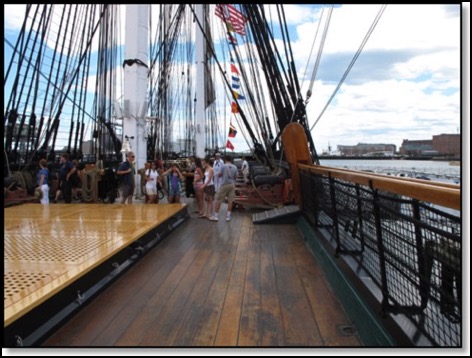

Agincourt - We Band of Brothers
17/10/15 16:13
Being an English history buff and also of the time period of the Plantagenets, I found it very interesting about the reminder that this is the 600th Anniversary of Henry V's victory over the French in Agincourt. To read a bit of background on this battle and Henry, one can go here. Certainly it is worth considering watching Shakespeare's Henry the Vth along with Richard the II and Henry the IVth in plays. Shakespeare could bring back the drama of those medieval times even if likely exaggerated in one direction but still brutal in another.
Yom Kippur War and Gettysburg
22/09/15 19:28
Svetlana's Story
21/09/15 19:32
I am currently reading about Stalin's role in the Soviet Union's Great Terror. He was a horrible, evil man. He loved his daughter though, Svetlana. I remember when she defected to the United States and I read her book, Only One Year, which made her a household name. Jay Nordlinger brings her presence back to life in describing her role as a memoirist for her life and her father's.
Edith Cavell
17/09/15 20:20
Long ago, in a marriage far far away or at least before kids, Bob and I traveled to Canada. We journeyed through British Columbia north and then over to Alberta province. As we came south along the Rocky Mountains, we visited a different sites. One spot had a monument memorialized to Nurse Edith Cavell. She was considered a British hero, a martyr from World War I, shot by the Germans as a spy. Well, now more is known about her activities in Belgium. You can find the current true story here of Edith Cavell. Did she or didn't she?
The Art at Petra
28/08/15 09:04
This was just posted but actually was written for 2010. An interesting summary of how English scholars have restored some ancient wall paintings at the World Heritage site of Petra in Jordan. One much hope that ISIS will not wreak havoc not this country since they are determined much as the Taliban was in destroying evidence of ancient cultures. These cultures are heretical to them and must be gone. Only the Caliphate is to remain. Back to Petra and the Hellenistic art found there.
William Wallace
20/08/15 19:45
VJ Day 70 Years Later
16/08/15 19:59
When Hirohito surrendered on August 15, 1945, everyone thought the war was over with Japan. Some kamikazes still believed they could defend the homeland and tried. They attacked American planes as they approached Japan. At least one young soldier died as the result of the attack. Americans were preparing for the resumption of hostilities and maybe another nuclear bomb, possibly on Tokyo itself. Because the surrender delegation continued their journey to meet MacArthur, no further hostilities were started. More can be read here about this episode of history.
The Great Terror
07/08/15 20:47
I have blogged about the book, Bloodlands, by Timothy Snyder. It was fascinating but disturbing. I have to believe his inspiration was derived from an author and historian called Robert Conquest. Mr. Conquest died at the age of 98. He wrote in 1968 the definitive history of the time of the Great Terror in the Soviet Union. He tore the mask off of Stalinism and let the world know what Stalin and Lenin were like. I just ordered the book and also the one he wrote about the planned starvation of the Ukraine. They came today. One can read about the books and Mr. Conquest here.
The Atom Bombs
06/08/15 20:53
Strange Story from World War I
27/07/15 12:00
One British soldier captured by the Germans was given leave by the German Kaiser to travel back to England to visit his dying mother, as long as he returned in 2 weeks. British honor being what it is, he did so, returning to the detention camp in Germany. The British were not so amenable to doing so for a German soldier with the same request. The story is here.
A Female Pharaoh
18/07/15 20:10
History has told us of Hatshepsut of Egypt. She became a Queen of Egypt by marrying her half-brother. But she also became a King of Egypt and Pharaoh to rule Egypt for her stepson who became Thutmose III. Hapshepsut was the bearded female Pharaoh of Egypt and more can be read here.
Hatshepsut was the eldest of two daughters born to Egyptian King Thutmose I and Queen Ahmose Nefertari. Her younger sister died in infancy, meaning twelve year old Hatshepsut was Thutmose I’s only surviving child from his marriage to the queen. However Thutmose I, like other Egyptian pharaohs, maintained secondary wives also known as harem wives. Any sons born from those relationships could rise to the position of pharaoh should the king and queen be unable to produce a male heir.
Hatshepsut was the eldest of two daughters born to Egyptian King Thutmose I and Queen Ahmose Nefertari. Her younger sister died in infancy, meaning twelve year old Hatshepsut was Thutmose I’s only surviving child from his marriage to the queen. However Thutmose I, like other Egyptian pharaohs, maintained secondary wives also known as harem wives. Any sons born from those relationships could rise to the position of pharaoh should the king and queen be unable to produce a male heir.
Hamilton
13/07/15 20:43
I missed posting this article a couple of days ago when it was the anniversary of Alexander Hamilton's death. He has been in the news a bit lately but not in a good way. They want to replace him on the $10 bill with a female heroine. It may not happen which would be a good thing since he of all the Founding Fathers had the largest influence over our monetary system and saved the country from debt and financial ruin. On this anniversary, here is a nice article about how his loss was mourned greatly by a dear friend, another Founding Father, Gouverneur Morris. Bob has always commented that one of the best books he has read was Ron Chernow's, Hamilton.It certainly made an impression.
Battle of Britain 75 Years Later
10/07/15 11:45
How was the Battle of Britain won? They were under the gun of a determined Nazi Germany to defeat them. Britain is what stood between us and the further collapse of world order. This article is a remembrance from some of the aces (flying a Hurricane) from that time. Brave men who helped save us all.
Hitler's Bed
24/06/15 09:59
There is a lot of controversy going on currently that centers around removing the Confederate battle flag. I have not ever been a fan of the flag and my ancestors fought for the North. I do find it troubling how off the wall crazy this is getting. I am still a fan of history and one cannot change it or hide it. Also, it is going to drive supporters under ground or harden their "defenses". Better to have open dialogue and handle it.
On another note, with all of that hysteria, I read about an Englishman who is a Nazi memorabilia collector. He is not a supporter of Nazism it sounds but he is wrapped up in saving Third Reich artifacts for posterity. The story is here.
On another note, with all of that hysteria, I read about an Englishman who is a Nazi memorabilia collector. He is not a supporter of Nazism it sounds but he is wrapped up in saving Third Reich artifacts for posterity. The story is here.
Ebola and Ancient Athens?
20/06/15 15:23
Could Ebola have actually occurred in ancient Greece? Ebola is quite old and DNA has been found in a number of different species of animals. It could have been the cause of the infamous Plague of Athens that began in 430 B.C. More can be read about it here.
"The ancient nature of the disease "raises the question of whether Ebola may have spilled over from its animal reservoir to humans well before scientists first identified it in 1976," study author Powel Kazanjian, a professor of history and infectious diseases at the University of Michigan, told Live Science.
In the new paper, Kazanjian suggests that an Ebola virus may have been the culprit in the infamous Plague of Athens, a five-year epidemic that began in 430 B.C., whose cause has long been a matter of conjecture among physicians and historians. The famed historian Thucydides, who chronicled the Peloponnesian War between the rival city-states of Athens and Sparta, was not only an eyewitness to the Athenian disease, but also contracted it himself and survived."
"The ancient nature of the disease "raises the question of whether Ebola may have spilled over from its animal reservoir to humans well before scientists first identified it in 1976," study author Powel Kazanjian, a professor of history and infectious diseases at the University of Michigan, told Live Science.
In the new paper, Kazanjian suggests that an Ebola virus may have been the culprit in the infamous Plague of Athens, a five-year epidemic that began in 430 B.C., whose cause has long been a matter of conjecture among physicians and historians. The famed historian Thucydides, who chronicled the Peloponnesian War between the rival city-states of Athens and Sparta, was not only an eyewitness to the Athenian disease, but also contracted it himself and survived."
Waterloo
19/06/15 15:14
No, I am not referring to the small community located 5 miles from here on the way to Lebanon. Yesterday was the 200th Anniversary of the Battle of Waterloo in Belgium. Wellington and the British defeated Napoleon and his mix of French and other European countries' armies. For some discussion of the ceremonies and re-enactments, they can be found here. A discussion and breakdown of the different engagements and battle can be located here. Did Waterloo decide Europe's fate? Well, I assume if Napoleon one, he would have been more insufferable.
T Rex
17/06/15 14:15
Magna Carta 800 Years
15/06/15 14:00
Today is the 800th Anniversary of the signing of the Magna Carta at Runnymede in England. I have seen the location of Runnymede 20 miles west of London. I believe I was on a trip to see Windsor Castle. I have seen one
of the versions of the Magna Carta in Lincoln Castle in Lincoln in the 1990s on a trip to England with Bob's Mom, Dorothy. It was a great trip and lots to see. I have photos but they are likely not digitalized yet. I had to see the Magna Carta since it was the basis for English law and therefore, our law and Constitution. Read more about it here.
of the versions of the Magna Carta in Lincoln Castle in Lincoln in the 1990s on a trip to England with Bob's Mom, Dorothy. It was a great trip and lots to see. I have photos but they are likely not digitalized yet. I had to see the Magna Carta since it was the basis for English law and therefore, our law and Constitution. Read more about it here.
Goebbels
27/05/15 14:26
A person most associated with the power and persuasion of propaganda is Goebbels, one of Adolph Hitler's henchmen. We don't know much about the man since little is often written about him compared to some of the others surrounding Hitler. Someone has now come out with a biography of his life (and death with his wife and children). More can be read here.
Death and the Civil War
21/05/15 16:23
A culture of death seemed to surround the people living at the time of America's Civil War. Life was harder and many children did not live to adulthood. Many adults died at a much earlier age than in current times. This article reviews two new books that address why that may have been such a presence in the culture of those time.
Reconstruction
20/05/15 16:17
Mackubin Thomas Owens, former military, writes interesting articles about battles and aspects of the Civil War. This time he has covered the period post Civil War and what it meant to the rebuilding of a broken United States. These were dark days in our history and parts of which carry through to this day. Further reading of this article can be found here.
Men Who Pulled The Triggers
17/05/15 16:42
What makes some people follow orders and do horrific crimes in the "normal" course of their lives or duties? What made Germans and others turn on Jews, Gypsies, and others to lead them to their deaths or commit the act of murder. A new book might have some insight. The review is here.
"We know a lot about how the Germans carried out the Holocaust. We know much less about how they felt and what they thought as they did it, how they were affected by what they did, and what made it possible for them to do it. In fact, we know remarkably little about the ordinary Germans who made the Holocaust happen -- not the desk murderers in Berlin, not the Eichmanns and Heydrichs, and not Hitler and Himmler, but the tens of thousands of conscripted soldiers and policemen from all walks of life, many of them middle-aged, who rounded up millions of Jews and methodically shot them, one by one, in forests, ravines and ditches, or stuffed them, one by one, into cattle cars and guarded those cars on their way to the gas chambers.
In his finely focused and stunningly powerful book, "Ordinary Men: Reserve Police Battalion 101 and the Final Solution in Poland," Christopher R. Browning tells us about such Germans and helps us understand, better than we did before, not only what they did to make the Holocaust happen but also how they were transformed psychologically from the ordinary men of his title into active participants in the most monstrous crime in human history. In doing so he aims a penetrating searchlight on the human capacity for utmost evil and leaves us staring at his subject matter with the shock of knowledge and the lurking fear of self-recognition."
"We know a lot about how the Germans carried out the Holocaust. We know much less about how they felt and what they thought as they did it, how they were affected by what they did, and what made it possible for them to do it. In fact, we know remarkably little about the ordinary Germans who made the Holocaust happen -- not the desk murderers in Berlin, not the Eichmanns and Heydrichs, and not Hitler and Himmler, but the tens of thousands of conscripted soldiers and policemen from all walks of life, many of them middle-aged, who rounded up millions of Jews and methodically shot them, one by one, in forests, ravines and ditches, or stuffed them, one by one, into cattle cars and guarded those cars on their way to the gas chambers.
In his finely focused and stunningly powerful book, "Ordinary Men: Reserve Police Battalion 101 and the Final Solution in Poland," Christopher R. Browning tells us about such Germans and helps us understand, better than we did before, not only what they did to make the Holocaust happen but also how they were transformed psychologically from the ordinary men of his title into active participants in the most monstrous crime in human history. In doing so he aims a penetrating searchlight on the human capacity for utmost evil and leaves us staring at his subject matter with the shock of knowledge and the lurking fear of self-recognition."
Russia's Take on Current Times
16/05/15 16:32
Timothy Snyder is an author I have mentioned in this blog a number of times. He has written a number of books and articles about the area and political times between Germany and the Soviet Union before and during World War II. His description of the turmoil, war and totalitarian methods during the 1930s and 40s is startling and gruesome. Here is an interesting article of his evaluating how Vladimir Putin is using the Hitler/Stalin pact of 1939 as a basis for his actions toward the Ukraine and other countries now. This Pact was taboo in Russia for many years since Hitler turned on Stalin to attach the Soviet Union. Interesting and concerning where this goes now.
A Real Amerikans
14/05/15 14:20
Many people have watched the TV series, The Americans, with the C as a Soviet symbol. It is an interesting show that is well acted. The premise is a family where the parents came over to America after Soviet recruitment as teenagers to infiltrate the system as normal Americans but are spies. Their children do not know they are Soviet spies.
I came across this article and video from 60 minutes about a real spy who still lives in the U.S. but came over as a spy from East Germany and the Soviet Union in the 1980s much like in the TV series. More can be found here. His name is Jack Barsky but is an accepted name not his original. Jack Barsky was a child who died and he assumed the name.
"Tonight, we're going to tell you a story you've probably never heard before because only a few people outside the FBI know anything about it. It's a spy story unlike any other and if you think your life is complicated, wait till you hear about Jack Barsky's, who led three of them simultaneously. One as a husband and father, two as a computer programmer and administrator at some top American corporations and three as a KGB agent spying on America during the last decade of the Cold War."
I came across this article and video from 60 minutes about a real spy who still lives in the U.S. but came over as a spy from East Germany and the Soviet Union in the 1980s much like in the TV series. More can be found here. His name is Jack Barsky but is an accepted name not his original. Jack Barsky was a child who died and he assumed the name.
"Tonight, we're going to tell you a story you've probably never heard before because only a few people outside the FBI know anything about it. It's a spy story unlike any other and if you think your life is complicated, wait till you hear about Jack Barsky's, who led three of them simultaneously. One as a husband and father, two as a computer programmer and administrator at some top American corporations and three as a KGB agent spying on America during the last decade of the Cold War."
VE Day
08/05/15 07:08
Another anniversary today though not a Centennial, a 70th Anniversary of VE Day, Victory in Europe. The United States was celebrating the surrender of Nazi Germany this day in history. It was neat to see the news casts show a World War II fly over of the Washington DC monuments and the Capitol Mall that was held for the remaining World War II veterans who could attend. These men saved us and the world. At least at that time. I hope they did not save us so our current President and his groupees can turn around now and give the world back to other bad guys.
Lusitania
07/05/15 07:04
Today is the Centennial of the sinking of the Lusitania during World War I. The ship was a cruise liner sunk by German submarines off the Irish coastline. The loss of life was large and was a trigger to bring the United States into World War I later on. Bob is reading a book about the Lusitania written by Erik Larsen called "Dead Wake".
Gallipoli
25/04/15 09:30
Another Centennial Anniversary today. 100 years ago the British began the battle of Gallipoli against the Turks in the Dardanelles. It was a military disaster for the British that came within a hairs breadth of succeeding. Lack of coordinated planning and will led to their defeat. Many remembrances were held throughout the various UK associated countries. Many of the men who died came from Australia and New Zealand, ANZAC forces. Please read more about this episode in history here.
Armenian Genocide
24/04/15 20:55
Today is the 100th anniversary of the beginning of the Armenian Christian genocide started by Turkish Muslims. This occurred during the height of World War I, therefore it was easier to hide the loss of over 1 million people. I did not read about the serious nature of this genocide until I read a book called "The Burning Tigris". The horrors of that time can translate well into what is happening in the Middle East currently. Savagery never ends. More can be found in this article written by a descendant of Armenians who lived through the times.
Before Auschwitz
22/04/15 20:39
In the early days of Hitler's term as German Chancellor, many Jews and undesirables went to work camps or early concentration camps. James Rosen writes a very interesting book review of a book on Jewish Prisoners in prewar camps. Surprisingly a fair number of these individuals escaped and survived compare to prisoners at later camps. To learn more about this disturbing time in history, please go here.
Another Appomattox View
15/04/15 19:56
Lincoln's Assassination
14/04/15 19:52
Today is the sesquicentennial of Lincoln's assassination. We have been to Ford's Theater and have seen the room across the street where Lincoln died. So sad.
Interesting to contemplate if what if Lincoln had lived? Here are some thoughts.
As America remembers the events at Ford's Theater 150 years ago tonight, many are wondering how things might have been different had John Wilkes Booth missed his shot, or if President Lincoln had just stayed home instead of following his wife Mary's wishes for a night of entertainment.
Would Lincoln have been a successful second-term president? Would the reconstruction of the South been handled better with a strong and powerful leader such as Lincoln in charge? Would western cities like Denver or Phoenix have become home to free slaves and perhaps a new, more powerful black middle class? Or would Lincoln have become like Winston Churchill, a war hero who was later tossed out by voters when Great Britain's economy turned sour?
Interesting to contemplate if what if Lincoln had lived? Here are some thoughts.
As America remembers the events at Ford's Theater 150 years ago tonight, many are wondering how things might have been different had John Wilkes Booth missed his shot, or if President Lincoln had just stayed home instead of following his wife Mary's wishes for a night of entertainment.
Would Lincoln have been a successful second-term president? Would the reconstruction of the South been handled better with a strong and powerful leader such as Lincoln in charge? Would western cities like Denver or Phoenix have become home to free slaves and perhaps a new, more powerful black middle class? Or would Lincoln have become like Winston Churchill, a war hero who was later tossed out by voters when Great Britain's economy turned sour?
Off With Her Head
12/04/15 19:46
Under the weather today yet nice to post a photo of Queen Mary and her court. I hope she can hang on to her head this time around. Where is Queen Elizabeth when you need her?
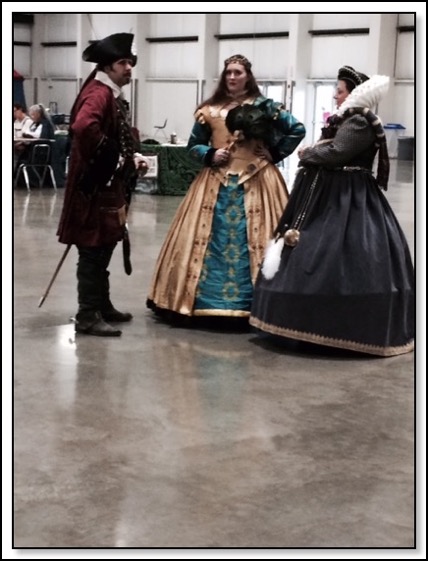

More on Appomattox
10/04/15 07:01
Here is another well written piece about the surrender at Appomattox. There are many good writers out there who can bring that day 150 years ago into the present.
One hundred and fifty years ago today, Robert E. Lee acknowledged the inevitable.
His forces shrunken and surrounded, his provisions dwindling rapidly, the Union Army pressing the attack, Lee first acknowledged to himself, then to his fellow Confederate officers, and finally to Ulysses Grant that the South was defeated.
“The time has come,” Lee told aide-de-camp Walter Herron Taylor, “for capitulation.”
“Well, sir,” Col. Herron replied, “speaking only for myself; to me, any other fate is preferable.”
One hundred and fifty years ago today, Robert E. Lee acknowledged the inevitable.
His forces shrunken and surrounded, his provisions dwindling rapidly, the Union Army pressing the attack, Lee first acknowledged to himself, then to his fellow Confederate officers, and finally to Ulysses Grant that the South was defeated.
“The time has come,” Lee told aide-de-camp Walter Herron Taylor, “for capitulation.”
“Well, sir,” Col. Herron replied, “speaking only for myself; to me, any other fate is preferable.”
Appomattox at 150
09/04/15 07:00
Today is the sesquicentennial of the surrender at Appomattox. We have visited this Civil War site which is not as heavily visited as many others. Bob and I were visiting Charlottesville in Virginia and were staying at a lovely B&B, At breakfast we heard some other people talking about how they had visited and felt the quiet and power of the place. We dropped our plans for the day and drove south to Appomattox. We have always been glad that we did. There is a stillness there and you can just envision all the soldiers slowly marching and waiting for the ending of a war that killed so many men, so many dreams. Here is a synopsis of different articles about this day.
James Madison
07/04/15 06:45
We have a large library in our house. Many books. A fair number of them are history books and exceptionally good ones about U.S. Presidents. One person who is often credited with being the writer and voice behind the Constitution is James Madison. We have visited his home in Virginia and almost went again (drove by but the cost to enter was too expensive then). It was interesting and his life with Dolly sounded also a story to hear. Now there appears to be even more a focus on his life. There are 4 new books out about James Madison and you can read about them here.
Medieval Cemetery at Cambridge
02/04/15 15:28
A large cemetery holding the remains of approximately 1300 people has been found near the University of Cambridge. The bodies are likely from the medieval hospital located in the area and were mostly poor people. More information can be found here.
Scientists say the bodies mostly date from between the 13th and 15th centuries. They would have been taken from the Hospital of St. John the Evangelist, which stood across from the graveyard until 1511. The college, which takes its name from the hospital, was founded that same year by Lady Margaret Beaufort, mother of King Henry VII.
The bodies were buried without coffins or even burial shrouds, suggesting that most of the dead were poor. Most of the bodies were male, hinting at the hospital and cemetery's stated purpose, which was to treat "poor scholars and other wretched persons."
Scientists say the bodies mostly date from between the 13th and 15th centuries. They would have been taken from the Hospital of St. John the Evangelist, which stood across from the graveyard until 1511. The college, which takes its name from the hospital, was founded that same year by Lady Margaret Beaufort, mother of King Henry VII.
The bodies were buried without coffins or even burial shrouds, suggesting that most of the dead were poor. Most of the bodies were male, hinting at the hospital and cemetery's stated purpose, which was to treat "poor scholars and other wretched persons."
Old Nazi Hideouts in Argentina
24/03/15 16:22
They captured Adolph Eichmann in Argentina. We know conventional wisdom says many German Nazis escaped at the end of the war to countries on the eastern side of South American. Mengele lived in Brazil plus Paraguay, I believe, until he died. They found some old buildings, hideouts, in the jungle in Argentina near the border with Paraguay. Just more evidence of the stories that would make up "The Odessa File". Here is a fascinating story found in the Washington Post.
Forgotten Civil War Sites
21/03/15 16:40
I love to travel and go to Civil War sites. I especially like to find small gems of historical sites that don't always attract crowds. Bob and I have been to Gettysburg, Appamatox, Fredricksburg, Antietam, Vicksburg as some of the biggies. They are special. Now it is great to find this article about some forgotten much lesser known battlefields. Check it out here.
Robert E. Lee
19/03/15 16:28
One cannot read about the Civil War and not read quite a bit about Robert E. Lee. His background is fascinating and he had the chance to be a general in the Northern Army. Most likely THE General in charge. What Ifs can ponder how many fewer men and less property destruction would have occurred if he had done so. What would have been like to be in the presence of the top 3 men of that time - Lincoln, Grant, and Lee? I would have like to have sat in one some of their meetings. They all are certainly people I would like to have known. A new book is out looking how Lee squandered his legacy and connection to America's most revered figure, George Washington. A review can be found here.
Lincoln's Constant Threat
17/03/15 16:09
Abraham Lincoln faced threats through out his later political life. Certainly around his election, first inauguration, and his years as President. Evidently, he was almost assassinated 9 months before he was assassinated. He still lived his life more in the open and did not shut himself away from meeting the public. It is sad that such a great man, IMO, engendered such hatred. There was much to learn from him than hate him. Read more about this episode here.
In 1864,
"It was during a lonely ride back to the Soldiers’ Home one night in August when an attempt was made on the President’s life. Riding slowly on the road that led to the entrance to the grounds, a rifle shot from approximately fifty yards away startled his horse; Old Abe, the horse, took off at what the President called “break-neck speed [which] unceremoniously separated me from my eight-dollar plug hat, with which I parted company without any assent, express or implied.” "
In 1864,
"It was during a lonely ride back to the Soldiers’ Home one night in August when an attempt was made on the President’s life. Riding slowly on the road that led to the entrance to the grounds, a rifle shot from approximately fifty yards away startled his horse; Old Abe, the horse, took off at what the President called “break-neck speed [which] unceremoniously separated me from my eight-dollar plug hat, with which I parted company without any assent, express or implied.” "
Lincoln's Second Inaugural
04/03/15 07:17
Lincoln's Second Inaugural Address is considered a masterpiece of political speech. It was all of 700 words, few compared to current politicians who love to hear their own voice. It also pealed with Biblical cadences and themes.
"A hundred and fifty years ago today, as the sun broke through the clouds shortly after noon on a wet Washington day, Abraham Lincoln, with one hand raised and the other on an open Bible, took the presidential oath of office for the second time. The speech he just gave had been received by an enthusiastic crowd on the East Portico of the U.S. Capitol. It took about six minutes. Then the oath. Then he said, “So help me God,” bent forward, and kissed the Bible to conclude the solemn ceremony.
Delivered in the waning days of a devastating national conflict that claimed the lives of an estimated 750,000 men, the Second Inaugural Address is widely considered among the most eloquent of all presidential utterances. Lincoln himself considered it one of his finest speeches, telling Thurlow Weed it was “perhaps better than . . . anything I have produced.” It is also among the shortest inaugural addresses, a little over 700 words in length. It is a model of profound simplicity."
An article of longer description of the speech is here.
"A hundred and fifty years ago today, as the sun broke through the clouds shortly after noon on a wet Washington day, Abraham Lincoln, with one hand raised and the other on an open Bible, took the presidential oath of office for the second time. The speech he just gave had been received by an enthusiastic crowd on the East Portico of the U.S. Capitol. It took about six minutes. Then the oath. Then he said, “So help me God,” bent forward, and kissed the Bible to conclude the solemn ceremony.
Delivered in the waning days of a devastating national conflict that claimed the lives of an estimated 750,000 men, the Second Inaugural Address is widely considered among the most eloquent of all presidential utterances. Lincoln himself considered it one of his finest speeches, telling Thurlow Weed it was “perhaps better than . . . anything I have produced.” It is also among the shortest inaugural addresses, a little over 700 words in length. It is a model of profound simplicity."
An article of longer description of the speech is here.
The Real Machiavelli
02/03/15 20:35
Machiavelli was the earlier form of cutthroat politician type. He wrote the blueprint for Saul Alinksy type tactics.
He wrote the book, The Prince, though some think it might have been meant to be a satire.
Entangled in Florentine politics during a tumultuous time at the height of the Renaissance, Niccolò Machiavelli became alternately a diplomat, a victim, a prisoner, an exile and, ultimately, the “father of modern political theory.” And although he remains famous today for his well-articulated methods for ruthlessly thriving in a corrupt world, he never said the phrase that is most often attributed to him: “the ends justify the means.”
Check him out here.
He wrote the book, The Prince, though some think it might have been meant to be a satire.
Entangled in Florentine politics during a tumultuous time at the height of the Renaissance, Niccolò Machiavelli became alternately a diplomat, a victim, a prisoner, an exile and, ultimately, the “father of modern political theory.” And although he remains famous today for his well-articulated methods for ruthlessly thriving in a corrupt world, he never said the phrase that is most often attributed to him: “the ends justify the means.”
Check him out here.
Portrait of Anne Boleyn
28/02/15 20:47
There are evidently very few portraits of Anne Boleyn, the second wife of Henry VIII. Actually just one, yet another rare portrait has been found and confirmed. The lack of portraits is due to Henry destroying many of the portraits after he had her executed. It would be interesting to see such a portrait. The accompanying picture with this post is from the Metropolitan Opera performance of "Anne Bolena". More can be found here.

Dostoevsky
26/02/15 19:39
Russia is well known for a large number of artists - from composers, to poets, to ballet, to writers. One of the best was Fyodor Dostoevsky. His best known work was Crime and Punishment. I came across this information about how he and his writer colleagues were put through a mock execution in 1849 by Czar Nicolas I. This particular Czar was an autocrat and harsh on the peasant population. More about Dostoevsky's background, his work, and what inspired him can be found here.
The Plague
25/02/15 19:34
Interesting theory. Scientists now believe that the plague to hit Europe in the Middle Ages was more spread due to gerbils than due to rats moving from trade routes to on ships.
"What we are suggesting is that it was gerbils in Central Asia and the bacterium in gerbils that eventually came to Europe," Stenseth says. The scientists used climate records to check their theory, and they found a tentative link. When the climate in Asia was good, gerbils are thought to have thrived; but when it went bad, the population crashed. And about 15 years after each boom and bust, a plague outbreak erupted in Europe. The theory is that fleas carrying plague jumped from dead gerbils to pack animals and human traders, who then brought it to European cities. The research team's results appear in the current issue of the Proceedings of the National Academy of Sciences.
More here.
"What we are suggesting is that it was gerbils in Central Asia and the bacterium in gerbils that eventually came to Europe," Stenseth says. The scientists used climate records to check their theory, and they found a tentative link. When the climate in Asia was good, gerbils are thought to have thrived; but when it went bad, the population crashed. And about 15 years after each boom and bust, a plague outbreak erupted in Europe. The theory is that fleas carrying plague jumped from dead gerbils to pack animals and human traders, who then brought it to European cities. The research team's results appear in the current issue of the Proceedings of the National Academy of Sciences.
More here.
The Crusades
09/02/15 16:39
Our President recently insulted Christians at the National Prayer Breakfast. As a Christian, I certainly feel his comments were insulting and beyond what the President should do or say. That he is not like any other prior President and seems to care little what other Americans like or want (even his supporters at times) is evident.His comments also tended to misrepresent Christianity's role in the Crusades. Here is information the author says is the real history of the Crusades.
The Admirable Crichton
03/02/15 20:28
I came across this blog with the unusual name of "Gladlylerne,gladlyteche". The subject of this particular post was the story of a man, an individual who was a prime example of rising quickly and burning out, dying at a young age. This refers to The Admirable Crichton. Quite a career this young man had from Scotland through the European Continent. Read about it here.
"If you have heard of the Admirable Crichton at all, which may be unlikely, it is probably in connection with J. M. Barrie’s once-famous play of that name (1903). The Admirable Crichton is an imaginative satire on the theme of the British class system, sort of a combination of Downton Abbey and Lord of the Flies. It is rather brilliant, but now probably hopelessly “dated”."
"If you have heard of the Admirable Crichton at all, which may be unlikely, it is probably in connection with J. M. Barrie’s once-famous play of that name (1903). The Admirable Crichton is an imaginative satire on the theme of the British class system, sort of a combination of Downton Abbey and Lord of the Flies. It is rather brilliant, but now probably hopelessly “dated”."
Faces of Auschwitz
27/01/15 08:45
It is the 70th anniversary of the liberation of the Auschwitz concentration camp in Poland. There have been a number of ceremonies featuring the survivors, especially that the numbers are dwindling due to time and age.
I came across this Flashback of photos from that time period and on. Many of these have been seen elsewhere though not all through this blog. Please see the faces of those who survived and others.
I came across this Flashback of photos from that time period and on. Many of these have been seen elsewhere though not all through this blog. Please see the faces of those who survived and others.
Churchill's Lost Election
26/01/15 19:31
The 50th anniversary of Churchill's passing was this weekend. I have long admired Churchill for many reasons. A lot of it is his style of writing and his sense of history especially family history. I have a number of his books in series. I love the History of the English Speaking People. I lived with those books daily for awhile. It certainly made me an Anglophile. Here is an interesting article on why Winston Churchill lost his election so soon after World War II was over.
The World's First Computer Revisited
23/01/15 19:23
Here is an interesting story of how the world's first computer was found and put together (overall) again after it was brought back from a pile of junk or the scrap heap. More detail beyond the following can be found here.
"The ENIAC was a 27-ton, 1,800-square-foot bundle of vacuum tubes and diodes that was arguably the world’s first true computer. The hardware that Perot’s team diligently unearthed and lovingly refurbished is now accessible to the general public for the first time, back at the same Army base where it almost rotted into oblivion.
ENIAC was conceived in the thick of World War II, as a tool to help artillerymen calculate the trajectories of shells. Though construction began a year before D-Day, the computer wasn’t activated until November 1945, by which time the U.S. Army’s guns had fallen silent. But the military still found plenty of use for ENIAC as the Cold War began—the machine’s 17,468 vacuum tubes were put to work by the developers of the first hydrogen bomb, who needed a way to test the feasibility of their early designs. The scientists at Los Alamos later declared that they could never have achieved success without ENIAC’s awesome computing might: the machine could execute 5,000 instructions per second, a capability that made it a thousand times faster than the electromechanical calculators of the day. (An iPhone 6, by contrast, can zip through 25 billion instructions per second.)"
"The ENIAC was a 27-ton, 1,800-square-foot bundle of vacuum tubes and diodes that was arguably the world’s first true computer. The hardware that Perot’s team diligently unearthed and lovingly refurbished is now accessible to the general public for the first time, back at the same Army base where it almost rotted into oblivion.
ENIAC was conceived in the thick of World War II, as a tool to help artillerymen calculate the trajectories of shells. Though construction began a year before D-Day, the computer wasn’t activated until November 1945, by which time the U.S. Army’s guns had fallen silent. But the military still found plenty of use for ENIAC as the Cold War began—the machine’s 17,468 vacuum tubes were put to work by the developers of the first hydrogen bomb, who needed a way to test the feasibility of their early designs. The scientists at Los Alamos later declared that they could never have achieved success without ENIAC’s awesome computing might: the machine could execute 5,000 instructions per second, a capability that made it a thousand times faster than the electromechanical calculators of the day. (An iPhone 6, by contrast, can zip through 25 billion instructions per second.)"
Ideal Communist City
22/01/15 19:16
Planners of a particular mind set are looking at ways to get more people to live in dense urban environments, close together, and to use urban transit systems. Not my cup of tea to be sure. Maybe the precursor to their ideal now was what people thought were the ultimate communist city model in the Soviet Union. I saw this sort of lifestyle in East Berlin when I visited there in 1969. Again, not the way I would live, especially behind the Berlin Wall which I saw first hand (along with the crosses for those who were killed trying to leave over No Man's Land. So take a look at what was in our past and may never be totally out of possibility with the socialist leaning minds out there.
The Klaus Barbie Trial
20/01/15 10:36
There is so much of what is happening in France lately to the Jews that relates back to the history of how the holocaust affected them in that country. For a bit of a history lesson on one of the worst Gestapo offenders put on trial after the war, one should read about Klaus Barbie.
Wyatt Earp, Good or Not So Good?
11/01/15 15:35
I have felt that the movie Tombstone is a really good movie whether it is a decent depiction of Wyatt Earp's life there, or before and after. Certainly Val Kilmer as Doc Holliday stole the movie away. Great job in my opinion. Now back to the real Wyatt Earp. There has been debate over whether Earp was a good man as conventional wisdom likes to portray him or was he not such a good man? Check it out here.
"The history books (and Hollywood) often describe the famous lawman, Wyatt Earp, as many things: brave, courageous, moral, law-abiding, and honorable. In the story of the “Gunfight at the OK Corral,” Earp is often portrayed as the hero, the good guy we all should be rooting for. In truth, Wyatt Earp was a much more complicated individual who, among other things, was arrested several times in his life for various offenses, involved in a few major scandals (sometimes on the “bad guy” side), and otherwise seemed to be an individual who balanced precariously on that line between a life as a criminal and a life as a lawman."
"The history books (and Hollywood) often describe the famous lawman, Wyatt Earp, as many things: brave, courageous, moral, law-abiding, and honorable. In the story of the “Gunfight at the OK Corral,” Earp is often portrayed as the hero, the good guy we all should be rooting for. In truth, Wyatt Earp was a much more complicated individual who, among other things, was arrested several times in his life for various offenses, involved in a few major scandals (sometimes on the “bad guy” side), and otherwise seemed to be an individual who balanced precariously on that line between a life as a criminal and a life as a lawman."
Shelby Foote
08/01/15 19:15
Potentially the most authoritative collection on the Civil War is the 3 book series of Shelby Foote, The Civil War. We have owned this set for many years. It is well done. This article is a fascinating piece of how a young man became immersed in this subject and spent almost 20 years writing a classic on this particular war. Well done, Shelby, well done indeed.
Bastogne, 70 years ago
26/12/14 15:12
There have been a number of articles reminding us of the Battle of the Bulge and the relief of Bastogne during the Christmas holidays of 1944. American soldiers were surrounded by German troops. Their indomitable spirit and the arrival of Patton's troops helped save the dire situation. An article about what happened 70 years ago is found here.
Poland
12/12/14 08:35
I love to be able to travel and there are a number of places I would like to visit in this world. Traveling to Poland is one. Visiting Warsaw and Cracow would be top of the list. Due to their rich history and culture. Culture that that was deeply damaged and changed within the last 75 years. The first Jews arrived in the 10th century to the area that is Poland. They made up a large percentage of the population until nearly exterminated during World War II. Their story is the story of Poland too even though there are not large numbers there now. Poland has recently opened a new museum that looks at the History of Polish Jews over time since their arrival there. From reading this article and others, there is now additional reasons to visit the area. The museum is built in the heart of the Warsaw ghetto where so much loss of life and significance from World War II.
Lincoln's Fathers
10/12/14 15:35
Lincoln once told her law partner that his mother's father was a "well-bred planter or farmer from Virginia". So Lincoln's roots may have been more upscale than originally though as humble. More information can be found in this review of a book, 'Founder's Son'.
1927 Bristol Sessions
07/12/14 11:44
I bet most people have not heard of the 1927 Bristol Sessions. Not being a music student, I had not until recently. On our trip to Nashville recently, I wandered through the music store associated with the Country Music Hall of Fame. While I was contemplating purchasing an album of Emmy Lou Harris’ (fine voice), I decided on a CD compilation called the 1927 Recordings of the Bristol Sessions done in Bristol, TN. The artists feature were Jimmie Rodgers and the Carter Family. I got the inkling that this was a defining moment for country music and what I understand is called “root music’. These individuals were pioneers in bringing the music that traveled from the Scots/Irish areas to the Appalachian region into our awareness. A beautiful film that shows what this might mean is worth viewing, “Songcatcher”, starring Janet McAteer and Aidan Quinn. The 1927 Bristol Sessions is the first recording done of “root” music in the United States and it is interesting to listen to.
Now I see today that I was up with this interest since there is a New York Times Book Review on two books covering this phenomenon in American Music history.
Now I see today that I was up with this interest since there is a New York Times Book Review on two books covering this phenomenon in American Music history.
Sand Creek Massacre
03/12/14 19:22
One of the sad episodes in American history is the Sand Creek Massacre in eastern Colorado in 1864. This article is written by a descendant of one of the U.S. cavalrymen there that day. He felt he needed to explore the history of that time and understand his ancestor’s involvement. This is a fascinating story and he eventually came across a Native American descendant from a child who survived the massacre (in a very unusual and strange way). In the end, the descendants have found some peace and forgiveness together. It was a black stain on our nation’s history of the West.
Kamikaze Pilots
26/11/14 06:46
During World War ll, one of the most alarming aspects of the Asian/Pacific theatre was the development of the Japanese Kamikaze pilot. One bit of trivia is information about how the pilots were chosen. Ultimately, it came down to pressure and peer-pressure. A more extreme version of this scenario is the suicide bomber found World-wide though primarily in the Middle-East.
Paperback Books and World War ll
23/11/14 16:10
Did paperback books help win World War ll for the Citizen Soldier? Did it help with their war experience and to pass the time? Maybe this was their type of dime store novel. Find out the background here.
“A decade after the Nazis’ 1933 book burnings, the U.S. War Department and the publishing industry did the opposite, printing 120 million miniature, lightweight paperbacks for U.S. troops to carry in their pockets across Europe, North Africa and the Pacific.
The books were Armed Services Editions, printed by a coalition of publishers with funding from the government and shipped by the Army and Navy. The largest of them were only three-quarters of an inch thick—thin enough to fit in the pocket of a soldier’s pants. Soldiers read them on transport ships, in camps and in foxholes. Wounded and waiting for medics, men turned to them on Omaha Beach, propped against the base of the cliffs. Others were buried with a book tucked in a pocket.”
“A decade after the Nazis’ 1933 book burnings, the U.S. War Department and the publishing industry did the opposite, printing 120 million miniature, lightweight paperbacks for U.S. troops to carry in their pockets across Europe, North Africa and the Pacific.
The books were Armed Services Editions, printed by a coalition of publishers with funding from the government and shipped by the Army and Navy. The largest of them were only three-quarters of an inch thick—thin enough to fit in the pocket of a soldier’s pants. Soldiers read them on transport ships, in camps and in foxholes. Wounded and waiting for medics, men turned to them on Omaha Beach, propped against the base of the cliffs. Others were buried with a book tucked in a pocket.”
Ia Drang
19/11/14 09:23
There is a good Mel Gibson movie based on the book, “We Were Soldiers Once and Young.” This was based on the Vietnam battle in the Ia Drang in November of 1965. The book was written by Joe Galloway and Lt. Col. Hal Moore’s book. A bit of history and detail about this can be found at this web page.
Duchess of Devonshire
18/11/14 09:15
A recent article covered the death and some history of the Duchess of Devonshire, Debo, as she was known. Debo was a Mitford. To read about an example of the upper British class and some of its oddities, you have to read about the Mitfords. Especially the Mitford sisters. The author of this piece evidently knew the family and has written about them. Enjoy reading about a different world from ours. Are they privileged or damaged?
Lincoln and the Press
12/11/14 20:18
Abraham Lincoln it was claimed knew how to play the press. A review of a book that discusses this in a thorough manner is found here. It makes you wonder how well he would do handling Facebook and Twitter.
“It was a dirty game by later standards, and no one played it better than Abraham Lincoln. He developed new stratagems as he rose from citizen to candidate to officeholder. Without abandoning his old methods, he developed new ones, more effective if no more scrupulous, as he got better himself (and better situated), for controlling what was written about him, his policies, and his adversaries. Harold Holzer, who has been a press advocate for candidates (Bella Abzug, Mario Cuomo) and institutions (the Metropolitan Museum of Art and various Lincoln organizations), knows the publicity game from the inside, and he is awed by Lincoln’s skills as a self-publicist, that necessary trait of his time. Holzer is also a respected and influential Lincoln scholar who does not come to bury Lincoln with this new information but to wonder how a man could swim so well through the sewer and come out (relatively) clean.”
“It was a dirty game by later standards, and no one played it better than Abraham Lincoln. He developed new stratagems as he rose from citizen to candidate to officeholder. Without abandoning his old methods, he developed new ones, more effective if no more scrupulous, as he got better himself (and better situated), for controlling what was written about him, his policies, and his adversaries. Harold Holzer, who has been a press advocate for candidates (Bella Abzug, Mario Cuomo) and institutions (the Metropolitan Museum of Art and various Lincoln organizations), knows the publicity game from the inside, and he is awed by Lincoln’s skills as a self-publicist, that necessary trait of his time. Holzer is also a respected and influential Lincoln scholar who does not come to bury Lincoln with this new information but to wonder how a man could swim so well through the sewer and come out (relatively) clean.”
The Yanks Are Coming
11/11/14 20:11
Today is Veteran’s Day. It is a bit fitting to blog about World War I again and an article about a book out about this period and how the Yanks came to fight over in Europe. There is a bit more about that time and the book that is available here.
“Though the country was unprepared for war and there were questions about the leadership of the administration, the threat of unrestricted warfare from German U-boats, the sinking of the passenger ship Lusitania with American civilians on board, and the dubious telegram sent from Germany to Mexico—promising a return of territory in the American southwest if the central American country joined Germany in a war against the United States—drew America into World War I.”
“Though the country was unprepared for war and there were questions about the leadership of the administration, the threat of unrestricted warfare from German U-boats, the sinking of the passenger ship Lusitania with American civilians on board, and the dubious telegram sent from Germany to Mexico—promising a return of territory in the American southwest if the central American country joined Germany in a war against the United States—drew America into World War I.”
Scarred Landscapes
10/11/14 11:38
History still shows and bears the scars of what are scenes from our war time history. A photographer has made a project of taking a number of photos from above and from different perspectives of the battlefields of World War I. The images are beautifully photographed and haunting. In the long run they are downright amazing. Please view them here. People lived and died here. No wonder the British call it Remembrance Day.ing to
James K. Polk
03/11/14 19:27
President James K. Polk came into office making a promise to serve one term and accomplish his goals in that time frame. He pushed the expansion of the United States to the West..........Manifest Destiny as it were. I have a biography on his presidency which I still need to read. He is buried in Nashville and here is his burial site. Another interesting fact gleaned while there is that the town was established by settlers, one of whom was last name Donelson. He was the father of Rachel Donelson, the wife of Andrew Jackson. Interesting connections.
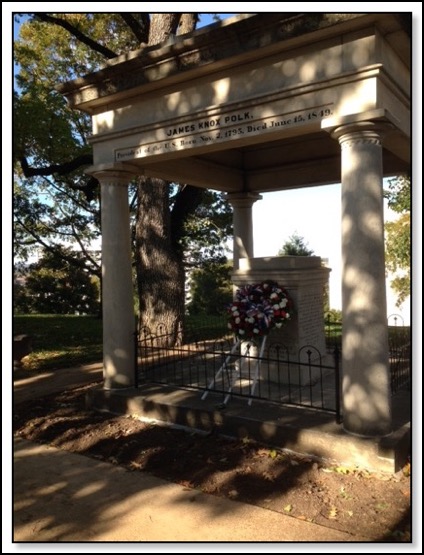

From Funny to Serious
28/10/14 19:15
Anne Applebaum who is a compelling writer reviews the first volume of three planned books of an extensive biography of Stalin. The premise here is not that he was crazy or devious but rose to the top of this group because he was smart and ambitious. It pays to understand Stalin because many still wish he was in charge of Russia and admire what he achieved. There also could be more like him out there in the future. Know thy enemy. Read about it here.
Columbus Day
13/10/14 20:50
The world is getting even wackier. We are due to spend right after the New Year’s in Seattle and they are beyond wacky. Today is not Columbus Day to the City Council there but Indigenous People. At this point, based on how long my family has been located in America, I am well into being an indigenous person. Some background.
Radical Islam in the Middle East
10/10/14 15:09
The Pledge
09/10/14 15:06
What is the origin of the Pledge of Allegiance? I certainly have never felt the need to “diss” saying the Pledge. While I have been with some who live outside the U.S. who would grumble, I do a respectful “God Save the Queen” when I need to.
Gypsy History
03/10/14 13:06
Another one from Today I Found Out...................about where Gypsies originated as a group of people. Find out more here.
On one of our trips to England, Bob and I came across a traveling Gypsy family. The father was leading the wagon and his family down one of the main two-way roads between Salisbury and Exeter. Since the wagon moved slowly, the traffic did back up behind them. Because it was such an unusual sight, I wish I had been able to get a photo but my cameras were film in those days and not set to be accessible and get quick shots.
“They do not have a shared homeland or national identity. They are a people who are scattered across the globe and whose origins have always been shrouded in myth and mystery (among other reasons because they have kept no written records of their early history). Many saw them (and continue to do so in many cases) as dirty, thieving and undesirable, others as artistic, romantic and carefree. In France, they are referred to as gitanes, in Spain they are called gitanos, and in Germany, zigeuner.
There are an estimated 12 million Romani – better known as Gypsies – living worldwide. Most of them (8-10 million) live in Europe, making them the continent’s largest ethnic minority group. So where did they come from?
A recent genetic analysis of 13 European Gypsy groups confirmed that their ancestors, for reasons not perfectly clear, left India in a single emigration wave some 1,500 or so years ago. “There were already some linguistic studies that gave clues pointing to India and genetic studies too, though without being precise about the where or when,” explained David Comas, leader of the research group that made the discovery.”
On one of our trips to England, Bob and I came across a traveling Gypsy family. The father was leading the wagon and his family down one of the main two-way roads between Salisbury and Exeter. Since the wagon moved slowly, the traffic did back up behind them. Because it was such an unusual sight, I wish I had been able to get a photo but my cameras were film in those days and not set to be accessible and get quick shots.
“They do not have a shared homeland or national identity. They are a people who are scattered across the globe and whose origins have always been shrouded in myth and mystery (among other reasons because they have kept no written records of their early history). Many saw them (and continue to do so in many cases) as dirty, thieving and undesirable, others as artistic, romantic and carefree. In France, they are referred to as gitanes, in Spain they are called gitanos, and in Germany, zigeuner.
There are an estimated 12 million Romani – better known as Gypsies – living worldwide. Most of them (8-10 million) live in Europe, making them the continent’s largest ethnic minority group. So where did they come from?
A recent genetic analysis of 13 European Gypsy groups confirmed that their ancestors, for reasons not perfectly clear, left India in a single emigration wave some 1,500 or so years ago. “There were already some linguistic studies that gave clues pointing to India and genetic studies too, though without being precise about the where or when,” explained David Comas, leader of the research group that made the discovery.”
Hanoi and the Ghosts of Communism
25/09/14 21:29
Michael Totten is at it again. Writing about the city of Hanoi in current times, held up to the light against its earlier days of Communism. The system is still there yet not the same. They love America there in spite of the past. Enjoy reading it here.
“The last vestiges of economic communism appear to have been vaporized. Hanoi looks and feels more like a capitalist Wild West than the actual West does these days. But some habits die harder than others.”
“The last vestiges of economic communism appear to have been vaporized. Hanoi looks and feels more like a capitalist Wild West than the actual West does these days. But some habits die harder than others.”
Why Did the Confederacy Lose?
13/09/14 09:11
One military historian who I find I like to read has a recent article on his views of why the Confederacy lost the war. His analysis can be found here.
“There is an old story, probably apocryphal, about a meeting of the Southern Historical Society in the years after the Civil War. The topic was Gettysburg — what mistakes, large or small, did the Confederates make that led to the Southern defeat? The debate was heated and furious. Tempers were at the boiling point. Finally, one of the participants turned to George Pickett of “Pickett’s Charge” fame. “George,” he said, “you were there. Why did we lose the battle?” to which Pickett replied, “I always thought the Yankees had something to do with it.””
“There is an old story, probably apocryphal, about a meeting of the Southern Historical Society in the years after the Civil War. The topic was Gettysburg — what mistakes, large or small, did the Confederates make that led to the Southern defeat? The debate was heated and furious. Tempers were at the boiling point. Finally, one of the participants turned to George Pickett of “Pickett’s Charge” fame. “George,” he said, “you were there. Why did we lose the battle?” to which Pickett replied, “I always thought the Yankees had something to do with it.””
World War I Artists
28/08/14 20:14
I previously had a blog piece about the poets of World War I. Now it is on the artists of that time.
“When the firing ceased in 1918, the belligerents of World War I counted their dead, missing and wounded. They numbered not in the thousands or hundreds of thousands, as in previous wars, but in the millions.
A century after the carnage, the British artists whom art historians deem most consequential are those who reacted most aggressively against the heroic tradition of war painting, both in style and in content. We now automatically associate the Modernist works of Christopher R.W. Nevinson, David Bomberg and Paul Nash with the Great War just as much as we do the bitter and disenchanted poetry written by Wilfred Owen and Siegfried Sassoon. But seeing the conflict exclusively through their eyes leads us to neglect other talented artists who pictured the war in more conventional ways that the general public could readily understand. And so it is that many admirable artists who depicted the conflict, such as Henry Tonks, William Orpen and even John Singer Sargent (in his wartime paintings), are often undeservedly neglected.”
“When the firing ceased in 1918, the belligerents of World War I counted their dead, missing and wounded. They numbered not in the thousands or hundreds of thousands, as in previous wars, but in the millions.
A century after the carnage, the British artists whom art historians deem most consequential are those who reacted most aggressively against the heroic tradition of war painting, both in style and in content. We now automatically associate the Modernist works of Christopher R.W. Nevinson, David Bomberg and Paul Nash with the Great War just as much as we do the bitter and disenchanted poetry written by Wilfred Owen and Siegfried Sassoon. But seeing the conflict exclusively through their eyes leads us to neglect other talented artists who pictured the war in more conventional ways that the general public could readily understand. And so it is that many admirable artists who depicted the conflict, such as Henry Tonks, William Orpen and even John Singer Sargent (in his wartime paintings), are often undeservedly neglected.”
Black Soldiers of the Civil War
26/08/14 20:02
I have tried to highlight different aspects of the Civil War. African-Americans made a significant contribution in the Civil War. A discussion about their involvement by a very good author can be found here.
“At this time 150 years ago, the two major Union army formations — Major General George Meade’s Army of the Potomac and Major General William Tecumseh Sherman’s army group — were tightening their stranglehold on the Confederacy. The former was besieging Petersburg south of the city, trying to thin out Confederate lines and cut the last railroad line connecting Petersburg–Richmond to Georgia and the Carolinas. The latter, having forced the Confederates back on Atlanta, was engaging John Bell Hood in vicious battles at Peachtree Creek, Ezra Church, Dalton, and other places. Atlanta would fall in September, freeing up Sherman for his march to the sea. Petersburg would hold out until March 1865.
While these events were taking place, there were other developments that were less known both at the time and now: among them, the full-scale employment of black soldiers in the service of the Union. The former slave and great abolitionist Frederick Douglass had called for arming blacks at the very outset of the war. Writing in his Monthly of May 1861, Douglass argued that the way “to put an end to the savage and desolating war now waged by the slaveholders, is to strike down slavery itself, the primal cause of that war.” ”
“At this time 150 years ago, the two major Union army formations — Major General George Meade’s Army of the Potomac and Major General William Tecumseh Sherman’s army group — were tightening their stranglehold on the Confederacy. The former was besieging Petersburg south of the city, trying to thin out Confederate lines and cut the last railroad line connecting Petersburg–Richmond to Georgia and the Carolinas. The latter, having forced the Confederates back on Atlanta, was engaging John Bell Hood in vicious battles at Peachtree Creek, Ezra Church, Dalton, and other places. Atlanta would fall in September, freeing up Sherman for his march to the sea. Petersburg would hold out until March 1865.
While these events were taking place, there were other developments that were less known both at the time and now: among them, the full-scale employment of black soldiers in the service of the Union. The former slave and great abolitionist Frederick Douglass had called for arming blacks at the very outset of the war. Writing in his Monthly of May 1861, Douglass argued that the way “to put an end to the savage and desolating war now waged by the slaveholders, is to strike down slavery itself, the primal cause of that war.” ”
Artifacts in the Atlantic Ocean
19/08/14 12:34
A curious find near Chesapeake Bay and the Atlantic Ocean. They found a 22,000-year-old mastodon skull and tool on the seafloor. This, if proven true, might show that there were earlier settlers than previously thought in North America. It might change our thinking of when people came here by some thousands of years. This is “food for thought”.
War Poets 100 Years Ago
18/08/14 12:23
There was a lot of poetry and literature that came from the angst and terrible times of World War I. Amazing thought and words on paper. With the War’s Centennial, there is an effort to highlight and showcase the poetry from that time. One example is Wilfred Owen, a soldier and poet, who died just before war’s end. More information is located online. Here is a demonstration of some of that work.
Three lives hath one life—
Iron, honey, gold.
The gold, the honey gone—
Left is the hard and cold.
—Isaac Rosenberg, from ‘August 1914’
Three lives hath one life—
Iron, honey, gold.
The gold, the honey gone—
Left is the hard and cold.
—Isaac Rosenberg, from ‘August 1914’
World War I Galleries
16/08/14 12:03
One of the most interesting sights and museums Bob and I have visited over the years is the Imperial War Museum in London. It was big and full of so much history. I remember the section on World War II where they kept playing Neville Chamberlain’s speech as Britain entered the second World War. The Museum has ben renovated in anticipation of the centennial of the start of their declaring war for World War I on August 4, 1914.
“A moonscape of craters, mud and shattered stumps fills a wall-sized video screen; you can hear shrieking shells and shattering blasts; an enormous British howitzer, meant to pulverize the enemy’s defenses, points toward the fields. The only thing missing in this gallery, devoted to the Battle of the Somme at the Imperial War Museum here, is the ability to conceive of 20,000 British dead and 37,000 wounded or missing in the first day of fighting, and more than a million casualties over all during five months.
It is one of the most powerful presentations at the new First World War Galleries here, suggesting that this seemingly futile battle was actually a turning point. These galleries, which replace an older presentation that was a classic for a generation, are also part of a $67 million rebuilding of the museum, completed in time to commemorate the centennial of Britain’s entry into the war. That occasion was somberly observed across Britain on Aug. 4 with moments of silence, extinguished lights and the scattered petals of red poppies — the war’s symbol of bloodied innocence and death.”
“A moonscape of craters, mud and shattered stumps fills a wall-sized video screen; you can hear shrieking shells and shattering blasts; an enormous British howitzer, meant to pulverize the enemy’s defenses, points toward the fields. The only thing missing in this gallery, devoted to the Battle of the Somme at the Imperial War Museum here, is the ability to conceive of 20,000 British dead and 37,000 wounded or missing in the first day of fighting, and more than a million casualties over all during five months.
It is one of the most powerful presentations at the new First World War Galleries here, suggesting that this seemingly futile battle was actually a turning point. These galleries, which replace an older presentation that was a classic for a generation, are also part of a $67 million rebuilding of the museum, completed in time to commemorate the centennial of Britain’s entry into the war. That occasion was somberly observed across Britain on Aug. 4 with moments of silence, extinguished lights and the scattered petals of red poppies — the war’s symbol of bloodied innocence and death.”
Sherman's March to the Sea
06/08/14 11:32
Gone With The Wind as a book and a movie depict in a bigger-than-life way the destruction of Atlanta and plantation life in the South during the Civil War. General Sherman was and still is considered a destroyer, a butcher per se to many people of Southern heritage. Victor Davis Hanson has an article that discusses the Atlanta campaign the Sherman’s severing of supply lines to make his March to the Sea in Georgia. By doing so, he feels he freed himself to attack the structure and illusion of the plantation elite to prop up the Southern armies to continue a prolonged struggle. By taking the war to those who started it and wished to continue their way of life, he brought the reality of war upon them and possibly shortened the war in the end. Interesting military history.
World War l and the Movies
05/08/14 12:14
A look at World War l and its depiction in film...........
“Beyond their stated or implicit concerns, movies in some way always reflect the times in which they were made. And films about World War I are no exception. In the century since the start of the war, variously commemorated throughout Europe and the U.S. this summer, the conflict has often been portrayed on screen—represented at different times as either a misguided enterprise or a glorious cause. Less appreciated is the Great War's use as propaganda tool as new hostilities arose throughout the 20th century and into the present one. Such pictures shed light not only on how the war itself was perceived at different points following its conclusion, but also on the manner in which subsequent generations bent the narrative to their own purposes.”
“Beyond their stated or implicit concerns, movies in some way always reflect the times in which they were made. And films about World War I are no exception. In the century since the start of the war, variously commemorated throughout Europe and the U.S. this summer, the conflict has often been portrayed on screen—represented at different times as either a misguided enterprise or a glorious cause. Less appreciated is the Great War's use as propaganda tool as new hostilities arose throughout the 20th century and into the present one. Such pictures shed light not only on how the war itself was perceived at different points following its conclusion, but also on the manner in which subsequent generations bent the narrative to their own purposes.”
July 1914
04/08/14 11:44
Did circumstances explode past the some countries’ expectations in the crucial month of July 1914? Was the war inevitable as some believed? Or did Germany let Austria take control of the issue and drive the continent into war unnecessarily? Sadly, did such loss of life inevitably need to occur before countries realized the overwhelming destructive nature of the conflict and avoid it in the future (or the future after World War ll). Here is another article discussing the nature of the summer of 1914.
Warsaw Uprising Anniversary
02/08/14 09:26
August 1, 1944 was the start of the Warsaw uprising in the ghetto by the Jews against the Germans. This is the 70th anniversary of the start of the Uprising. By the end, most of the Jews were dead, wiped out by the Germans while the Soviets stood by and let it happen. A haunting story of one survivor’s memory of the time can be found in this article.
“On Friday, Mikos will be among a shrinking group of insurgents to be honored in state ceremonies marking the 70th anniversary of the start of the 1944 Warsaw Uprising. In this uneven struggle, poorly armed young city residents rose up against the German forces that had brutally occupied Poland for five years, battling them in the streets of the capital for over two months.”
“On Friday, Mikos will be among a shrinking group of insurgents to be honored in state ceremonies marking the 70th anniversary of the start of the 1944 Warsaw Uprising. In this uneven struggle, poorly armed young city residents rose up against the German forces that had brutally occupied Poland for five years, battling them in the streets of the capital for over two months.”
August 1, 1914
01/08/14 09:15
100 years ago today, imperial Germany declared war on Serbia to support their ally, the Austro-Hungarian Empire. On July 28, a few days prior, the Austro-Hungarian government has attacked Serbia in response to the assassination of Archduke Francis Ferdinand in Sarajevo. Four and one-half years later millions were dead and injured while countries world-wide were impacted. Why was it so deadly to so many? Here is an opinion page article giving some thought and voice to that question.
Spies Come In From the Cold
30/07/14 08:57
John Le Carre wrote the ultimate spy novel, “The Spy Who Came In From The Cold”, many years ago. It is considered to be based on the group of Cambridge-educated men who were friends that went on to be spies for Russia within the British government. The amount of information and secrets they shared with Russia was huge and devastating. The story of the men and their clique at university is fascinating. A recent book has come out about the most well-known of the group, Kim Philby. The title is called, “ A Spy Among Friends”. To read about the background, find it here.
Vicksburg's Fallen
26/07/14 07:01
There was a beautiful cemetery at the Vicksburg battlefield that held many of the fallen from that period of the war. The fallen were laid out amongst trees under rows of white headstones. Very quiet and solemn, along the Mississippi River. The cemetery is next to the Cairo Exhibit. I was able to get a number of photos from there, one showing the headstones while a hawk was taking off above them. Not as close as I would like but interesting.
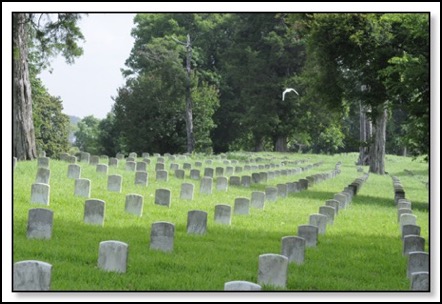

Thayer's Approach at Vicksburg
25/07/14 06:55
Much to our surprise while traveling through Vicksburg and visiting the historical battlefield there was seeing the monument and stop for Thayer’s Approach. General John Thayer on the Union side had a critical piece and attack during the Vicksburg siege. His men had to attack the Confederate entrenchments up a steep slope. The following picture gives a description of the attack.
Thayer’s Approach
Thayer’s Approach
Five Bloodiest Battles in History
19/07/14 09:10
Interesting read on what they consider the 5 bloodiest battles in history. The number one top bloodiest was the Battle of Stalingrad.
Read about it, the numbers, and the other four here.
As the lead in paragraph states from this article in Military History online---
“Much of a soldier’s life is spent awaiting and preparing for war. When the moment to take action does come, it is usually bloody, confusing, and over quickly. Often, combat will be on a small scale; a skirmish, a probing patrol, an accidental clash with the enemy in the darkness. At other times, fear will destroy an army, causing men to flee from the perceived threat of death before severe casualties have been sustained by either side. And, finally, there is the battle that surpasses the normal expectations of war in its scale of death and destruction. These are the days where neither side is prepared to surrender, or – as is so often the case – a general’s strategy is such that it leaves the enemy no escape, left to the mercy of the victors.”
Read about it, the numbers, and the other four here.
As the lead in paragraph states from this article in Military History online---
“Much of a soldier’s life is spent awaiting and preparing for war. When the moment to take action does come, it is usually bloody, confusing, and over quickly. Often, combat will be on a small scale; a skirmish, a probing patrol, an accidental clash with the enemy in the darkness. At other times, fear will destroy an army, causing men to flee from the perceived threat of death before severe casualties have been sustained by either side. And, finally, there is the battle that surpasses the normal expectations of war in its scale of death and destruction. These are the days where neither side is prepared to surrender, or – as is so often the case – a general’s strategy is such that it leaves the enemy no escape, left to the mercy of the victors.”
A Union General and His Love Story
18/07/14 09:01
Love and War do often have story lines together and they are not all fiction. A number are real life experiences that would most likely be great films if properly treated. I came across and example just recently about the death of Union General James McPherson. General McPherson was considered one of the best generals of the North during the Civil War. Certainly General Sherman thought so, along with others. McPherson met and fell in love with the daughter of a Southern sympathizer from Baltimore. War and duty kept the two apart and from marrying. Sherman had actually at one point asked McPherson to delay his wedding due to expected heavy campaigning to and around Atlanta. It was during this campaign that McPherson was killed. Emily Hoffman, his fiancé, was left without her love and lived a much longer life, dying unmarried. To read about this story, click here.
An Unbroken Hero
16/07/14 06:46
Recently, an amazing man and a hero out of World War II passed away. The man is Louis Zamparini and he died at the age of 97. He was a pilot in World War II who survived his planed crashing in the Pacific war theatre followed by many days afloat in the ocean trying to make land. He was then captured by the Japanese and with that, survived a brutal incarceration by the Japanese through to the end of the war. Mr. Zamparini was the central focus of the best selling book, Unbroken. For a moving summary of his exploits and character, it can be found here from the Weekly Standard.
A Letter From D-Day
15/07/14 06:56
This summer is the 70th anniversary of the D-Day invasion during World War II. A recent article in Commentary published the letter home to his parents from a soldier who was preparing to attach the beaches. The amazing courage of our citizen soldiers is beyond understanding yet so appreciated. The soldier survived the war. It is a tribute when one of his extended family finds this letter and shares it with all of us here. The original link was broken so a related link was substituted.
Pickett's Charge
14/07/14 07:05
It has been said that the long slow slide to the end of the Confederacy started at Gettysburg, especially at Pickett’s Charge. What did Longstreet feel in giving the order to his soldiers that came from General Lee? In the end, how did his men feel about going into battle where a death sentence was common. A great summary description can be found here.
The Union view toward where Pickett’s charge began and the field traversed in between.
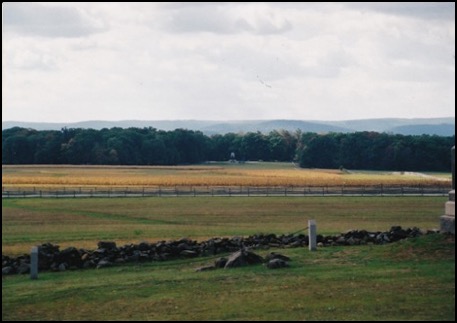
The Union view toward where Pickett’s charge began and the field traversed in between.

Petersburg to Appomattox
13/07/14 07:12
After traveling in Mississippi and seeing the amazing Vicksburg Civil War battlefield, I find I have to keep posting these amazing summaries of Civil War battles or campaigns. They are well-written and fascinating. Here is one describing the stage of war from Petersburg to Appomattox and how it became a war of attrition. Lee was cagey and desperate, but he did not have the resolve and resources to beat Grant in the long run. Read about this period here.
Part of the Petersburg battlefield, near the Crater.
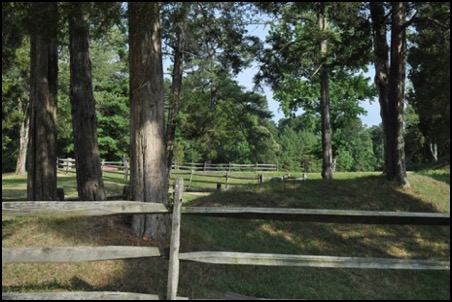
Part of the Petersburg battlefield, near the Crater.

Are We Going Down That Path?
12/07/14 07:19
The Dread Signal
11/07/14 07:24
June 28 was the 100th anniversary of the assassination of Archduke Francis Ferdinand and his wife in Sarajevo. It was the spark that light the fuse for World War I (sorry for the cliche). Yet, it is apt. Many leaders of countries were “itching” to show their importance and demonstrate they should not be taken for granted. Others were drawn in by holding to their word of support of another if attacked. It was a conflagration that was inevitable in many ways and yet not if rational people stepped back and re-thought the consequences. Here is a short summary of what the start of Armegeddon meant.
More Pasternak History
05/07/14 07:24
Here is some more detail about the new book on Boris Pasternak and his history with the CIA. There is a small piece in the CIA’s museum dedicated to their role in bringing his book, Dr. Zhivago, to light and the rest of the world. It is interesting history. There is an under story here too, in that Pasternak had a lover/mistress who was likely the model for Lara in Dr. Zhivago. They both had an interesting life together. Many of these artistic people live a life in a far distant pane of existence than I do or would probably care to. 
The article and review of the books on Pasternak can be found here.
The article and review of the books on Pasternak can be found here.
Another World War l Commemorative
22/06/14 09:53
This year will probably have a lot of articles of interest on the Civil War (sesquicentennial) and World War l (centennial). Being a military history buff, many will end up here for a blog piece. This article is another example, a review of a book written from the soldier’s perspective. For these men, they did not know it was the first of two world wars. It was just day to day reality of war.
“The Great War featured an unusual number of highly literate soldiers for both the Allies (chiefly the Triple Entente of France, Britain, and Russia, and, much later, the United States) and the Central Powers (chiefly Germany and Austria-Hungary), who had no inkling of the inferno that awaited them. We know of the remarkable trio of war poets—Rupert Brooke, Wilfred Owen, and Siegfried Sassoon—and we expect that generals would convey their accounts and impressions. But it is the insight and sensitivity of innumerable junior officers and enlisted men that bring home the terrors of bombardment, from which there seemed no exit, and the eternal presence of mud.”
“The Great War featured an unusual number of highly literate soldiers for both the Allies (chiefly the Triple Entente of France, Britain, and Russia, and, much later, the United States) and the Central Powers (chiefly Germany and Austria-Hungary), who had no inkling of the inferno that awaited them. We know of the remarkable trio of war poets—Rupert Brooke, Wilfred Owen, and Siegfried Sassoon—and we expect that generals would convey their accounts and impressions. But it is the insight and sensitivity of innumerable junior officers and enlisted men that bring home the terrors of bombardment, from which there seemed no exit, and the eternal presence of mud.”
Enduring Legacy of World War l
20/06/14 20:50
I have written a number of blog pieces about World War l. The tragic and lethal war that it was to a generation of young men from England, France, United States, and in the end Germany too. A number of books about the experiences of what happened during the war have been written. They have carried through the last 100 years and now more are writing about current wars and their legacy. Read more here about the war’s legacy in other areas of our culture.
Dr. Zhivago and Pasternak
19/06/14 20:53
One of the most beautiful movies, movie scores, and love stories is Dr. Zhivago. Set in the time of the Russian Revolution and the turmoil at the Bolsheviks took over, it has many historical periods to pull together. The book was written by the Russian poet, Boris Pasternak. There is a story and a book about this the background of the book and movie are found here. Evidently, Pasternak believed he would be executed for writing this book because it would be considered subversive and not for the people. Yet, it would go on to be considered an all time great novel.
D-Day, 70 Years Ago
06/06/14 20:14
Today is the 70th anniversary of D-Day, the landings in Normandy. How amazing and brave those men were. Our Citizen Soldiers as Stephen Ambrose called them. Ceremonies were conducted today at the Normandy memorials and at the cemeteries. Much has been written about that day, here is a collection of photos from the Capa gallery. At the same time, here is the speech Gen. Eisenhower gave to the men of the Allied Expedition.
Anzio
05/06/14 20:05
We are dealing with 70 year old anniversaries this year of episodes during World War ll. On May 25, it was the 70th anniversary of the breakthrough at Anzio in Italy. The Anzio beachhead was considered a way to bypass German lines and flank their armies in Italy. Unfortunately, it did not work out as planned or hoped. Here is an article of the breakthrough to where the Allied Armies could control Italy.
End At Appomattox
02/06/14 20:51
We recently celebrated and honored Memorial Day. The holiday was started shortly after the Civil War ended. There was a recent article discussing the history of Memorial Day in light of the sacrifices of U.S. ward dead. The article featured a section from James McPherson’s book, “Battle Cry of Freedom”. The piece describes the surrender of Lee to Grant. It was a day of sadness yet honor among armies and troops.
Animals in World War l
01/06/14 20:51
The Atlantic Magazine has another edition of the World War l in photos. This edition is focused on the animals as part of the war effort. Primarily dogs and horses. The photos can be found here. Due to this was war and “war is hell”, I caution that some of the photos are more graphic in nature and some may not want to view them.
“But the need for constant resupply, movement of new heavy weaponry, and the transport of troops demanded horse power on a massive scale -- automobiles, tractors, and trucks were relatively new inventions and somewhat rare. British and French forces imported horses from colonies and allies around the world, a near-constant flow of hundreds of thousands of animals across the oceans, headed for war. One estimate places the number of horses killed during the four years of warfare at nearly 8 million. Other animals proved their usefulness as well: Dogs became messengers, sentries, rescuers, and small beasts of burden. Pigeons acted as messenger carriers, and even (experimentally) as aerial reconnaissance platforms. Mules and camels were drafted into use in various war theatres, and many soldiers brought along mascots to help boost morale.”
“But the need for constant resupply, movement of new heavy weaponry, and the transport of troops demanded horse power on a massive scale -- automobiles, tractors, and trucks were relatively new inventions and somewhat rare. British and French forces imported horses from colonies and allies around the world, a near-constant flow of hundreds of thousands of animals across the oceans, headed for war. One estimate places the number of horses killed during the four years of warfare at nearly 8 million. Other animals proved their usefulness as well: Dogs became messengers, sentries, rescuers, and small beasts of burden. Pigeons acted as messenger carriers, and even (experimentally) as aerial reconnaissance platforms. Mules and camels were drafted into use in various war theatres, and many soldiers brought along mascots to help boost morale.”
150 years and on
22/05/14 20:41
This year is the sesquicentennial of one of the biggest year of battles during the Civil War. Much of the Virginia Overland Campaign that Grant led was during this time. The Wilderness, Spotsylvania, Cold Harbor all occurred during this time frame. Other than celebrations at Gettysburg last year, there has not been a lot of memorializing of this anniversary period of the Civil War. A well written and interesting description of this time period and the campaigns in 1864 can be found in the National Review. The author is a retired military officer and has been involved in military history. The article can be found here.
“Following his successes in the West at Vicksburg and Chattanooga, Major General Ulysses S. Grant was appointed by Abraham Lincoln as general in chief of the armies of the United States, and the Senate confirmed him as the first lieutenant general since George Washington. Grant believed that, up to that point, Union armies in different theaters had “acted independently and without concert, like a balky team, no two ever pulling together.”
Accordingly, his strategic plan for 1864 called for putting five Union armies into motion simultaneously against the Confederacy.”
“Following his successes in the West at Vicksburg and Chattanooga, Major General Ulysses S. Grant was appointed by Abraham Lincoln as general in chief of the armies of the United States, and the Senate confirmed him as the first lieutenant general since George Washington. Grant believed that, up to that point, Union armies in different theaters had “acted independently and without concert, like a balky team, no two ever pulling together.”
Accordingly, his strategic plan for 1864 called for putting five Union armies into motion simultaneously against the Confederacy.”
For Sale, Dracula's Castle
18/05/14 16:34
Bran Castle, the setting for Bram Stoker’s Dracula, is up for sale. The castle is a 13th century fortress owned by the Hapsburg royal line and is considered for purchase by the Romanian government. Bram Stoker never visited the castle and relied upon a description of Bran Castle as the setting for Dracula. Stoker also drew inspiration for the vampire character from Vlad lll, the Impaler, born in Transylvania in 1431. Read about it all here.
“And in the novel, Stoker describes the Transylvanian Count's fortress as sitting high above a valley, perched on a rock above a flowing river. As the Bran Castle website notes, this castle is the only sucortress in Transylvania that fits the bill.”
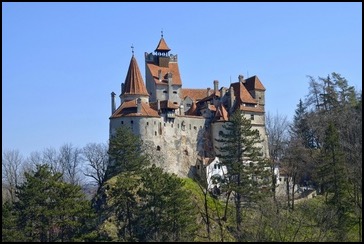
Bran Castle
“And in the novel, Stoker describes the Transylvanian Count's fortress as sitting high above a valley, perched on a rock above a flowing river. As the Bran Castle website notes, this castle is the only sucortress in Transylvania that fits the bill.”

Bran Castle
Technology and World War l
16/05/14 11:50
Most would consider World War l as the war that ended dreams of young people. A destroyer of the old order. A war to end all wars. It actually oversaw the birth of modern technology of warfare. Not necessarily a good thing though the technology was developed with the idea to save lives and end the war sooner. Yet, it didn’t work that way in the end. Take a look into this world and see photos from the era. This is the third part of a 10-part series on World War l in The Atlantic.
“Industrialization brought massive changes to warfare during the Great War. Newly-invented killing machines begat novel defense mechanisms, which, in turn spurred the development of even deadlier technologies. Nearly every aspect of what we would consider modern warfare debuted on World War I battlefields.”
“Industrialization brought massive changes to warfare during the Great War. Newly-invented killing machines begat novel defense mechanisms, which, in turn spurred the development of even deadlier technologies. Nearly every aspect of what we would consider modern warfare debuted on World War I battlefields.”
Coffins and Kings
24/04/14 08:18
The past few years seem to be the time of resurrecting kings of older European history. I have mentioned before the unearthing of King Richard III of England’s remains in England. Now the Swedish have opened the 850 year old coffin of King Eric IX who was murdered and later made a Saint. They have his skull and crown on display in the cathedral at Uppsala. Bob and I have visited Uppsala and the twin spires of the cathedral rise well above the town in a recognizable manner. Uppsala is a very pretty city and was a joy to visit. Read about King Eric’s unearthing here.
“Scientists plan to study the bones of the ruler known as King Erik the Holy because so little is known about him. Through DNA testing and X-ray scans, they hope to learn about his health, his ancestry (some think his father was English), what he ate, and where he lived—it seems there's a longstanding disagreement over whether he was from Uppsala, where he was killed and laid to rest, or the west coast.”
Uppsala Cathedral

“Scientists plan to study the bones of the ruler known as King Erik the Holy because so little is known about him. Through DNA testing and X-ray scans, they hope to learn about his health, his ancestry (some think his father was English), what he ate, and where he lived—it seems there's a longstanding disagreement over whether he was from Uppsala, where he was killed and laid to rest, or the west coast.”
Uppsala Cathedral

The South Was Right
15/04/14 20:34
Historians have felt that the Civil War did not have origins in the anti-slavery movement. The South and Northern Democrats believed that the Republicans would aim to free the slaves in they came to power and war commenced.
An article describing this belief is found here.
“Why did the Southern states choose to secede when Abraham Lincoln was elected president in November of 1860? At the time, Southerners attributed “secession winter” to the fear that Lincoln and the Republicans fully intended to make war on slavery, bypassing the Constitution, which left the issue of slavery to the states. Thus, they believed, their only option was to separate from the Union.
Northern Democrats agreed, contending that Republicans intended to circumvent the Constitution’s prohibition against direct federal action against slavery. Agitation by the “Black Republicans” was responsible for the crisis. The Democrats felt vindicated when Republicans refused to compromise on the extension of slavery into the territories. In addition, the Democrats charged, the Republicans intended to refuse to enforce the fugitive slave law that had been passed in 1850 as part of the Great Compromise.”
An article describing this belief is found here.
“Why did the Southern states choose to secede when Abraham Lincoln was elected president in November of 1860? At the time, Southerners attributed “secession winter” to the fear that Lincoln and the Republicans fully intended to make war on slavery, bypassing the Constitution, which left the issue of slavery to the states. Thus, they believed, their only option was to separate from the Union.
Northern Democrats agreed, contending that Republicans intended to circumvent the Constitution’s prohibition against direct federal action against slavery. Agitation by the “Black Republicans” was responsible for the crisis. The Democrats felt vindicated when Republicans refused to compromise on the extension of slavery into the territories. In addition, the Democrats charged, the Republicans intended to refuse to enforce the fugitive slave law that had been passed in 1850 as part of the Great Compromise.”
Christians and Vikings
11/04/14 20:54
I have written about the Vikings television show before. One of the characters is a Christian priest who is captured by the Vikings and kept as a slave. He becomes a believer in the Old Norse Gods and is conflicted with his Christian past. This article describes the scenario and the author believes the scene with the attempted crucifixion is not historically plausible.
Sylvanus Thayer
10/04/14 20:46
Sylvanus Thayer was an engineer in the military. He was a 4 year graduate of Dartmouth. He was asked to come to West Point Military Academy and organize the program there in the early 1800s. Since he was a Thayer, we salute him. Here is a portrait of Sylvanus Thayer found in the Visitor’s Center at West Point.
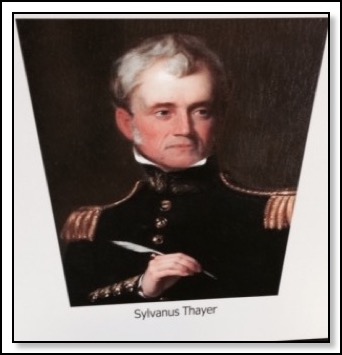

Jews in Denmark in World War II
03/04/14 10:29
Why did Denmark’s Jews escape the round up and capture to be sent to concentration camps that happened in other European countries? Why did the citizens of Denmark protect their Jewish population more and help many of them to escape from the Nazi overrule. A discussion of this can be found in an article here.
“And yet the question that has been nagging many people since the second world war is why the record of some nations appears to have been so much better than others. Why, for example, did more than 70% of Dutch Jews disappear into the death camps, while almost all the Jews in Denmark managed to get away safely?”
“And yet the question that has been nagging many people since the second world war is why the record of some nations appears to have been so much better than others. Why, for example, did more than 70% of Dutch Jews disappear into the death camps, while almost all the Jews in Denmark managed to get away safely?”
Teenagers in Medieval Times
31/03/14 19:57
What does a person do with their teenager? Or is it troubled teenager? In these times, most do nothing, others take away privileges (driving, money, video games, etc.). Not very suitable punishments usually. Well, see what they did in medieval times in Europe to the young in their homes, usually the young men. They were apprenticed or indentured to others to learn skills or new trades. Maybe it was to get bad attitudes out of the home and sent somewhere else. Check it out here.
Top Battleships
30/03/14 09:59
Which are the top 5 battleships of all time? Which one would win a battle over another? It depends on the circumstances and who got in the first attack. Are there mismatches or truly matches of battleships. Check it out in this article in National Interest.
Viking Exhibit in London
29/03/14 08:43
The Vikings are part of the history of England. They fought and conquered much of England, Ireland, and Scotland in territory. They went on to intermingle in the populace and would bring a large part of their culture with them that became a part of how the English progressed. The city of York in England has been hugely influenced by early Viking development. There is a fascinating museum there describing the impact. Now, the British Museum is having a display currently about the Vikings and this exhibition has been very well attended. One centerpiece is the frame of a 121 ft. Viking longship. We saw similar longships at the Viking Museum in Oslo. Read about the exhibition here. A bit of flavor for what is there.
“More than 50,000 visitors have so far absorbed the tales of wily Nordic gods, admired treasure hoards from as far afield as what is now Uzbekistan and shrunk from a warrior skull used to scare off enemies on the battlefield.
Vikings have long had a special place in British lore, not least as the guys who got there first. They roamed the seas and established far-flung trade links centuries before the British did. They enslaved and conquered and built an empire, albeit briefly, that included large swaths of England and Scotland. One of their descendants, the Norwegian explorer Roald Amundsen, even went on to beat Robert Falcon Scott to the South Pole in 1911.”
“More than 50,000 visitors have so far absorbed the tales of wily Nordic gods, admired treasure hoards from as far afield as what is now Uzbekistan and shrunk from a warrior skull used to scare off enemies on the battlefield.
Vikings have long had a special place in British lore, not least as the guys who got there first. They roamed the seas and established far-flung trade links centuries before the British did. They enslaved and conquered and built an empire, albeit briefly, that included large swaths of England and Scotland. One of their descendants, the Norwegian explorer Roald Amundsen, even went on to beat Robert Falcon Scott to the South Pole in 1911.”
Grant Not Short of Audacity
25/03/14 07:40
General U.S. Grant did not run around trumpeting “The Audacity Of Hope”. He just performed his job audaciously and quietly. He often was not always right in his methods in the short term but his perseverance in the long wore down the Southern armies and allowed the Northern armies to win. Another enjoyable article about Grant can be found here in the Weekly Standard.
Cats and Egyptian History
20/03/14 20:56
Were cats domesticated in Egypt much earlier than we previously knew? New bones of kittens excavated in Egypt say so. Read about it here.
“The skeletons of six cats, including four kittens, found in an Egyptian cemetery may push back the date of cat domestication in Egypt by nearly 2,000 years.
The bones come from a cemetery for the wealthy in Hierakonpolis, which served as the capital of Upper Egypt in the era before the pharaohs. The cemetery was the resting place not just for human bones, but also for animals, which perhaps were buried as part of religious rituals or sacrifices. Archaeologists searching the burial grounds have found everything from baboons to leopards to hippopotamuses.
The new find includes two adult cats and four kittens from at least two litters. The size of the bones and timing of the litters hints that humans may have kept the cats. The bones date back to between 3600 B.C. and 3800 B.C., which would be 2,000 years before the earliest known evidence of cat domestication in Egypt, archaeologists report in the May issue of the Journal of Archaeological Science.”
“The skeletons of six cats, including four kittens, found in an Egyptian cemetery may push back the date of cat domestication in Egypt by nearly 2,000 years.
The bones come from a cemetery for the wealthy in Hierakonpolis, which served as the capital of Upper Egypt in the era before the pharaohs. The cemetery was the resting place not just for human bones, but also for animals, which perhaps were buried as part of religious rituals or sacrifices. Archaeologists searching the burial grounds have found everything from baboons to leopards to hippopotamuses.
The new find includes two adult cats and four kittens from at least two litters. The size of the bones and timing of the litters hints that humans may have kept the cats. The bones date back to between 3600 B.C. and 3800 B.C., which would be 2,000 years before the earliest known evidence of cat domestication in Egypt, archaeologists report in the May issue of the Journal of Archaeological Science.”
Fascism and Communism
17/03/14 20:43
Jonah Goldberg has written a number of articles and a book about the twin political beliefs, fascism and communism. In this article, he gives the argument again that a political theories, they are not opposites as many portray them. They are actually closely related with different economic arms to that particular political philosophy. I agree with his take on it though I am sure there would be plenty of heavy debate on that statement. His article can be found here. The current situation occurring between Russia, the Ukraine, and the Crimea demonstrates quite nicely how this operates in real time.
First Black Medal of Honor Recipient
13/03/14 20:25
The National Gallery has had a display in recent history of photographs depicting the history and tale of .......
“Tell It With Pride: The 54th Massachusetts Regiment and Augustus Saint-Gaudens' Shaw Memorial," whose purpose is to dispel the shadows of anonymity surrounding a group of soldiers whose July 1863 assault on Fort Wagner in Charleston harbor was a turning point in the war.”
One of the photos shown is of William H. Carney who was a member of the 54th Massachusett’s Regiment and the first African-American recipient of the Medal of Honor. It was bestowed belatedly in 1900. The story of Mr. Carney and the other faces of courage can be found in this article.
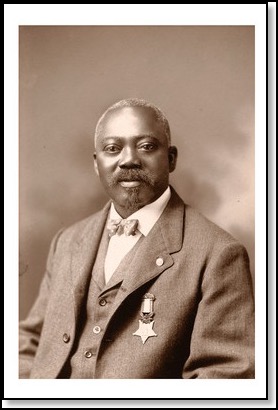
William H. Carney, a member of the 54th Massachusetts Regiment
and the first African-American recipient of the Medal of Honor.
Moorland-Spingarn Research Center, Howard University
“Tell It With Pride: The 54th Massachusetts Regiment and Augustus Saint-Gaudens' Shaw Memorial," whose purpose is to dispel the shadows of anonymity surrounding a group of soldiers whose July 1863 assault on Fort Wagner in Charleston harbor was a turning point in the war.”
One of the photos shown is of William H. Carney who was a member of the 54th Massachusett’s Regiment and the first African-American recipient of the Medal of Honor. It was bestowed belatedly in 1900. The story of Mr. Carney and the other faces of courage can be found in this article.

William H. Carney, a member of the 54th Massachusetts Regiment
and the first African-American recipient of the Medal of Honor.
Moorland-Spingarn Research Center, Howard University
Hitler versus Stalin
05/03/14 20:28
I have written previously about a very good history professor and author, Timothy Snyder. He is a professor at Yale University and has considerable expertise on the Eastern European sphere of World War II. He currently has an article about how we should view the acts of Hitler versus Stalin. Who might be worse? Are the shear numbers of people killed more horrendous than the way they were killed? Did the killings overlap in some countries and could be attributed in some manner to both men? Even out of these numbers, even the difference of one is a human soul that should be mourned. It takes a lot of “ones” to add up to the millions lost. Snyder claims that the numbers attributed to Stalin may be less than surmised since more came back from the Gulag alive than previously reported. Yet, the numbers lost before the war were great and often not considered to the level of casualties during the war. Please read his work here.
James A. Garfield
19/02/14 10:54
On an interesting note, there is a recent article that offers some background and history about James A. Garfield, the 20th President of the United State, did not want to be President or at least try to maneuver his way into the position. Garfield was a general in the Civil War and acquitted himself admirably. He went on to become a Senator from Ohio before supporting another as the Republican candidate for the presidency. Garfield was the compromise choice of the convention. He tragically was assassinated by a disgruntled office seeker. With the political egos we have present now, will we ever see an honest person who did not promote their candidacy as President?
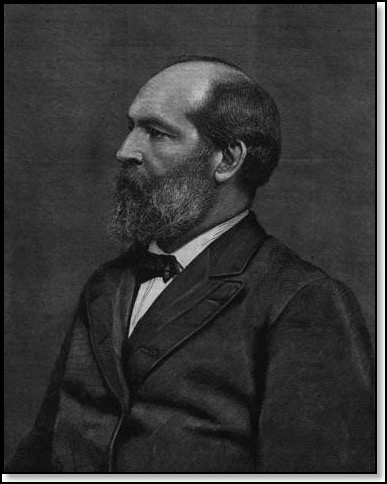

Early Human Footprints
13/02/14 12:49
Scientists have found the earliest evidence of human footprints outside of Africa. The prints were found on the Norfolk Coast in the eastern part of England. The footprints are considered more than 800,000 years old and were found on the shores of Happisburgh. They believe that there may have been a land bridge in that area to the western shore of France.
A more detailed description can be found here.
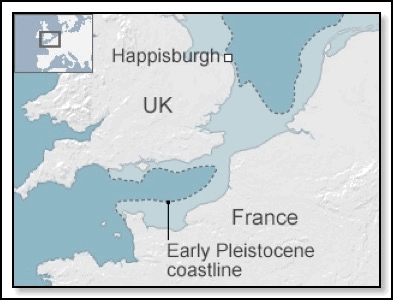
A more detailed description can be found here.

Richard III and DNA Testing
12/02/14 12:40
I have written a few times about the finding of Richard III’s skeleton under a carpark in mid-England at Leicester. The last reference was just a few days ago when I mentioned the determination that Charlemagne’s bones were most likely truly his. The researchers at the University of Leicester have decided that they will try to have Richard III’s DNA sequenced. They believe it will help them determine his history and health. a description of the plan can be read here.
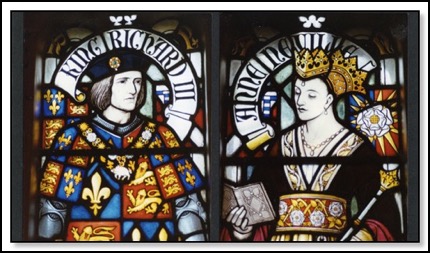

Battle of the Bulge
10/02/14 13:59
Reading World War II history is fascinating. Certainly the particulars of the final push of Nazi German to regain ground and the momentum against the western Allies in the Battle of the Bulge is one such description. A very nicely put together and concise history of this part of the war can be found here at the historyplace.com.
Charlegmagne
08/02/14 10:30
Reports indicate that the bones on display at a German Cathedral said to be of the Frankish King, Charlemagne, are likely authentic. Interesting information following the finding of Richard III of England’s bones. We are connecting with medieval history through current research and technology. One can read the report here.
“Sometimes called the "Father of Europe," Charlemagne stabilized much of mainland Europe after a long period of decline following the late fifth-century breakup of the Roman Empire. Besides being a great military leader, he ushered in the Carolignian Renaissance, a cultural revival marked by a boom in the arts and education reform. Charlemagne became the first Holy Roman Emperor when he was crowned by Pope Leo III on Christmas Day in A.D. 800.
Though he was the son of "Pippin the Short," Charlemagne was said to have an impressive physique. Rühli was involved in a study of the king's tibia in 2010, published in the journal Economics and Human Biology, finding that Charlemagne would have stood about 6 feet (1.84 meters) tall, towering over 98 percent of the population of his day.”
“Sometimes called the "Father of Europe," Charlemagne stabilized much of mainland Europe after a long period of decline following the late fifth-century breakup of the Roman Empire. Besides being a great military leader, he ushered in the Carolignian Renaissance, a cultural revival marked by a boom in the arts and education reform. Charlemagne became the first Holy Roman Emperor when he was crowned by Pope Leo III on Christmas Day in A.D. 800.
Though he was the son of "Pippin the Short," Charlemagne was said to have an impressive physique. Rühli was involved in a study of the king's tibia in 2010, published in the journal Economics and Human Biology, finding that Charlemagne would have stood about 6 feet (1.84 meters) tall, towering over 98 percent of the population of his day.”
More Ukraine
31/01/14 20:14
Top 10 Bad Decisions of 20th Century
28/01/14 10:15
Here we go again, another Top 10 list. This one is the Top 10 bad decisions of the 20th Century. They all seem to be related to wartime decisions. It is interesting to consider a counterfactual scenario of what would have happened if that decision or that action did not happen. I think the list is all justifiable as determined. Some may shift one item out and another in as they consider what is important to them. The list can be found here.
10 Myths about World War I
25/01/14 09:02
I have a fascination with military history, especially the World Wars. The first or the Great War has become more of an interest after early reading in my life focusing on the Second. So I often click and focus on writings about World War I. I came across this on about the Top 10 Myths regarding World War I found in BBC Magazine. I am not sure I quite accept all of them as they do. It is always good to debate and not take statements as absolutes. We should challenge or keep reading and studying. Maybe I can someday make a more informed or determined decision about whether I agree with their list.
Alfred the Great Remains Found Now?
20/01/14 20:26
Just as I have written in prior blogs, Richard III’s, King of England, remains were located in the past few years under a parking lot in England. Now they have found remains that they feel could be of King Alfred the Great of England. A description of Alfred follows..........
Alfred is the only English king to carry the moniker, “Great,” and is known for his passion for education, which was instrumental in the development of the English language. He ruled the kingdom of Wessex in southern England from 871 until his death in 899.
More information about where the bones were located and why they assume they are Alfred’s can be found here.
Alfred is the only English king to carry the moniker, “Great,” and is known for his passion for education, which was instrumental in the development of the English language. He ruled the kingdom of Wessex in southern England from 871 until his death in 899.
More information about where the bones were located and why they assume they are Alfred’s can be found here.
2014, Another Great War?
01/01/14 20:03
I have touched on this subject in recent posts, even the one yesterday. What is we were to have a Great War this year, 100 years after the last? Could we? Are the circumstances leaning that way? Here is an article discussing if it could happen and that it would have to entail the United States and China to come close to the impact of the Great War, being they are two super powers who could make the difference. Take a read. See what you think.
Did the West Lose Control in 1888?
31/12/13 09:16
Another counterfactual article written about historical events of the 19th and 20th Centuries. The premise of this article is that the death and short reign of Frederick III of Germany led to the build up of hostilities of World War I. The reason is that Frederick III was a reformer and a liberal. He would have led Germany away from a militaristic build up in attitude and materials. Since he died slightly over 3 months into his reign, his son, Kaiser Wilhem II who was quite militaristic and confrontational, led Germany into pacts with other nations that in the long run led to inevitable war in 1914. The issue is that we still may have had war or revolution in Russia, possibly Germany and Britain due to the build up of socialist and communist revolutionaries. Their point also being that the devastation of World War I led to the opportunity of Hitler’s control of Germany and therefore, World War II. Crisis and economic turmoil lead to further destabilization and revolution which occurred throughout much of the 20th Century and into current times.
Whittaker Chambers
28/12/13 15:16
Over the years, I had heard and read a number of references to the Cold War hearings regarding the Communist infiltration of higher levels, one such person being Alger Hiss. He had been tabbed for his Communist activities during their earlier working and friendly relationship by Whittaker Chambers. Chambers left the Communist Party and was an editor for Time for a decade before all of this settled out. The denouncement has been a hotly contested through decades because Hiss greatly denied the claim. He was proven to be a liar and was convicted of perjury due to lying to a Congressional committee. Time and new information has shown that Chambers was telling the truth and Hiss was lying. Chamber wrote a well-known book called Witness which has been in print since its first publication. I finally decided to read the book and am into a follow up study called Perjury: The Hiss-Chambers Case by Allen Weinstein. They both are fascinating and Witness is well worth reading. So much of what he saw in the attacks on his honesty and character are what we see today if Democrats or liberals are backed into a corner. He talks about revolution and refers to the New Deal as a revolution in this country. We may be seeing the same now in the transformation of progressivism occurring. This is not something I am in favor of and hope that it will not happen the way it is planned. The blog article that got me looking deeper into what Whittaker Chambers brought to our way of life by being a “Witness” is found here.
World War I Counterfactual
26/12/13 20:19
2014 will be the 100th anniversary of the start of World War I, the Great War. One article today in the Guardian discusses what might have been the fate of the world or at least the European Continent if the Germans had won the war instead of lost. It is possible their suppositions could be the way it would have gone. I would surmise that the Bolshevik Revolution or Communism would have taken even better root in England or maybe in Germany. The plan of Marx was that Germany then England would be the initial staging for his revolutionary concepts in the proletariat. To read this counterfactual, go here.
Thomas Paine in 1776
23/12/13 10:11
On this day in 1776, Thomas Paine wrote his pamphlet, American Crisis. The words were ordered to be read to the troops by George Washington before they crossed the Delaware River to attack Trenton.
“These are the times that try men’s souls. The summer soldier and the sunshine patriot will, in this crisis, shrink from the service of his country; but he that stands it now deserves the love and thanks of man and woman. Tyranny, like hell, is not easily conquered. Yet we have this consolation with us, that the harder the conflict, the more glorious the triumph.What we obtain too cheap, we esteem too lightly: ’tis dearness only that gives every thing its value. Heaven knows how to put a proper price upon its goods, and it would be strange indeed if so celestial an article as freedom should not be highly rated........
Let it be told to the future world, that in the depth of winter, when nothing but hope and virtue could survive, the city and the country, alarmed at one common danger, came forth to meet it and repulse it.......I love the man that can smile in trouble, that can gather strength from distress, and grow brave by reflection. “Tis the business of little minds to shrink;but he whose heart is firm, and whose conscience approves his conduct, will pursue his principles unto death.”
“These are the times that try men’s souls. The summer soldier and the sunshine patriot will, in this crisis, shrink from the service of his country; but he that stands it now deserves the love and thanks of man and woman. Tyranny, like hell, is not easily conquered. Yet we have this consolation with us, that the harder the conflict, the more glorious the triumph.What we obtain too cheap, we esteem too lightly: ’tis dearness only that gives every thing its value. Heaven knows how to put a proper price upon its goods, and it would be strange indeed if so celestial an article as freedom should not be highly rated........
Let it be told to the future world, that in the depth of winter, when nothing but hope and virtue could survive, the city and the country, alarmed at one common danger, came forth to meet it and repulse it.......I love the man that can smile in trouble, that can gather strength from distress, and grow brave by reflection. “Tis the business of little minds to shrink;but he whose heart is firm, and whose conscience approves his conduct, will pursue his principles unto death.”
The Great War's Echoes?
22/12/13 19:51
Are we cruising close to many of the same issues and triggers that lead up to the Great War, aka World War I. This war affected the European continent to an unbelievable extent. So much of the fruit of youth was annihilated on the battlefield and in the trenches. 100 years later we are still dealing with the fall out of policies and colonial decisions that affected a large part of that area of the world. Some feel we are looking at many of the same scenarios and problems that set the world ablaze then. Are we? Could we repeat many of the same mistakes? Are we Balkanizing and forming alliances that could hurt us later? This is one opinion page’s take on the possibility.
The Tea Party
16/12/13 10:55
In 1773, a motley group of individuals called the Mohawks (not the tribe) made their way to the wharf in Boston harbor. They climbed on board the Dartmouth, the Eleanor, and the Beaver, British vessels all and began to toss chests of tea onto the deck, breaking them open and tossing tea into Boston Harbor. I bet this was a bit of cold work (unless they were warmed by alcoholic beverages). King George III was not happy and coaxed the British Government to establish the Intolerable Acts. Things progressed from there and the rest is U.S. history.
The Bill of Rights
15/12/13 20:15
On this day in 1791, the state of Virginia was the last state to ratify The Bill of Rights or 10 Amendments to the Constitution. It is good to remember what they stand for and how they came about. It seems as if a number of politicians in charge have lost the sense of what this all stands for and assumes it means the right for them to grab and maintain power versus preserving the freedom and rights of the people of the Unites States. Long live the Constitution and our Bill of Rights.
Thomas Jefferson once wrote to Madison, “A bill of rights is what the people are entitled to against every government on earth........and what no just government should refuse”. Would that our current government not avoid and trample on that concept.
Thomas Jefferson once wrote to Madison, “A bill of rights is what the people are entitled to against every government on earth........and what no just government should refuse”. Would that our current government not avoid and trample on that concept.
Pearl Harbor Memories
07/12/13 14:31
Today is December 7 and the 72nd anniversary of Pearl Harbor.
There are some interesting reminders of what happened at Pearl Harbor and the impact it had on each family.
The first is a column that links to about the only color film footage of the attack that day. You can see the short intro and video on Powerline Blog here.
I was also sent the link to an article written by a cousin about Pearl Harbor and how we should never forget. He writes about how his father (the person who sent the link) felt the need to enlist. His father grew up in the area of Lynch NE where my mother and grandparents came from. The father is my grandmother’s nephew and the son of one of her favorite sisters, a woman who died of “dust pneumonia” at too young an age. Family history is always with us.
There are some interesting reminders of what happened at Pearl Harbor and the impact it had on each family.
The first is a column that links to about the only color film footage of the attack that day. You can see the short intro and video on Powerline Blog here.
I was also sent the link to an article written by a cousin about Pearl Harbor and how we should never forget. He writes about how his father (the person who sent the link) felt the need to enlist. His father grew up in the area of Lynch NE where my mother and grandparents came from. The father is my grandmother’s nephew and the son of one of her favorite sisters, a woman who died of “dust pneumonia” at too young an age. Family history is always with us.
Aaron Burr
02/12/13 10:19
Aaron Burr was alternatively an American Statesman, once Vice President of the United States, and an opportunist bordering on traitor. He is well-known for killing Alexander Hamilton in a duel before his life went further into disarray. I came across a short article that gave a synopsis of his history and describes how we as ordinary people in our lives and surroundings may cross paths with parts of history. Sometimes we know it is happening, other times we may be unaware.
Interesting Factoid
27/11/13 20:41
Here is an interesting little tidbit about the second-in-command of a submarine who saved the world on October 27, 1962. It was the Cuban Missile Crisis and the world was on edge. The wrong move would have set many areas on fire.
“50 years ago, at the height of the Cuban Missile Crisis, second-in-command Vasilli Arkhipov of the Soviet submarine B-59 refused to agree with his Captain’s order to launch nuclear torpedoes against US warships and setting off what might well have been a terminal superpower nuclear war.”
Read the rest here.
“50 years ago, at the height of the Cuban Missile Crisis, second-in-command Vasilli Arkhipov of the Soviet submarine B-59 refused to agree with his Captain’s order to launch nuclear torpedoes against US warships and setting off what might well have been a terminal superpower nuclear war.”
Read the rest here.
Conspiracy Theories Debunked
25/11/13 09:45
I downloaded a few days ago the book, “A Cruel and Shocking Act: The Secret History of the Kennedy Assassination”. It seems to be starting off as a well-written read and interesting from its perspective of information lost or suppressed. Much of this information lost has fed into the development of conspiracy theories. Here is an article that debunks the most persistent of those theories. From that article.........
“Then, one day, I looked up the footnotes in those books, most of them leading me to the multivolume hearings of the Warren Commission. I was shocked. The authors had taken witnesses’ statements out of context, distorted them beyond recognition, and in some cases cherry-picked passages that seemed to back their theories while ignoring testimony that didn’t. It was my first brush with intellectual dishonesty.
There’s no space to launch a full rebuttal of the conspiracy theorists. (It took 1,632 pages for Vincent Bugliosi to do that in his 2007 book Reclaiming History.) But it’s worth recounting the conspiracy buffs’ arguments that I found most persuasive—and why they collapse under scrutiny.”
“Then, one day, I looked up the footnotes in those books, most of them leading me to the multivolume hearings of the Warren Commission. I was shocked. The authors had taken witnesses’ statements out of context, distorted them beyond recognition, and in some cases cherry-picked passages that seemed to back their theories while ignoring testimony that didn’t. It was my first brush with intellectual dishonesty.
There’s no space to launch a full rebuttal of the conspiracy theorists. (It took 1,632 pages for Vincent Bugliosi to do that in his 2007 book Reclaiming History.) But it’s worth recounting the conspiracy buffs’ arguments that I found most persuasive—and why they collapse under scrutiny.”
Losing JFK 50 Years Ago
22/11/13 09:46
Here is my recollection. I was in 6th grade when someone from the school office came in to tell our teacher that President Kennedy had died. My teacher, Mrs. Walton, then shared the news with us. The reaction was much the same as for many all over the country and world............shock and incredible sadness and loss. I remember riding the school bus and being one of the few who supported Kennedy against Nixon when talking about the election with other students. Yes, we were interested even in those young years. I remember all the concerns about his Catholicism. They held the anniversary memorials today at Dealey Plaza in Dallas and at Arlington Cemetery near Washington DC.
Books (and articles) have been written and will continue to be so written. One recent article that was interesting about Oswald and his interest in Castro can be found here. Another article discussing the connection the author had with President Kennedy and also Lee Harvey Oswald is found here. Her book is called Marina and Lee and should be a good book to obtain.
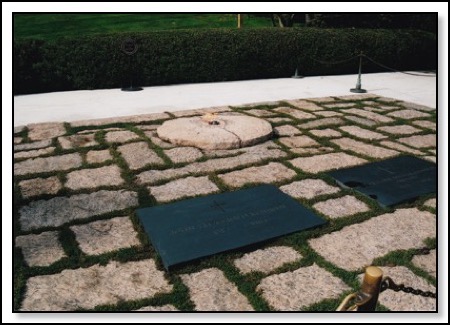
Books (and articles) have been written and will continue to be so written. One recent article that was interesting about Oswald and his interest in Castro can be found here. Another article discussing the connection the author had with President Kennedy and also Lee Harvey Oswald is found here. Her book is called Marina and Lee and should be a good book to obtain.

The Generals
21/11/13 07:17
The article to be found here is a review of the book, The Generals: American Military Command from World War II to Today, by Thomas E. Ricks. The review appears to be critical of the book and its delivery of this information. The review itself is an interesting read.
“The central claim of The Generals, military journalist Thomas Ricks's assault on post-World War II American military history, is that once upon a time the U.S. Army won because poor generals got fired. Since then, Army generals stopped getting fired so much, and now the Army does not win wars.”
“The central claim of The Generals, military journalist Thomas Ricks's assault on post-World War II American military history, is that once upon a time the U.S. Army won because poor generals got fired. Since then, Army generals stopped getting fired so much, and now the Army does not win wars.”
150th Anniversary of Gettysburg Address
19/11/13 10:47
Today is the 150th Anniversary of Lincoln’s Gettysburg Address. This is the greatest speech ever given in my opinion. Evidently, not so much in contemporary times since a newspaper of a neighboring town just apologized this year for writing an editorial that the speech would not amount to anything and Lincoln should apologize for giving it and withdraw it. Now it is enshrined in the Lincoln Memorial. It would have been a dream come true if Bob and I could have been there for the ceremony.
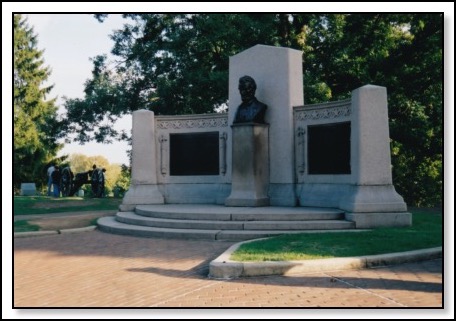

The Cenotaph
14/11/13 09:42
One example of the simplicity and power of a war memorial is described in the article about the Cenotaph. A description of how the Cenotaph came to be follows.........
“With the signing of the peace treaty at Versailles in 1919, the War Cabinet, led by Prime Minister David Lloyd George, planned Peace Day. This was to be a festive celebration of the end of the carnage. The government Office of Works, under the direction of Alfred Mond, asked Edwin Lutyens to design a temporary memorial to be erected in Whitehall, along the route of a massive victory parade of the allied troops through central London. Lutyens, who had made his mark designing handsome country homes, was the architect of the new capitol of the British Raj in New Delhi, a commission that had catapulted him to international fame.
Just two weeks after hearing from Mond, Lutyens had a plan in hand, one deeply rooted in the classical past, not only in form but in function. The monument was to be a cenotaph, a structure incorporating an empty tomb, often built to memorialize a missing warrior. Constructed of wood and plaster, Lutyens's four-sided composition, which ascended through a series of subtle setbacks toward a summit capped by a sarcophagus, was ready for the Peace Day victory parade of July 19, 1919.”
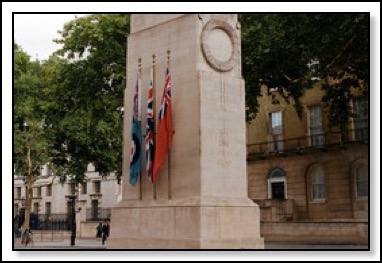
“With the signing of the peace treaty at Versailles in 1919, the War Cabinet, led by Prime Minister David Lloyd George, planned Peace Day. This was to be a festive celebration of the end of the carnage. The government Office of Works, under the direction of Alfred Mond, asked Edwin Lutyens to design a temporary memorial to be erected in Whitehall, along the route of a massive victory parade of the allied troops through central London. Lutyens, who had made his mark designing handsome country homes, was the architect of the new capitol of the British Raj in New Delhi, a commission that had catapulted him to international fame.
Just two weeks after hearing from Mond, Lutyens had a plan in hand, one deeply rooted in the classical past, not only in form but in function. The monument was to be a cenotaph, a structure incorporating an empty tomb, often built to memorialize a missing warrior. Constructed of wood and plaster, Lutyens's four-sided composition, which ascended through a series of subtle setbacks toward a summit capped by a sarcophagus, was ready for the Peace Day victory parade of July 19, 1919.”

Revolutionary Writings
12/11/13 09:54
Thomas Paine (whose name was actually Pain) was an Englishman who came to adopt the fledgling United States as his home. His writings stirred the emotions of average people and patriot leaders. His works helped lead the way to revolution. To read more about him and “Common Sense”, check here.
Armistice Day
11/11/13 09:46
World War I is the war that set the table for many of the remaining wars of the 20th Century. Some may argue with that premise, I firmly believe it. We still are living with the consequences of the issues leading up to the War and the fall out for what happened during and after the war. So to read more about the beginning of the end and what happened at the 11th hour of the 11th day of the 11th month of 1918, you can find information here. We now refer to this day as Veteran’s Day. It’s roots are based in the tragedy engulfing Europe from 1914 to 1918.
Holodomor
10/11/13 08:54
In the Ukraine, they refer to it as the Holodomor. It refers to the time in the 1930s when Stalin decided to bring the Ukraine to heal under the Soviet yoke by starving much of the population. I have mentioned this in previous blogs when talking about the books Bloodlands and Savage Continent. Millions of people were starved, often to death, to achieve a better system overall for the Soviet totalitarian regime. Do we possibly have a milder form of that going on now with “We know what health care system is better for you than the horrible plan you had and didn’t know it” routine we hear on TV lately about Obamacare. A discussion about the Holodomor is found here.
Kristallnacht
09/11/13 08:49
November 9 is the 75th anniversary of the infamous Kristallnacht action in Germany against the Jews. One senses that a similar action may not be so far from happening in parts of the world now, especially in Germany. If the anti-Israel fervor gets any worse in the United States, it could be in our future too. An interesting article about 75 years ago today can be found here.
Agincourt
29/10/13 10:41
If you enjoy history and Shakespeare, the story of Henry V of England and the battle of Agincourt is exciting. A battle on St. Crispin’s Day won by a small army against a much larger one of France. Or did they? There is some question that the disparity was not as much as suspected. Read about how historians are looking at the battle and reassessing it here.
Seven Years' War
24/10/13 15:57
While we traveled around Nova Scotia and Cape Breton Island, we got a better understanding of two wars that affected that part of North America, the Seven Years’ War and the War of 1812. The Louisbourg Fortress was transferred to British hands at the end of the Seven Years’ War. An article that gives a good synopsis of this war on the Continent and in North America is found here.
Among the British, more war with the French seemed likely over their differences in the Americas. The British had taken control of a portion of France's colony in North America in 1710 (during the Queen Anne War of 1702-13), and they had renamed the area they had conquered Nova Scotia.
Among the British, more war with the French seemed likely over their differences in the Americas. The British had taken control of a portion of France's colony in North America in 1710 (during the Queen Anne War of 1702-13), and they had renamed the area they had conquered Nova Scotia.
A Holocaust Snippet
22/10/13 08:32
When you visit the Holocaust Museum in Washington DC, they give you a card of details of a holocaust victim to carry throughout your tour. The thought is to give you a connection to that person and what their life may have been like during this horrific period in our world’s history. This post reminds me of the card I carried during my one trip through. The photo and description of this 14-year old girl from Poland can bring the whole tragedy closer.
McClellan and Today
20/10/13 12:53
How does one be much loved or thought fondly of, yet be totally ineffectual and be put aside. Our current President could fit that bill and turn our current military leaders into the same type of people. One person in our history, George McClellan, was much loved by his men and still was a totally poor leader in warfare. He could not make a decision and take action until often odds were turned against him. A couple of articles about McClellan can be found here and here.
The Crater
16/10/13 09:28
Another spot we have visited in our Civil War site travels is the area around Petersburg Virginia and especially where the Battle of the Crater was fought. It was hoped by the Union Army that they could damage and breach the breastworks of the Confederate Army to achieve a breakthrough. It ended up a debacle and large loss of Union soldiers. Here is a description of the Battle of the Crater. A photo follows of part of the area where the battle took place and how it looks today.


John Brown's Beginnings
15/10/13 08:55
There is an interesting history piece about the early life of John Brown. It is written by Tony Horwitz who wrote “Confederates in the Attic”. The article gives some sense of why John Brown was an anti-slavery person with strong views on the issue. Bob and I have visited Harper’s Ferry and toured the town. We have seen the armory where John Brown and his sons attacked and were subsequently defeated and rounded up by Colonel Robert E. Lee.
A main street in Harper’s Ferry, looking toward the river and the armory would be to the right at the end.
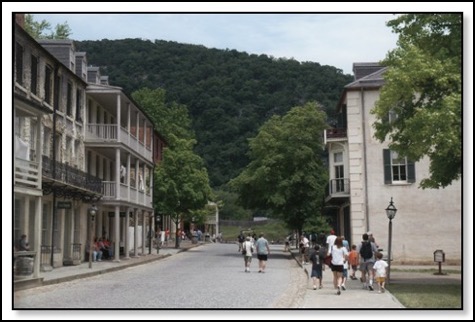
A main street in Harper’s Ferry, looking toward the river and the armory would be to the right at the end.

Misplaced Charter
13/10/13 09:10
Our country is going through a stressful time right now. As an earlier blog post mentioned, our President and his administration are doing their best to separate the people from the land and National Monuments. We can no longer go where we feel we should be able to access and visit. Mark Steyn touches on this topic a bit and how the President has broken an almost 900 year old portion of English law that an English king gave to his freemen subjects. This law was established two years after the Magna Carta was written, the basis of English law and our law too. He has rolled back the connection a supreme leader has with their people and the land. We are reversing to a despotic concept more in line with “divine right of kings”. The article can be read here. The only argument I have with it is that is says that Henry II gave the Charter of the Forest to English freemen in 1217. It was Henry III, the son of King John the king -who had to accept the basis of the Magna Carta due to his despotic rule over his noble subjects.
Richard III and Travelers
08/10/13 09:34
The finding of Richard III of England’s remains has been an intriguing bit of news in recent times. Maybe his winter of discontent was made possible by being infected by roundworm. According to news stories, they have found roundworm eggs in the soil where his intestines would have lain. The parasites were probably well fed since he was king. Was he less content by carrying them? Maybe Shakespeare had the inside track or knowledge. Hmmmmm?
In September, 2012, Richard's remains were excavated and sediment samples were taken from the sacral area of his pelvis, and control samples from his skull and the soil outside the grave cut. The results showed the presence of multiple roundworm eggs (Ascaris lumbricoides) in the sacral sample, where the intestines would have been during life.
In September, 2012, Richard's remains were excavated and sediment samples were taken from the sacral area of his pelvis, and control samples from his skull and the soil outside the grave cut. The results showed the presence of multiple roundworm eggs (Ascaris lumbricoides) in the sacral sample, where the intestines would have been during life.
Colorized Civil War Photos
07/10/13 09:45
Two individuals, one from Great Britain and the other from Denmark, have developed a method to colorize photos from the Civil War. They really have brought that part of history to life and made it even more enjoyable and interesting. The article that brought it to my attention is here. They have links to other articles where additional photos can be found.
Happy explorations! A photo of General USS Grant.
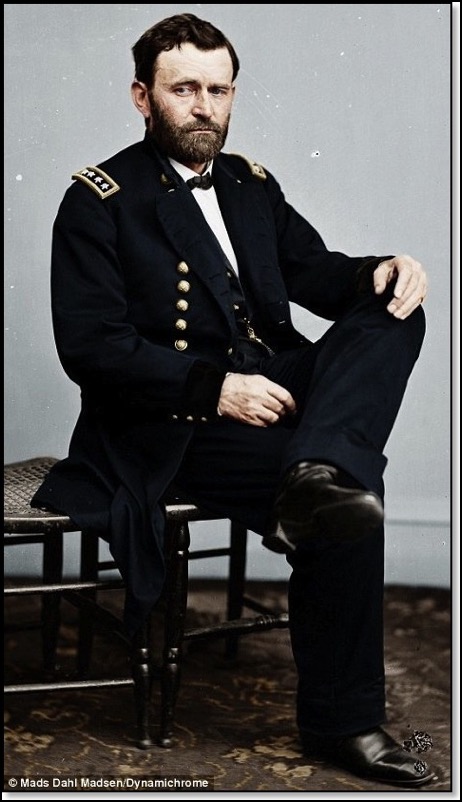
Happy explorations! A photo of General USS Grant.

An Interesting Life
24/09/13 09:52
Louis Mountbatten was closely related to the Royal Family of Great Britain. His life’s story is very much tied to the 20th Century’s look at the Empire of Great Britain, especially related to India. His daughter, Lady Pamela Hicks, has written her biography that includes a look at her family and their part in this history. One can read about the book here.
Lincoln on Jefferson
19/09/13 20:11
Inchon Landing
15/09/13 20:04
Today is the anniversary of the Inchon Landing General MacArthur performed in the Korean War. This was considered quite a coup for the United States in the war. Unfortunately, the significant benefit the landing gave the U.S. in this war was not maintained and in the long run, the war slipped into an Armistice with the peninsula split into North and South Korea. A short description of the Inchon Landing is found here.
Korean War Memorial in Washington DC
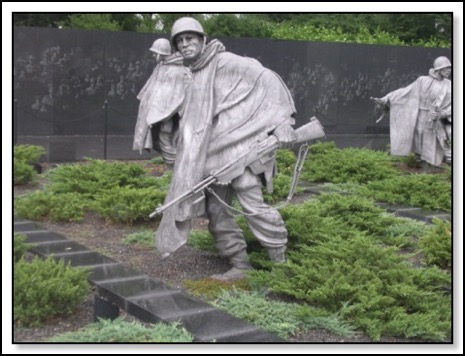
Korean War Memorial in Washington DC

Victory Japan Day
14/09/13 20:15
A reminder of what the day looked like in Japan when the end of that theatre of war came and victory was declared. Just a half a world away and 3 years from yesterday’s blog on the Dieppe raid.
Dieppe
13/09/13 20:08
There was a military raid or intervention during World War ll that was a serious day of loss for Canadians much like Dunkirk was for the British. It was at Dieppe in France on August 19, 1942 and it lead to a large number of casualties and prisoners. Information can be found about the Dieppe raid at two sites, here and here.
9-11, the 12th Anniversary
11/09/13 10:55
September 11, 2001 got the closest to us when we had to fly to Baltimore a few weeks after the attack. Many people were nervous to fly at that time and we met many people who wondered why people from California would come back East then. Especially those people we met in Washington D.C. An example of the impact at that time of what the terrorist did is this photo I got from Arlington Cemetery of the damage to the Pentagon from Flight 77.
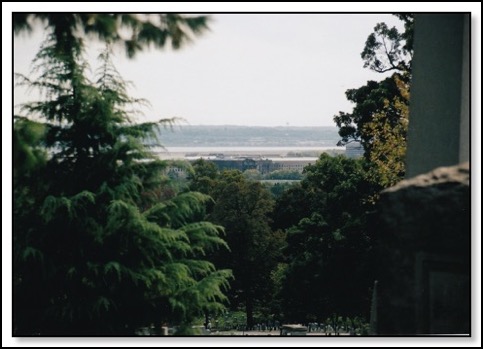

The Arabia
10/09/13 10:47
There is an interesting story online about the finding of a Mississippi River boat that had sunk in 1856 and quickly buried in the river silt. Individuals have excavated and salvaged the site using their own money. It cost at least $1 million to do this and they then have set up a museum in a local abandoned vegetable warehouse. To clean and display all the items from the paddle wheeler will take another 30 years of work. Read about it here.
Hardware salvaged from the Arabia

Hardware salvaged from the Arabia

Bobby and Billie Jean
31/08/13 13:11
Forty years ago this month, Bobby Riggs and Billie Jean King played a tennis match against each other. The match was billed as a man’s ability against a woman’s. It was a very much hyped news event. Since our wedding anniversary is tomorrow, it is hard to believe this match was played shortly after we got married and were back to college.
The big news is that Bobby Riggs “threw” the match to help pay his gambling debts or that is the rumor. An interesting story and remembrance of the match is found in this ESPN article.
The big news is that Bobby Riggs “threw” the match to help pay his gambling debts or that is the rumor. An interesting story and remembrance of the match is found in this ESPN article.
Edouard Daladier Moments
29/08/13 15:02
I comment frequently how I love history, especially certain time periods in history. I also enjoy a good writer and one that engages the imagination with the use of their words. The words will paint images that add to what is being said. One example that is a mix of current affairs and a historical take on the run up to World War ll is found in this article. The author and blogger Diplomad is one of the writers I just described. The article to me is a well written piece and makes it point(s) well.
Dyatlov Pass, Siberia
26/08/13 20:50
A little more than 50 years ago, nine Soviet students went missing from their campsite in Siberia. They had been on a trek through mountains to do some skiing. They left their tents in a mysterious way of slashing the walls to get out from the inside. No one knows what drove them to do this and to wander into wilderness. Their bodies were found later quite a ways from the camp site. It has been considered a very eerie mystery. A movie has been made of the puzzle and no further conclusions came up. For now, there still remains Why? To read more about Dyatlov Pass and the “Mountain of the Dead”, read here.
Gibraltar
16/08/13 09:05
There have been recent news articles about border crossing disagreements between Spain and the island of Gibraltar. Gibraltar has been under the control of Great Britain since it was given to them under the Treaty of Utrecht in 1704. Spain would like to have control of the Rock back. Gibraltar has given Great Britain the ability to grow their naval empire of earlier days due to access and control of the Mediterranean and the Atlantic Ocean. For more information about this area of history and geopolitics, you can read this article.
Manson
10/08/13 10:47
A new book has just been published about Charles Manson. A review of the book and a bit of discussion about Charles Manson’s psyche and predatory behavior is covered in this New York Times Book Review. Certainly one of the scariest true crime books, “Helter Skelter”, is by Vincent Bugliosi who prosecuted Manson and his followers. It delves into the crazy and dark side of human nature, drugs, and insensibility of murder. To read the review, please check it out here.
Acadia
09/08/13 10:36
Just a short reminder of a sad yet interesting bit of history………..the dispersement of the Acadians from Nova Scotia in 1755. This article gives a short synopsis of the times and why it happened. A much larger and well-written book is “A Great and Noble Scheme” by John Mack Faragher and is highly recommended to be added to a library. The heart wrenching poem of Longfellow, Evangeline, is based on Le Grand Derangement.
Evangeline at Grand Pre……..L’Acadie!
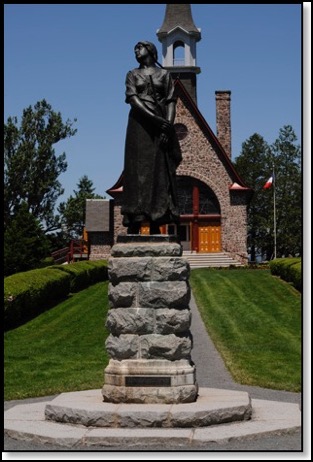
Evangeline at Grand Pre……..L’Acadie!

Warren Harding
04/08/13 10:51
As one delves into history and the “what ifs” and “how did that happen” scenarios, there is an interesting article on the internet about the strange life and death of President Harding. He died in unclear circumstances in a hotel room in San Francisco. His wife did not allow an autopsy. As I read through the story I get a sense of similarities to President Obama, at least in the area of cronyism and people allied to the Administration who take advantage of their status to do benefit to themselves. For a good read, check here.
President Warren G. Harding
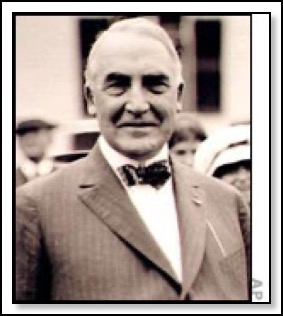
President Warren G. Harding

Rosetta Stone
03/08/13 21:30
One of the ways Bob and I have determined is someone is somewhat knowledgable about history or even interested in learning is to ask what they think about the Rosetta Stone. No, I am not talking about the language learning product for sale on TV. We mean the real Rosetta Stone found by Napolean’s soldiers while on expedition in Egypt. The Rosetta Stone was a piece of stone issued around 196 BC on behalf of Ptolemy V that had translations from hieroglyphics to Demotic script to Ancient Greek. Without the stone, we would not have been able to translate hieroglyphics into a more modern language for understanding. It was a fabulous find in archeology and is located in the British Museum in London. One of the highlights of our time there was visiting the museum and seeing the Rosetta Stone. Here is Bob standing next to the Rosetta Stone.
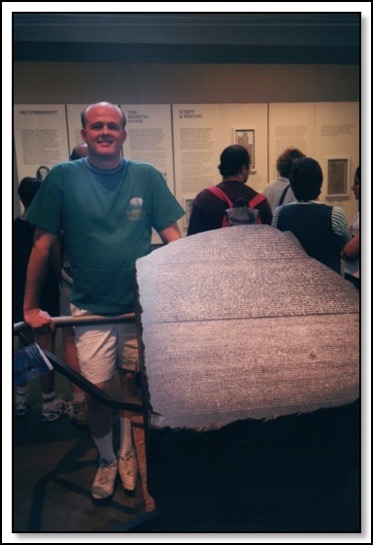

Ukraine's Legacy
02/08/13 15:00
Two fascinating, informative, and disturbing books I have read are “Bloodlands, Europe between Hitler and Stalin” by Timothy Snyder and “Savage Continent” by Keith Lowe. Both deal with the disruption to the peoples in the region of Poland, Belarus, and the Ukraine. Bloodlands is particularly disturbing in the description of the nearly constant battle over this region between Germany and the Soviet Union. Jews in particular were at risk from both countries and the horror along with the loss of life is appalling. Both books are a must read in my opinion. To see what the legacy is still present in this area more than 65 years later can be found in this article.
Richard III of England Redux
01/08/13 14:44
There is further information that has come to light or at least another coffin come to light at the Richard III of England gravesite. As described in this article and below……….(later on the remains in the coffin were identified in this story).
A team of archaeologists said Monday it has unearthed an unusual coffin-within-a-coffin in the central England parking lot where it found the skeleton of King Richard III, and that they hope to identify the remains within.
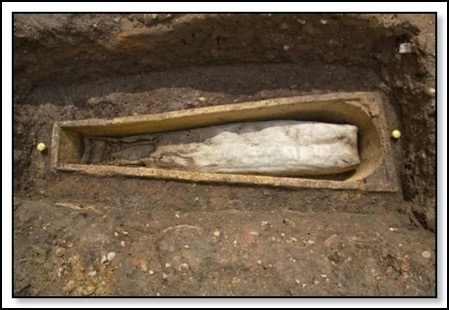
A team of archaeologists said Monday it has unearthed an unusual coffin-within-a-coffin in the central England parking lot where it found the skeleton of King Richard III, and that they hope to identify the remains within.

USS Indianapolis and Jaws
31/07/13 16:07
“Man goes into the water…….shark is in the water…….” One of the famous scenes was when Captain Quint in Jaws described being a navy sailor on the USS Indianapolis at the end of World War II after delivering the atomic bomb to Tinian. The ship was sunk by a Japanese sub and sharks got many of the men left trying to survive in the water. To learn more about the USS Indianapolis and watch the scene from Jaws, go to this link on Ace of Spades.
Lincoln Memorial
26/07/13 09:25
It was very upsetting to hear that vandals splashed green paint on the Lincoln memorial statue and the granite around the it inside the larger Memorial building. This is such a wonderful, historical site in Washington DC. It is beyond criminal to do such damage to this spectacular part of U.S. history. Here is a link to a recent post on Lincoln and the Memorial.
Lincoln looking over his people at the Memorial
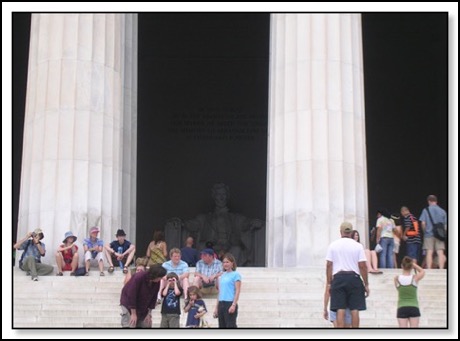
Scott at Lincoln’s statue (in memory of Abraham Lincoln) in July, 2007
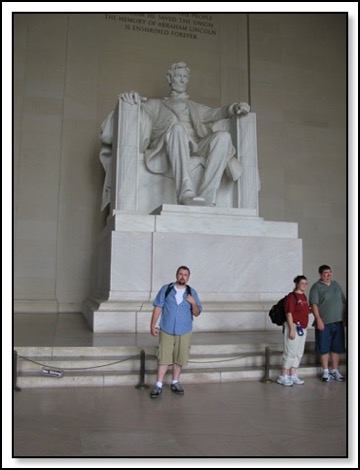
Lincoln looking over his people at the Memorial

Scott at Lincoln’s statue (in memory of Abraham Lincoln) in July, 2007

First Bull Run
25/07/13 09:49
A good portion of the area where the Bull Run/Manassas battles took place are under freeways and shopping malls. They have managed to preserve some of the battlefield areas near Centreville in Virginia. Bob and I did visit this area when we traveled to Virginia Civil War sites in 2001. There were two different significant battles in this area, both were overall losses or routs for the Army of the Potomac. A good description of the First Bull Run battle is found here. I believe that the North liked to name battles after water source or geography close by and the South liked to name the battle after the town or community near where it took place.
Mary, Queen of Scots
24/07/13 09:12
Now on to another individual who also lost her head, but for another reason. At least I don’t remember anyone counting her as a vampire. More a woman who could not keep her head or common sense around men. I have several books in my library about Mary and her history. Bob and I have visited Linlithgow Palace where she was born and also Falkland Palace where her father, James V, died and she later lived. We have visited Holyrood House in Edinburgh where she reigned and much of her scandalous history occurred. Read about Mary here.
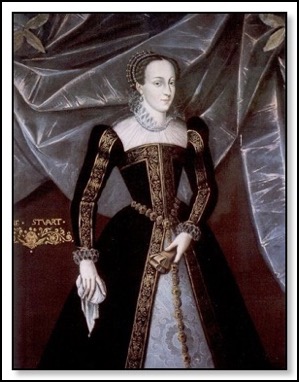
Mary, Queen of Scots

Holyrood House, Edinburgh, Scotland

Mary, Queen of Scots

Holyrood House, Edinburgh, Scotland
Vampires Do Exist
23/07/13 09:00
Vampires do exist. At least in the minds of eastern European cultures from several centuries ago. In excavating burial sites, they have found some bodies with the skull separated from the body and placed between the legs. This is an old burial trick to keep the undead from rising to walk the earth again. Bodies in other locations have been found with metal stakes driven into the chest, another way to prevent the undead from leaving the grave. So, we just thought Bram Stoker had a very good, very scary story, heh? Bwaahaahaa!
Read about it here.

Read about it here.

The Eagle Has Landed at 44
22/07/13 20:11
I should have caught this and made note 2 days ago. It was the 44th Anniversary of the Moon Landing, or “The Eagle Has Landed” on Saturday. On that day 44 years ago, I was in West Berlin, Germany on a People to People Ambassador Tour. We saw the news on a television in the visiting are of the hotel we were at. As this article comments, it was a mere 66 years from the flight of the Kitty Hawk to the moon landing and walk. How unbelievable is that?!
Enjoy the memories.
Enjoy the memories.
The Spy Who Loved
21/07/13 10:53
Every now and then, a person comes across bits of lesser known history that fascinates and also is significant. I came across a book review describing spies from the time of World War II. One of the most useful and daring was a woman of Polish heritage who called herself Christine Glanville. From all descriptions, she was quite the woman who loved men and quite the derring-do spy.
Christine Granville was one of the bravest, toughest and strangest secret agents of World War II. Her feats of derring-do included acting as a courier in Nazi-occupied Europe, parachuting into France in support of the Allied invasion and rescuing three of her comrades from certain execution. She was said to be Winston Churchill’s favorite spy — a considerable accolade given how much Britain’s wartime prime minister liked spies. She may have been the model for Vesper Lynd, the female agent in Ian Fleming’s first James Bond novel, “Casino Royale.” She won medals for bravery from both Britain and France. Men found her irresistible, and she did very little to resist them. (from the NYTBR by Ben Macintyre)
Christine Glanville
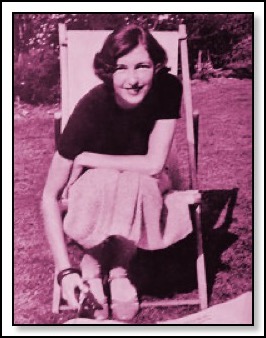
Christine Granville was one of the bravest, toughest and strangest secret agents of World War II. Her feats of derring-do included acting as a courier in Nazi-occupied Europe, parachuting into France in support of the Allied invasion and rescuing three of her comrades from certain execution. She was said to be Winston Churchill’s favorite spy — a considerable accolade given how much Britain’s wartime prime minister liked spies. She may have been the model for Vesper Lynd, the female agent in Ian Fleming’s first James Bond novel, “Casino Royale.” She won medals for bravery from both Britain and France. Men found her irresistible, and she did very little to resist them. (from the NYTBR by Ben Macintyre)
Christine Glanville

World War I Battle Deaths
16/07/13 09:34
Even almost 100 years later, the United States and Europe still feels the effect and remembers the crushing loss of so many promising lives during World War I. It seems as if every town and major city has a memorial to World War I in Great Britain, listing the names of the men who were lost from that community. This article lists the top battles of this war in the numbers of war deaths. To read through it is to give one a sense of why the memorials are still so important in those communities. We do not have a World War I memorial in Washington DC. Looking at the battles with the most loss of life, they occurred when the United States was part of the action. Maybe a stronger push should be made to create that memorial.
Hamilton
12/07/13 15:29
One book that Bob enjoyed to read was Ron Chernow’s biography on Alexander Hamilton. A brilliant, yet followed by scandal, individual. He contributed mightily to our country’s founding government and financial status. Here is an interesting short biographical sketch about Alexander Hamilton’s history. Another story about the pistols used in the Hamilton-Burr duel that may have lead to Hamilton’s untimely demise. The pistol may have been a “trick pistol” with a hair trigger.
Military Blunders
09/07/13 19:18
Gettysburg Aftermath
06/07/13 08:58
What followed Gettysburg? Armies retreating, burying the dead, tending to the injured. Lincoln attending a ceremony to honor the sacrifice of the dead soldiers and to deliver the Gettysburg Address. It was probably the most pithy and greatest speech ever given. We still consecrate those dead and remember 150 years later what happened on the ridges, dens, hilltops, and fields of Gettysburg.
Commemorative memorial to Lincoln at Gettysburg cemetery
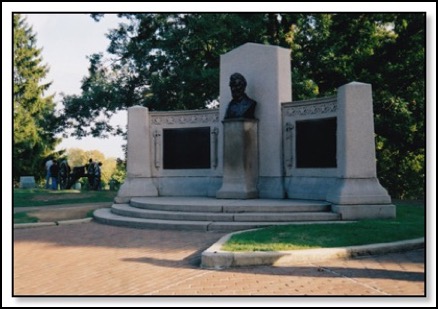
Gettysburg Address engraved at the Lincoln Memorial
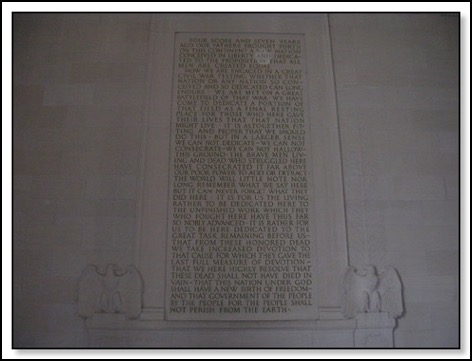
Battle of Gettysburg, Aftermath
On July 4, Lee started a 27-mile-long train of hospital wagons down the road to Virginia. His army halted at the flooded Potomac River and entrenched for another battle, but Meade’s army, too, was battered and exhausted and had consumed much of its ammunition. The Army of the Potomac did not pursue, for which Meade would be soundly criticized. He remained in command of that army for the rest of the war, even after Ulysses S. Grant was promoted to lieutenant general, placed over all Northern armies and attached himself to the Army of the Potomac. Lee offered his resignation to Confederate president Jefferson Davis, but it was refused and he, too, remained in command for the rest of the war.
Facts about the Battle of Gettysburg
Ammunition at Gettysburg: An estimated 569 tons of ammunition was fired during the three days of fighting.
Abraham Lincoln’s Gettysburg Address was delivered November 19, 1863, at the dedication of the “Soldiers’ National Cemetery” at Gettysburg. The speech was extremely short by the standards of the day and received scant notice at the time, but its concise, powerful wording has made it one of the best-known public addresses in all of history. Contrary to popular myth, Lincoln did not scribble the speech on the back of an envelope on his way to Gettysburg but wrote several drafts. The last bodies would not be retrieved from battlefield graves and reinterred in the cemetery until months after the dedication ceremonies.
John Buford, whose cavalry fired the first shots of the battle, died December 16, 1863. His death is thought to have resulted from typhoid fever and a body weakened by exhaustion. He received a deathbed promotion to major general, post-dated to July 1, 1863.
Civilians at Gettysburg were left to deal with the thousands of wounded. Homes and public buildings became hospitals, and diseases born of infection and unsanitary conditions made living in the town risky. Volunteers came from the North and the South, however, to aid in caring for the wounded, burying the dead, and piling and burning carcasses of horses and mules killed in the fighting.
During the battle, a random bullet went through the door of a house, striking and killing 20-year-old Mary Virginia (Jenny) Wade. She was the only civilian killed during the battle.
Commemorative memorial to Lincoln at Gettysburg cemetery

Gettysburg Address engraved at the Lincoln Memorial

Battle of Gettysburg, Aftermath
On July 4, Lee started a 27-mile-long train of hospital wagons down the road to Virginia. His army halted at the flooded Potomac River and entrenched for another battle, but Meade’s army, too, was battered and exhausted and had consumed much of its ammunition. The Army of the Potomac did not pursue, for which Meade would be soundly criticized. He remained in command of that army for the rest of the war, even after Ulysses S. Grant was promoted to lieutenant general, placed over all Northern armies and attached himself to the Army of the Potomac. Lee offered his resignation to Confederate president Jefferson Davis, but it was refused and he, too, remained in command for the rest of the war.
Facts about the Battle of Gettysburg
Ammunition at Gettysburg: An estimated 569 tons of ammunition was fired during the three days of fighting.
Abraham Lincoln’s Gettysburg Address was delivered November 19, 1863, at the dedication of the “Soldiers’ National Cemetery” at Gettysburg. The speech was extremely short by the standards of the day and received scant notice at the time, but its concise, powerful wording has made it one of the best-known public addresses in all of history. Contrary to popular myth, Lincoln did not scribble the speech on the back of an envelope on his way to Gettysburg but wrote several drafts. The last bodies would not be retrieved from battlefield graves and reinterred in the cemetery until months after the dedication ceremonies.
John Buford, whose cavalry fired the first shots of the battle, died December 16, 1863. His death is thought to have resulted from typhoid fever and a body weakened by exhaustion. He received a deathbed promotion to major general, post-dated to July 1, 1863.
Civilians at Gettysburg were left to deal with the thousands of wounded. Homes and public buildings became hospitals, and diseases born of infection and unsanitary conditions made living in the town risky. Volunteers came from the North and the South, however, to aid in caring for the wounded, burying the dead, and piling and burning carcasses of horses and mules killed in the fighting.
During the battle, a random bullet went through the door of a house, striking and killing 20-year-old Mary Virginia (Jenny) Wade. She was the only civilian killed during the battle.
Independence Day and Vicksburg
04/07/13 09:33
We have not made it to Vicksburg to visit Civil War sites. Vicksburg did fall on this day 150 years ago to General Grant. Gettysburg had led to a defeat of the Confederate Army and its slow withdrawal from Pennsylvania back to Virginia.
One reason we can celebrate our Independence Day together as a country is due to the character and foresight of Abraham Lincoln. In some of the early Lincoln-Douglas debates, there is a speech from July 10,1858 where Lincoln replied to Douglas. As one column states, its eloquence concludes with what this Independence Day means to many Americans.
“Now, it happens that we meet together once every year, sometime about the 4th of July, for some reason or other. These 4th of July gatherings I suppose have their uses. If you will indulge me, I will state what I suppose to be some of them.
We are now a mighty nation, we are thirty—or about thirty millions of people, and we own and inhabit about one-fifteenth part of the dry land of the whole earth. We run our memory back over the pages of history for about eighty-two years and we discover that we were then a very small people in point of numbers, vastly inferior to what we are now, with a vastly less extent of country,—with vastly less of everything we deem desirable among men,—we look upon the change as exceedingly advantageous to us and to our posterity, and we fix upon something that happened away back, as in some way or other being connected with this rise of prosperity. We find a race of men living in that day whom we claim as our fathers and grandfathers; they were iron men, they fought for the principle that they were contending for; and we understood that by what they then did it has followed that the degree of prosperity that we now enjoy has come to us. We hold this annual celebration to remind ourselves of all the good done in this process of time of how it was done and who did it, and how we are historically connected with it; and we go from these meetings in better humor with ourselves—we feel more attached the one to the other, and more firmly bound to the country we inhabit. In every way we are better men in the age, and race, and country in which we live for these celebrations. But after we have done all this we have not yet reached the whole. There is something else connected with it. We have besides these men—descended by blood from our ancestors—among us perhaps half our people who are not descendants at all of these men, they are men who have come from Europe—German, Irish, French and Scandinavian—men that have come from Europe themselves, or whose ancestors have come hither and settled here, finding themselves our equals in all things. If they look back through this history to trace their connection with those days by blood, they find they have none, they cannot carry themselves back into that glorious epoch and make themselves feel that they are part of us, but when they look through that old Declaration of Independence they find that those old men say that “We hold these truths to be self-evident, that all men are created equal,” and then they feel that that moral sentiment taught in that day evidences their relation to those men, that it is the father of all moral principle in them, and that they have a right to claim it as though they were blood of the blood, and flesh of the flesh of the men who wrote that Declaration [loud and long continued applause], and so they are. That is the electric cord in that Declaration that links the hearts of patriotic and liberty-loving men together, that will link those patriotic hearts as long as the love of freedom exists in the minds of men throughout the world. [Applause.]
Now, sirs, for the purpose of squaring things with this idea of “don’t care if slavery is voted up or voted down” [Douglas's "popular sovereignty" position on the extension of slavery to the territories], for sustaining the Dred Scott decision [A voice---"Hit him again"], for holding that the Declaration of Independence did not mean anything at all, we have Judge Douglas giving his exposition of what the Declaration of Independence means, and we have him saying that the people of America are equal to the people of England. According to his construction, you Germans are not connected with it. Now I ask you in all soberness, if all these things, if indulged in, if ratified, if confirmed and endorsed, if taught to our children, and repeated to them, do not tend to rub out the sentiment of liberty in the country, and to transform this Government into a government of some other form. Those arguments that are made, that the inferior race are to be treated with as much allowance as they are capable of enjoying; that as much is to be done for them as their condition will allow. What are these arguments? They are the arguments that kings have made for enslaving the people in all ages of the world. You will find that all the arguments in favor of king-craft were of this class; they always bestrode the necks of the people, not that they wanted to do it, but because the people were better off for being ridden. That is their argument, and this argument of the Judge is the same old serpent that says you work and I eat, you toil and I will enjoy the fruits of it. Turn in whatever way you will—whether it come from the mouth of a King, an excuse for enslaving the people of his country, or from the mouth of men of one race as a reason for enslaving the men of another race, it is all the same old serpent, and I hold if that course of argumentation that is made for the purpose of convincing the public mind that we should not care about this, should be granted, it does not stop with the negro. I should like to know if taking this old Declaration of Independence, which declares that all men are equal upon principle and making exceptions to it where will it stop. If one man says it does not mean a negro, why not another say it does not mean some other man? If that declaration is not the truth, let us get the Statute book, in which we find it and tear it out! Who is so bold as to do it! [Voices---"me" "no one," &c.] If it is not true let us tear it out! [cries of "no, no,"] let us stick to it then [cheers], let us stand firmly by it then. [Applause.]”
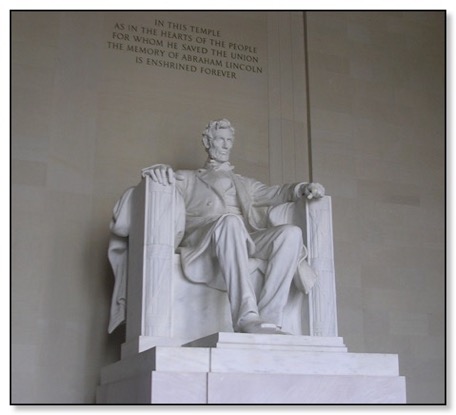
One reason we can celebrate our Independence Day together as a country is due to the character and foresight of Abraham Lincoln. In some of the early Lincoln-Douglas debates, there is a speech from July 10,1858 where Lincoln replied to Douglas. As one column states, its eloquence concludes with what this Independence Day means to many Americans.
“Now, it happens that we meet together once every year, sometime about the 4th of July, for some reason or other. These 4th of July gatherings I suppose have their uses. If you will indulge me, I will state what I suppose to be some of them.
We are now a mighty nation, we are thirty—or about thirty millions of people, and we own and inhabit about one-fifteenth part of the dry land of the whole earth. We run our memory back over the pages of history for about eighty-two years and we discover that we were then a very small people in point of numbers, vastly inferior to what we are now, with a vastly less extent of country,—with vastly less of everything we deem desirable among men,—we look upon the change as exceedingly advantageous to us and to our posterity, and we fix upon something that happened away back, as in some way or other being connected with this rise of prosperity. We find a race of men living in that day whom we claim as our fathers and grandfathers; they were iron men, they fought for the principle that they were contending for; and we understood that by what they then did it has followed that the degree of prosperity that we now enjoy has come to us. We hold this annual celebration to remind ourselves of all the good done in this process of time of how it was done and who did it, and how we are historically connected with it; and we go from these meetings in better humor with ourselves—we feel more attached the one to the other, and more firmly bound to the country we inhabit. In every way we are better men in the age, and race, and country in which we live for these celebrations. But after we have done all this we have not yet reached the whole. There is something else connected with it. We have besides these men—descended by blood from our ancestors—among us perhaps half our people who are not descendants at all of these men, they are men who have come from Europe—German, Irish, French and Scandinavian—men that have come from Europe themselves, or whose ancestors have come hither and settled here, finding themselves our equals in all things. If they look back through this history to trace their connection with those days by blood, they find they have none, they cannot carry themselves back into that glorious epoch and make themselves feel that they are part of us, but when they look through that old Declaration of Independence they find that those old men say that “We hold these truths to be self-evident, that all men are created equal,” and then they feel that that moral sentiment taught in that day evidences their relation to those men, that it is the father of all moral principle in them, and that they have a right to claim it as though they were blood of the blood, and flesh of the flesh of the men who wrote that Declaration [loud and long continued applause], and so they are. That is the electric cord in that Declaration that links the hearts of patriotic and liberty-loving men together, that will link those patriotic hearts as long as the love of freedom exists in the minds of men throughout the world. [Applause.]
Now, sirs, for the purpose of squaring things with this idea of “don’t care if slavery is voted up or voted down” [Douglas's "popular sovereignty" position on the extension of slavery to the territories], for sustaining the Dred Scott decision [A voice---"Hit him again"], for holding that the Declaration of Independence did not mean anything at all, we have Judge Douglas giving his exposition of what the Declaration of Independence means, and we have him saying that the people of America are equal to the people of England. According to his construction, you Germans are not connected with it. Now I ask you in all soberness, if all these things, if indulged in, if ratified, if confirmed and endorsed, if taught to our children, and repeated to them, do not tend to rub out the sentiment of liberty in the country, and to transform this Government into a government of some other form. Those arguments that are made, that the inferior race are to be treated with as much allowance as they are capable of enjoying; that as much is to be done for them as their condition will allow. What are these arguments? They are the arguments that kings have made for enslaving the people in all ages of the world. You will find that all the arguments in favor of king-craft were of this class; they always bestrode the necks of the people, not that they wanted to do it, but because the people were better off for being ridden. That is their argument, and this argument of the Judge is the same old serpent that says you work and I eat, you toil and I will enjoy the fruits of it. Turn in whatever way you will—whether it come from the mouth of a King, an excuse for enslaving the people of his country, or from the mouth of men of one race as a reason for enslaving the men of another race, it is all the same old serpent, and I hold if that course of argumentation that is made for the purpose of convincing the public mind that we should not care about this, should be granted, it does not stop with the negro. I should like to know if taking this old Declaration of Independence, which declares that all men are equal upon principle and making exceptions to it where will it stop. If one man says it does not mean a negro, why not another say it does not mean some other man? If that declaration is not the truth, let us get the Statute book, in which we find it and tear it out! Who is so bold as to do it! [Voices---"me" "no one," &c.] If it is not true let us tear it out! [cries of "no, no,"] let us stick to it then [cheers], let us stand firmly by it then. [Applause.]”

Gettysburg at 150, Third Day
03/07/13 16:03
The last day of the battle………….Pickett’s Charge. One last push that was never enough. Lee gambled and his soldiers paid this day 150 years ago. More than one mile across the fields from Seminary Ridge, the Emmitsburg Road to the stone wall and The Angle. They almost made it, yet the Union held.
Looking toward Seminary Ridge from the stone wall, Pickett’s Charge
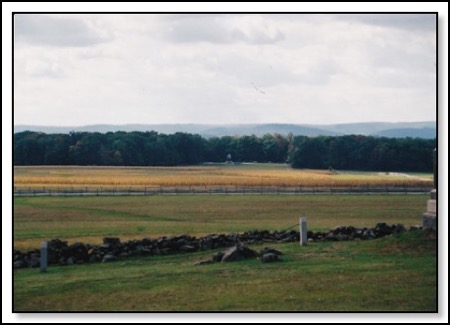
Clash of colours and cultures, the high watermark, at The Angle
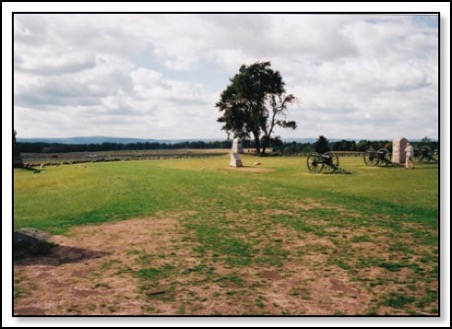
Gettysburg, Day 3
Throughout the war, Robert E. Lee had always sought a way to “get at those people over there.” His aggressiveness had served the Confederate cause well on many battlefields, but on July 3, 1863, it led to disaster.
Despite the passionate arguments of Longstreet, Lee instructed his “Old War Horse” to strike the Union center on Cemetery Ridge, using the divisions of Brig. Gen. James Johnston Pettigrew, Maj. Gen. Isaac Ridgeway Trimble, and the recently arrived division of Maj. Gen. George Pickett. In all, approximately 15,000 men were to advance three-quarters of a mile across open ground, climb fences along the roads, and charge up the gradual but steep slope of Cemetery Ridge to assail a force of about 6,500, but the Federals had reinforcements close by.
At 1:00 in the afternoon, a prolonged artillery barrage by the Confederates, utilizing an unprecedented number of guns spread two miles wide, preceded the assault, intended to silence the Union’s cannons and weaken the infantry. Most of its shells went high, plunging to earth behind the Federals’ line, though some found their mark. One nearly struck Meade, standing outside his headquarters.
For a time, Federal guns replied, until the order came down to conserve ammunition for the attack that was obviously coming. When the Union cannons fell silent, Lee’s artillery chief, Col. Edward Porter Alexander, sent word for Longstreet to bring up his men.
Pettigrew’s division of four brigades formed the left of the attack line, with two of Trimble’s brigades behind them and to their right for support. Pickett’s men stepped out on the right.
The advance was disordered by terrain and by flanking fire on Pettigrew’s left as it neared the Union line. Pickett’s advance drifted left, exposing his right to enemy fire. Through shot, shell, canister and rifle fire, the long Confederate line surged forward. Near the Union center, it broke through temporarily until reinforcements drove it back. As the survivors straggled back to Confederate lines at Seminary Ridge, many of them passed Robert E. Lee, who told them, “It is my fault.”
The day also saw cavalry action, as the horsemen of brigadier generals George Custer and David Gregg stymied Stuart’s attempt to get into the Union rear..
- See more at:
Looking toward Seminary Ridge from the stone wall, Pickett’s Charge

Clash of colours and cultures, the high watermark, at The Angle

Gettysburg, Day 3
Throughout the war, Robert E. Lee had always sought a way to “get at those people over there.” His aggressiveness had served the Confederate cause well on many battlefields, but on July 3, 1863, it led to disaster.
Despite the passionate arguments of Longstreet, Lee instructed his “Old War Horse” to strike the Union center on Cemetery Ridge, using the divisions of Brig. Gen. James Johnston Pettigrew, Maj. Gen. Isaac Ridgeway Trimble, and the recently arrived division of Maj. Gen. George Pickett. In all, approximately 15,000 men were to advance three-quarters of a mile across open ground, climb fences along the roads, and charge up the gradual but steep slope of Cemetery Ridge to assail a force of about 6,500, but the Federals had reinforcements close by.
At 1:00 in the afternoon, a prolonged artillery barrage by the Confederates, utilizing an unprecedented number of guns spread two miles wide, preceded the assault, intended to silence the Union’s cannons and weaken the infantry. Most of its shells went high, plunging to earth behind the Federals’ line, though some found their mark. One nearly struck Meade, standing outside his headquarters.
For a time, Federal guns replied, until the order came down to conserve ammunition for the attack that was obviously coming. When the Union cannons fell silent, Lee’s artillery chief, Col. Edward Porter Alexander, sent word for Longstreet to bring up his men.
Pettigrew’s division of four brigades formed the left of the attack line, with two of Trimble’s brigades behind them and to their right for support. Pickett’s men stepped out on the right.
The advance was disordered by terrain and by flanking fire on Pettigrew’s left as it neared the Union line. Pickett’s advance drifted left, exposing his right to enemy fire. Through shot, shell, canister and rifle fire, the long Confederate line surged forward. Near the Union center, it broke through temporarily until reinforcements drove it back. As the survivors straggled back to Confederate lines at Seminary Ridge, many of them passed Robert E. Lee, who told them, “It is my fault.”
The day also saw cavalry action, as the horsemen of brigadier generals George Custer and David Gregg stymied Stuart’s attempt to get into the Union rear..
- See more at:
Gettysburg at 150, Second Day
02/07/13 09:43
The second day was the bloodiest day of the three at Gettysburg. The Union soldiers had retreated and dug in on Cemetery Ridge, Little Round Top, and Culp’s Hill. Battles such as at the Peach Orchard, the Wheat field, and Devil’s Den occurred. Following are photos from some of these areas.
Devil’s Den

Soldiers for re-enactments at Gettysburg near the Peach Orchard
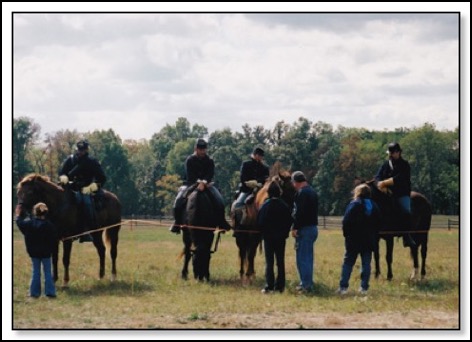
Gettysburg, Day 2
James Longstreet’s corps had arrived, and his 20,000 men were sent to outflank the Union left, which was anchored to the south by two eminences known as Little Round Top and Big Round Top. But the Federals had failed to place troops upon those hills, as Lee learned from an early morning reconnaissance report. Ewell was to make a demonstration against Culp’s and Cemetery hills on the Union right and to use his own discretion about launching a full-scale attack.
Longstreet’s men, moving toward their objective, had to reverse, countermarch and take a different route after Brigadier General Lafayette McLaws discovered the planned route would put them in full view of the Federals, negating any advantage of surprise. This cost valuable time but, as events turned out, a Union general was about to present them an unexpected opportunity.
Read More in America’s Civil War Magazine
Subscribe online and save nearly 40%!!!
All but one of Meade’s seven corps were now on the field, deployed in a fish-hook shape with its center along Cemetery Ridge; the defensive positions on Culp’s and Cemetery hills formed the hook at one end. The left was held by Major General Daniel Sickles, who owed his military rank to his political importance in the essential state of New York.
Dissatisfied with his position at the lower end of Cemetery Ridge, he took it upon himself to advance his III Corps nearly a half-mile west toward the Emmitsburg Pike and open high ground in a wheat field near a peach orchard. The move dangerously stretched his 10,000-man corps. Longstreet’s men attacked Sickle’s new position, and the fighting at rocky Devil’s Den, the wheat field and the peach orchard was among the fiercest and bloodiest of the three days.
Meade, faced with Sickles’ blunder, sent V Corps and part of the XI to reinforce him. New York’s Irish Brigade received Last Rites from a Catholic priest before charging into the fray; 198 of them would not return from the desperate fighting in the hot, sultry afternoon.
Above the blood-soaked fields, a similar drama was playing out on Little Round Top. Around 4:30 p.m., men of Alabama, Texas and Arkansas, from John Bell Hood’s Division in Longstreet’s Corps, began ascending the steep hill from the west. Had they arrived two hours earlier, they would have captured the heights unopposed, but by the time they arrived Meade’s chief of engineers, Brig. Gen. Gouveneur K. Warren, had discovered the potentially disastrous situation and sent messages to Sickles, who could not send even a single regiment by that time.
One message found its way to Colonel Strong Vincent, commanding 3rd Brigade, 1st Division, of the Federals’ V Corps. He double-timed his men and deployed them among the rocks and trees of Little Round Top’s western and southern slopes. The fate of the Union Army, at that moment, rested on the shoulders of 1,350 men of the 83rd Pennsylvania, 44th New York, 16th Michigan and 20th Maine regiments. Vincent’s orders were to “hold this ground at all costs!”
Nearly 650 Rebels of the 15th Alabama stormed into the saddle between the Round Tops around 6:00 p.m., and into the muzzles of Colonel Joshua Chamberlain’s 20th Maine. After an hour of intense fighting, Chamberlain’s 300-plus men had nearly exhausted their 15,000 rounds of ammunition. He ordered a countercharge. The surprised Alabamians fell back and attempted to make a stand, but Company B of the 20th Maine, which had been detached to cover the regiment’s flank, and fourteen of Hiram Berdan’s Sharpshooters rose from behind a stone wall and charged the Confederates’ flank. Convinced they were outnumbered, the men of the 15th and 47th Alabama retreated onto Big Round Top.
On the western slope, Colonel Vincent’s other regiments also stood firm until part of the 16th Michigan was pushed back. Gouvenor Warren, receiving a plea for reinforcements, ordered the 140th New York Zouaves to charge, and they broke the Rebels’ line long enough for more reinforcements to arrive.
By the time the sun went down on the second day at Gettysburg, the Union left still held, but III Corps would no longer be a significant factor in the battle, and V Corps had been badly mauled. Meanwhile, a desperate contest was taking place on the slope of Cemetery Hill.
Ewell’s troops had advanced from around the town of Gettysburg to assault Culp’s and Cemetery hills. For an hour they struggled across rough ground while Union batteries threw shot and shell among them, but when they got far enough up the slopes, the Federals could not depress their barrels enough to fire into them, and the Rebels routed infantry of the XI Corps. Union regiments pulled from one area of Cemetery Hill to plug a gap created by the retreat created their own gap, and Confederate infantry poured through.
Down on Cemetery Ridge, Winfield Hancock sent the 14th Indiana and 7th West Virginia regiments to reinforce Cemetery Hill. Arriving after dark, they formed up and charged into the Rebels who were fighting with artillerymen around the Union guns. The Confederates fell back. In one of the ironic events of the war, the 7th West Virginia, which had been the 7th Virginia (Union) until June 20 when West Virginia was admitted as a state, fought hand to hand with the 7th Virginia of the Confederacy, capturing a nephew of their own regimental commander.
The long day of bloodshed finally ended. Meade called together his commanders for a council of war. He’d already sent a message to the War Department stating that he intended to stay and fight; he may have called the council in order to make sure no one would do the next day what Sickles had done. Meade’s army had been attacked on the left and the right; that fact, combined with other intelligence he’d received, led him to believe his center would be the target the next day.
Read more about General Lee’s plan for Gettysburg Day 2
- See more at:
Devil’s Den

Soldiers for re-enactments at Gettysburg near the Peach Orchard

Gettysburg, Day 2
James Longstreet’s corps had arrived, and his 20,000 men were sent to outflank the Union left, which was anchored to the south by two eminences known as Little Round Top and Big Round Top. But the Federals had failed to place troops upon those hills, as Lee learned from an early morning reconnaissance report. Ewell was to make a demonstration against Culp’s and Cemetery hills on the Union right and to use his own discretion about launching a full-scale attack.
Longstreet’s men, moving toward their objective, had to reverse, countermarch and take a different route after Brigadier General Lafayette McLaws discovered the planned route would put them in full view of the Federals, negating any advantage of surprise. This cost valuable time but, as events turned out, a Union general was about to present them an unexpected opportunity.
Read More in America’s Civil War Magazine
Subscribe online and save nearly 40%!!!
All but one of Meade’s seven corps were now on the field, deployed in a fish-hook shape with its center along Cemetery Ridge; the defensive positions on Culp’s and Cemetery hills formed the hook at one end. The left was held by Major General Daniel Sickles, who owed his military rank to his political importance in the essential state of New York.
Dissatisfied with his position at the lower end of Cemetery Ridge, he took it upon himself to advance his III Corps nearly a half-mile west toward the Emmitsburg Pike and open high ground in a wheat field near a peach orchard. The move dangerously stretched his 10,000-man corps. Longstreet’s men attacked Sickle’s new position, and the fighting at rocky Devil’s Den, the wheat field and the peach orchard was among the fiercest and bloodiest of the three days.
Meade, faced with Sickles’ blunder, sent V Corps and part of the XI to reinforce him. New York’s Irish Brigade received Last Rites from a Catholic priest before charging into the fray; 198 of them would not return from the desperate fighting in the hot, sultry afternoon.
Above the blood-soaked fields, a similar drama was playing out on Little Round Top. Around 4:30 p.m., men of Alabama, Texas and Arkansas, from John Bell Hood’s Division in Longstreet’s Corps, began ascending the steep hill from the west. Had they arrived two hours earlier, they would have captured the heights unopposed, but by the time they arrived Meade’s chief of engineers, Brig. Gen. Gouveneur K. Warren, had discovered the potentially disastrous situation and sent messages to Sickles, who could not send even a single regiment by that time.
One message found its way to Colonel Strong Vincent, commanding 3rd Brigade, 1st Division, of the Federals’ V Corps. He double-timed his men and deployed them among the rocks and trees of Little Round Top’s western and southern slopes. The fate of the Union Army, at that moment, rested on the shoulders of 1,350 men of the 83rd Pennsylvania, 44th New York, 16th Michigan and 20th Maine regiments. Vincent’s orders were to “hold this ground at all costs!”
Nearly 650 Rebels of the 15th Alabama stormed into the saddle between the Round Tops around 6:00 p.m., and into the muzzles of Colonel Joshua Chamberlain’s 20th Maine. After an hour of intense fighting, Chamberlain’s 300-plus men had nearly exhausted their 15,000 rounds of ammunition. He ordered a countercharge. The surprised Alabamians fell back and attempted to make a stand, but Company B of the 20th Maine, which had been detached to cover the regiment’s flank, and fourteen of Hiram Berdan’s Sharpshooters rose from behind a stone wall and charged the Confederates’ flank. Convinced they were outnumbered, the men of the 15th and 47th Alabama retreated onto Big Round Top.
On the western slope, Colonel Vincent’s other regiments also stood firm until part of the 16th Michigan was pushed back. Gouvenor Warren, receiving a plea for reinforcements, ordered the 140th New York Zouaves to charge, and they broke the Rebels’ line long enough for more reinforcements to arrive.
By the time the sun went down on the second day at Gettysburg, the Union left still held, but III Corps would no longer be a significant factor in the battle, and V Corps had been badly mauled. Meanwhile, a desperate contest was taking place on the slope of Cemetery Hill.
Ewell’s troops had advanced from around the town of Gettysburg to assault Culp’s and Cemetery hills. For an hour they struggled across rough ground while Union batteries threw shot and shell among them, but when they got far enough up the slopes, the Federals could not depress their barrels enough to fire into them, and the Rebels routed infantry of the XI Corps. Union regiments pulled from one area of Cemetery Hill to plug a gap created by the retreat created their own gap, and Confederate infantry poured through.
Down on Cemetery Ridge, Winfield Hancock sent the 14th Indiana and 7th West Virginia regiments to reinforce Cemetery Hill. Arriving after dark, they formed up and charged into the Rebels who were fighting with artillerymen around the Union guns. The Confederates fell back. In one of the ironic events of the war, the 7th West Virginia, which had been the 7th Virginia (Union) until June 20 when West Virginia was admitted as a state, fought hand to hand with the 7th Virginia of the Confederacy, capturing a nephew of their own regimental commander.
The long day of bloodshed finally ended. Meade called together his commanders for a council of war. He’d already sent a message to the War Department stating that he intended to stay and fight; he may have called the council in order to make sure no one would do the next day what Sickles had done. Meade’s army had been attacked on the left and the right; that fact, combined with other intelligence he’d received, led him to believe his center would be the target the next day.
Read more about General Lee’s plan for Gettysburg Day 2
- See more at:
Gettysburg at 150, First Day
01/07/13 21:23
In 2001, shortly after 9-11 we traveled back to Philadelphia for a meeting. Afterwards, we spent time in parts of Pennsylvania, Washington DC, and Virginia. The major part of Pennsylvania was a visit to the Gettysburg Battlefield. What a special memory! We did a driving tour with audio (we still have the audio to listen to) around the various sites. It was a great overview though one never does get in everything. Today is the 150th anniversary of the first day of battle at Gettysburg.
Here is a modern day photo of the driving lane and monuments along the ridge where the first sightings and skirmishes occurred between the Boys in Blue and the Johnny Rebs. Did General Ewell lose the battle on this day by his actions? This area of McPherson’s Ridge was near to where we stayed in a B&B.

The town of Gettysburg, PA as you come up to it. It has much the same flavor as it must have in the days before the battle.


Gettysburg, Day 1
On the morning of July 1, Major General Henry Heth, of A.P. Hill’s Third Corps, sent his 7,500-man division down the Chambersburg Pike toward Gettysburg. Encountering resistance, they initially assumed it was more of the hastily assembled Pennsylvania Emergency Militia that they’d been skirmishing with during the campaign.
In reality, Colonel John Buford had deployed part of two brigades of Union cavalry as skirmishers in the brush along Willoughby’s Run three miles west of town. Just two weeks previously, they’d been issued breech-loading carbines, and they used the guns’ fast-loading capability to create the impression of a much larger force, slowing the advance of Hill’s brigades for a time before falling back.
The Confederates followed them across the stream, only to meet a line of Union infantry on McPherson’s Ridge. The Army of the Potomac was arriving piecemeal, and among the first to arrive was a brigade of Western regiments that had earned the nickname “Iron Brigade of the West.” Confederates recognized these “fellows in the black hats” and realized they were in for a rougher day than expected.
Union major general John Reynolds, commander of the left wing of the Army of the Potomac (I, III and XI corps), arrived and took charge of the defense. His men fought tenaciously, and Reynolds was shot dead during the fighting.
From his headquarters at Taneytown, Meade dispatched Major General Winfield Scott Hancock to take command at Gettysburg—although Major General O. O. Howard was already on the field—and assess whether or not the battle should be fought there. Hancock, seeing the strong defensive position offered by the hills near Gettysburg, chose to stand, and Meade ordered the other corps to the little crossroads town.
By afternoon, Confederate reinforcements had also arrived, and the general engagement Lee hadn’t wanted at this stage of the campaign was a fait accompli.
The Union’s XI Corps was driven back through the town of Gettysburg, losing 4,000 men, and by evening was entrenching on Culp’s and Cemetery hills south of town.
Lee expressed a desire for General Ewell to assault the hills without waiting for further reinforcement, but he failed to make it an express order. Ewell did not press his tired men forward, giving Meade time to reinforce the troops on the hills.
- See more at:
Here is a modern day photo of the driving lane and monuments along the ridge where the first sightings and skirmishes occurred between the Boys in Blue and the Johnny Rebs. Did General Ewell lose the battle on this day by his actions? This area of McPherson’s Ridge was near to where we stayed in a B&B.

The town of Gettysburg, PA as you come up to it. It has much the same flavor as it must have in the days before the battle.


Gettysburg, Day 1
On the morning of July 1, Major General Henry Heth, of A.P. Hill’s Third Corps, sent his 7,500-man division down the Chambersburg Pike toward Gettysburg. Encountering resistance, they initially assumed it was more of the hastily assembled Pennsylvania Emergency Militia that they’d been skirmishing with during the campaign.
In reality, Colonel John Buford had deployed part of two brigades of Union cavalry as skirmishers in the brush along Willoughby’s Run three miles west of town. Just two weeks previously, they’d been issued breech-loading carbines, and they used the guns’ fast-loading capability to create the impression of a much larger force, slowing the advance of Hill’s brigades for a time before falling back.
The Confederates followed them across the stream, only to meet a line of Union infantry on McPherson’s Ridge. The Army of the Potomac was arriving piecemeal, and among the first to arrive was a brigade of Western regiments that had earned the nickname “Iron Brigade of the West.” Confederates recognized these “fellows in the black hats” and realized they were in for a rougher day than expected.
Union major general John Reynolds, commander of the left wing of the Army of the Potomac (I, III and XI corps), arrived and took charge of the defense. His men fought tenaciously, and Reynolds was shot dead during the fighting.
From his headquarters at Taneytown, Meade dispatched Major General Winfield Scott Hancock to take command at Gettysburg—although Major General O. O. Howard was already on the field—and assess whether or not the battle should be fought there. Hancock, seeing the strong defensive position offered by the hills near Gettysburg, chose to stand, and Meade ordered the other corps to the little crossroads town.
By afternoon, Confederate reinforcements had also arrived, and the general engagement Lee hadn’t wanted at this stage of the campaign was a fait accompli.
The Union’s XI Corps was driven back through the town of Gettysburg, losing 4,000 men, and by evening was entrenching on Culp’s and Cemetery hills south of town.
Lee expressed a desire for General Ewell to assault the hills without waiting for further reinforcement, but he failed to make it an express order. Ewell did not press his tired men forward, giving Meade time to reinforce the troops on the hills.
- See more at:
England and the Raj
24/06/13 17:57
The historical underpinnings of India as a part of the English empire has been controversial. Belief was that India, its resources, and its people were exploited by the British. There is an article and recent book that states British rule most likely gave India its basis as an economically growing country. Read the whole article here.
The period of colonial rule, spanning some 200 years, is routinely depicted as the systematic plundering of a nation. The popular view is that the Empire stripped India of its natural resources and gave little in return, leaving the place all but destitute when independence was finally granted in 1947.
Now, however, a new book written by an Anglo-Indian challenges this notion. It asserts that in fact Britain laid the foundations for modern-day India and the prosperity that it enjoys today.
The period of colonial rule, spanning some 200 years, is routinely depicted as the systematic plundering of a nation. The popular view is that the Empire stripped India of its natural resources and gave little in return, leaving the place all but destitute when independence was finally granted in 1947.
Now, however, a new book written by an Anglo-Indian challenges this notion. It asserts that in fact Britain laid the foundations for modern-day India and the prosperity that it enjoys today.
Soviet Holocaust Cinema
23/06/13 16:06
Records, photos, and especially film has been found in the old Soviet archives of how the Soviet Union depicted the Shoah or Holocaust from their vantage point. In the late 1930s, before Germany invaded the Soviet Union, there were films being made that depicted Jews being taken away by Nazis. Many of these films were hidden away once the Molotov-Ribbentrop pact was signed. An interesting story is found here with many interesting photos and film noted.
Lincoln Unbound
12/06/13 09:16
It is probably easy to detect that one person in history I admire greatly was Abraham Lincoln. Much has been written about him, his life, his character, his beliefs………. There is a new book out today by Rich Lowry that focuses on what beliefs formed his character and actions. Here is a description of the book by the author.
Wolfe at Louisbourg
31/05/13 20:22
I found a new interesting website today called historion.net. A library for time travelers, or those who love to travel through history learning from the past. One chapter is on Canadian history and the siege of Louisbourg by Wolfe. We visited Louisbourg Fortress and one could spend hours there on tour and learning the history of the Fortress and people who lived there. Here is the article and a photo of its colorful main quarters.
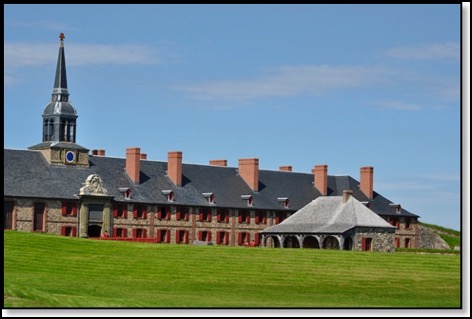

Westphalia
22/05/13 19:03
As a prelude to issues occurring in the European Union in modern times, there was war and turmoil in similar parts of Europe in the early 1600’s. The Treaty of Westphalia helped to bring a close to the Thirty Years’ War. A description of the war and treaty are found here.
In an early version of the EU is described in this manner:
Principles of Westphalia
The Treaty of Westphalia of 1648, bringing an end to the Thirty Years' War, which had drowned Europe in blood in battles over religion, defined the principles of sovereignty and equality in numerous sub-contracts, and in this way became the constitution of the new system of states in Europe.
In an early version of the EU is described in this manner:
Principles of Westphalia
The Treaty of Westphalia of 1648, bringing an end to the Thirty Years' War, which had drowned Europe in blood in battles over religion, defined the principles of sovereignty and equality in numerous sub-contracts, and in this way became the constitution of the new system of states in Europe.
Grant Is No Butcher
20/05/13 21:26
A Civil War scholar named Gordon C. Rhea has determined through research that Grant’s Overland Campaign of 1864 in Virginia has a different set of facts. He believes his research shows that Grant only lost closer to 20% of the men at Cold Harbor than previous understanding claimed. Rhea has written a collection of books on this part of the Civil War and is considered a voice to be heard. To learn more about his work, please go here.
For additional historical information about the battle near Spotsylvania Courthouse, you can read about it from the Civil War Trust site here.
For additional historical information about the battle near Spotsylvania Courthouse, you can read about it from the Civil War Trust site here.
The Wilderness
18/05/13 09:35
Another interesting battle that occurred in Northern Virginia in early May, 1864 was the battle of The Wilderness. It is a tangled web of trees and undergrowth in Spotsylvania County of Virginia. Close to the area where Jackson lost his life at Chancellorsville. More can be read here.
The Battle of the Wilderness, fought May 5–6, 1864, was the opening engagement of the Overland Campaign during the American Civil War (1861–1865). The newly appointed general-in-chief of the Union armies, Ulysses S. Grant, personally led the Army of the Potomac south across the Rapidan River in what he hoped would be a quick maneuver around the right flank of Confederate general Robert E. Lee and his Army of Northern Virginia.
The battle ended up as a number of tactical setbacks for Grant and his army. Yet, he did not accept defeat. Grant’s ultimate success was that he kept moving forward, determined to reach his goals. He reminds a person that it is best to less focus on what the other guy is doing than what you are going to do to achieve success.
Although disappointed by the tactical setbacks, Grant refused to accept defeat, and in doing so transformed the battle into a strategic victory for the Union. When a general worried about Lee's next move, Grant tersely replied, "I am heartily tired of hearing what Lee is going to do. Some of you always seem to think he is suddenly going to turn a double somersault, and land on our rear and on both our flanks at the same time. Go back to your command, and try to think what we are going to do ourselves, instead of what Lee is going to do."
The Battle of the Wilderness, fought May 5–6, 1864, was the opening engagement of the Overland Campaign during the American Civil War (1861–1865). The newly appointed general-in-chief of the Union armies, Ulysses S. Grant, personally led the Army of the Potomac south across the Rapidan River in what he hoped would be a quick maneuver around the right flank of Confederate general Robert E. Lee and his Army of Northern Virginia.
The battle ended up as a number of tactical setbacks for Grant and his army. Yet, he did not accept defeat. Grant’s ultimate success was that he kept moving forward, determined to reach his goals. He reminds a person that it is best to less focus on what the other guy is doing than what you are going to do to achieve success.
Although disappointed by the tactical setbacks, Grant refused to accept defeat, and in doing so transformed the battle into a strategic victory for the Union. When a general worried about Lee's next move, Grant tersely replied, "I am heartily tired of hearing what Lee is going to do. Some of you always seem to think he is suddenly going to turn a double somersault, and land on our rear and on both our flanks at the same time. Go back to your command, and try to think what we are going to do ourselves, instead of what Lee is going to do."
Antietam's Bloody Lane
17/05/13 08:06
Back in 2001, Bob and I made a tour of the countryside and Civil War battlefields of Pennsylvania, Maryland, West Virginia, and Virginia. In those days, I had my Olympus OM-2 film 35mm camera. It was not the digital age. I have slowly been scanning my photos of the trip onto my computer in digital format. One of my favorites from the trip was a view of the Sunken Road or Bloody Lane at the Antietam (Sharpsburg) Battlefield in Maryland. We have visited the area twice and it always impresses and haunts us. Antietam was the one battle and day even including September 11, 2001 where the largest loss of American lives occurred. More than 3500 souls perished on that day. The Bloody Lane was an area piled high with bodies at that time, 5600 dead and wounded. Hard to envision in such a peaceful, beautiful setting that it is now. A description of this part of the battle is found here in video.
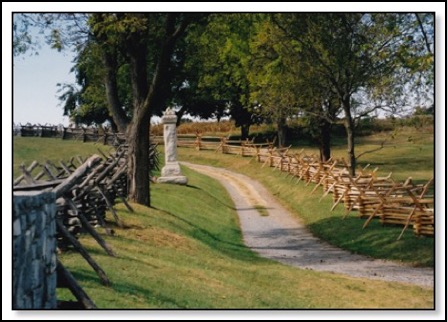
Antietam (Sharpsburg MD)

Antietam (Sharpsburg MD)
The Hanging Gardens
08/05/13 08:54
A British academic has recently produced evidence supporting her theory that The Hanging Gardens of Assyria were not in Babylon but in Nineveh. The Hanging Gardens are considered one of the seven Wonders of the Ancient World. Where the gardens were located specifically has been a mystery and now some answers may be forthcoming. Time and further study should prove this theory. For now, the information at hand is found here.
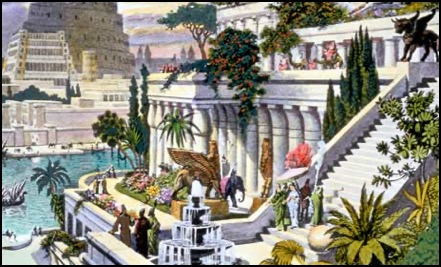

Iberia and Muslims
06/05/13 16:42
Spain still has a lot of Muslim influence found in its daily life. Muslims invaded the country of Spain and were advancing into other parts of Europe when they were halted by Charles Martel in the famous battle of Poitiers in 732 A.D. A description of the changes found in the Spanish lifestyle are noted in this article here.
Besides the food crops, the Muslim brought to the Iberian Peninsula the cotton plant, which in Spanish is called algodon from the Arabic alqutn. They also developed the silk industry, to make Al-Andalus one of the major silk manufacturing countries of the medieval world. The fine fabrics of which Europe was to be proud in later centuries had their origin in this land of the Moors.
A further description of the history of Spain’s conquest by Muslims can be found in this article.
After a short foray in July of 710 AD, Muslim forces from North Africa invaded the Christian Iberian Peninsula (modern day Spain and Portugal) in the spring of 711, and within two years, with the exception of the extreme northwestern portion of the peninsula, had successfully overpowered and conquered the Visigothic Christian realms of Iberia.[1] Not only did it take the Frankish forces under Charles Martel to stop the Muslim horde at the battle of Poitiers in 732 from further intrusions into Western Europe, it would take nearly eight centuries for the Iberian Christians to re-take the peninsula from the Muslims. Why were the Muslims able to so quickly invade, conquer, and subdue nearly the entire Iberian Peninsula, whose Christian forces greatly outnumbered the Muslim forces, yet Charles Martel was able to route the Muslims from his land in just one battle?
Besides the food crops, the Muslim brought to the Iberian Peninsula the cotton plant, which in Spanish is called algodon from the Arabic alqutn. They also developed the silk industry, to make Al-Andalus one of the major silk manufacturing countries of the medieval world. The fine fabrics of which Europe was to be proud in later centuries had their origin in this land of the Moors.
A further description of the history of Spain’s conquest by Muslims can be found in this article.
After a short foray in July of 710 AD, Muslim forces from North Africa invaded the Christian Iberian Peninsula (modern day Spain and Portugal) in the spring of 711, and within two years, with the exception of the extreme northwestern portion of the peninsula, had successfully overpowered and conquered the Visigothic Christian realms of Iberia.[1] Not only did it take the Frankish forces under Charles Martel to stop the Muslim horde at the battle of Poitiers in 732 from further intrusions into Western Europe, it would take nearly eight centuries for the Iberian Christians to re-take the peninsula from the Muslims. Why were the Muslims able to so quickly invade, conquer, and subdue nearly the entire Iberian Peninsula, whose Christian forces greatly outnumbered the Muslim forces, yet Charles Martel was able to route the Muslims from his land in just one battle?
Shenandoah
05/05/13 11:33
On the trip Bob and I made around Virginia included visiting part of the Shenandoah Valley and driving the Shenandoah Parkway. We stayed overnight in Front Royal and drove down the Valley to Harrisonburg and Stanton. This area was a large focus in 1862 of the Shenandoah campaign of the Union and “Stonewall” Jackson’s campaign to deny the Union the use of the Valley and also divert attention from Richmond. He was very successful in doing so. A good yet succinct description of the battles and campaign are noted in this article.
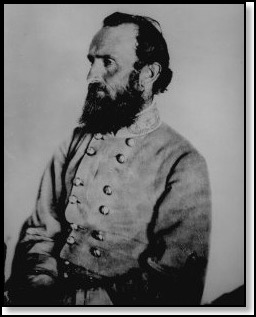
Gen. T. J. “Stonewall” Jackson

Gen. T. J. “Stonewall” Jackson
Top 12 Civil War Books
03/05/13 08:23
Another spot to get a good source of heavy reading, check out this site where the author lists his Top 12 Books on the Civil War. We should have some of these books. Bob just finished and enjoyed The Warrior Generals. He said the author liked General Thomas on the Union side as an exemplary general, above Grant and Lee. Interesting. All of the books in the list have been written since World War II so the list does not take into account other great works before that time.
Some of the list we have:
“The American Heritage Picture History of the Civil War”
“Battle Cry of Freedom: The Civil War Era”
“A Stillness at Appomattox”
“Confederates in the Attic: Dispatches From the Unfinished Civil War”
Some of the list we have:
“The American Heritage Picture History of the Civil War”
“Battle Cry of Freedom: The Civil War Era”
“A Stillness at Appomattox”
“Confederates in the Attic: Dispatches From the Unfinished Civil War”
Chancellorsville
02/05/13 09:50
As a history buff, there are a number of interesting articles regarding the battle of Chancellorsville in Northern Virginia in May of 1863. Bob and I drove the battle site areas a number of years ago. It covers a large area and many miles of roads to the different viewing spots. The area is densely wooded as described from the history of the times. A number of articles about what happened then are found here and here. Maps of the area are located here.
Hitler's Bunker
30/04/13 16:46
Today is the anniversary of the death of Hitler and the final death knell of the German phase of World War II. Hitler and Eva Braun, his mistress, committed suicide in his underground bunker in Berlin. When I was in East Berlin in 1969 at the age of 17, they drove us past where they said the bunker had been. There are a number of articles about Hitler’s last days, his death, and where he is buried found here, here, and here.
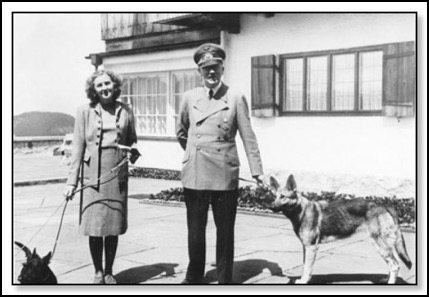

Operation Eagle Claw
29/04/13 15:29
A number of books have been written and movies filmed about the 1979 Iranian Revolution and hostage taking. One of the saddest and controversial episodes was the special forces action to rescue the hostages that failed in the Iranian desert. A number of lives were lost. A long article and description of this episode…….Operation Eagle Claw and Desert One is covered here.
On November 4, 1979, a group of Iranian students stormed the U.S. embassy in Fehran and took hostage all the Americans in the compound. Fheir proclaimed intent was twofold. They wished to force the United States to return the exiled shah of Iran, who was in America for medical treatment. Fhey were also seeking evidence of a CIA plot to overthrow the new Islamic republic that had formed under the cleric Ayatollah Ruholla Khomeini. While publicly pursuing diplomatic efforts to free the captive Americans, President Jimmy Carter covertly authorized a top-secret rescue mission, Operation Eagle Claw. It would be conducted by America’s new and equally secret counterterrorist unit, the 1st Special Forces Operational Detachment Delta—Delta Force, commanded by its founder, Colonel Charles Beckwith. Fhe hostage crisis dominated world news, the rescue attempt failed disastrously, the crisis ultimately lasted 444 days, and Eagle Claw’s failure in large part contributed to President Carter’s defeat in the 1980 presidential election. Fhe mission became a textbook example that has been studied by special operations personnel ever since. More importantly, Operation Eagle Claw became the touchstone for the creation of Special Operations Command (SOCOM).
On November 4, 1979, a group of Iranian students stormed the U.S. embassy in Fehran and took hostage all the Americans in the compound. Fheir proclaimed intent was twofold. They wished to force the United States to return the exiled shah of Iran, who was in America for medical treatment. Fhey were also seeking evidence of a CIA plot to overthrow the new Islamic republic that had formed under the cleric Ayatollah Ruholla Khomeini. While publicly pursuing diplomatic efforts to free the captive Americans, President Jimmy Carter covertly authorized a top-secret rescue mission, Operation Eagle Claw. It would be conducted by America’s new and equally secret counterterrorist unit, the 1st Special Forces Operational Detachment Delta—Delta Force, commanded by its founder, Colonel Charles Beckwith. Fhe hostage crisis dominated world news, the rescue attempt failed disastrously, the crisis ultimately lasted 444 days, and Eagle Claw’s failure in large part contributed to President Carter’s defeat in the 1980 presidential election. Fhe mission became a textbook example that has been studied by special operations personnel ever since. More importantly, Operation Eagle Claw became the touchstone for the creation of Special Operations Command (SOCOM).
A Spy from the Cold War
27/04/13 12:58
- This coming Wednesday will be the finale of the TV show, The Americans (spelled with the C being a Soviet sickle).
- The premise is that the Soviet Union planted spies amongst the regular population who would blend in as families yet seek
- American secrets to send to the Communists. All cloak and dagger stuff.
- There is a recent book review about a real Soviet spy who hated the KGB and gave very valuable information to the French
- who eventually gave it to Reagan, our President at the time. The TV show is set in the 1980’s time frame also. The TB show
- gave the appearance that Soviet spies where winning the game in most instances. They hurt us yet lost in the end.
- To read about Vladimir Vetrov, Farewell- code name, please go here.
More Katyn Forest
26/04/13 13:52
- Here is further detail of what happened at Katyn Forest from the Central Intelligence Agency’s website. The full article is here.
Katyn Forest
24/04/13 09:59
- Looking back in history, one of the biggest mysteries that has been solved yet not made widely known is what happened to the Polish Officers
- who were killed in the Katyn Forest during World War II. For a long period, the Soviet Union had implied the Germans had killed these men. After
- the fall of the Soviet Union, research found that Stalin and the Soviet Union was responsible for this atrocity. A discussion of the coverup is
- covered here.
As the evidence assembled by the Swiss Red Cross showed that this horrible deed was the work of Stalin and his henchmen, the Soviet government dismissed it as a piece of Nazi propaganda . . . . The American press, following the lead of the Office of War Information, played down the story or treated it as another Nazi atrocity.
Hook reported that at the time, Oscar Lange, a pro-Soviet Polish emigre who "tried to pin the responsibility for the massacre on the Germans," challenged his view of the crime. Hook felt strongly enough about the issue to agree to participate in a public debate with Lange, to be held at Columbia University. Unfortunately, the debate did not come off and Lange returned to Poland to work for the Communist regime that Stalin was installing there. Needless to say, to the great disappointment of Hook and others, there was no slowing of the American rush to beneficent judgment of Stalin's regime.
Audie Murphy
17/04/13 21:19
Three days ago, on Sunday, DISH network had the movie, To Hell and Back. The movie is named after Audie Murphy’s autobiographical account of his feats of bravery fighting against the Germans in the Italian Front in World War II. Audie Murphy is one of the most decorated soldiers in American history and went on to be a well-known actor too. His story is one for the legends, especially since he was in his late teens when he demonstrated such bravery. It is so impressive that he is the only modern day warrior listed in this article on the top 10 warriors in history.
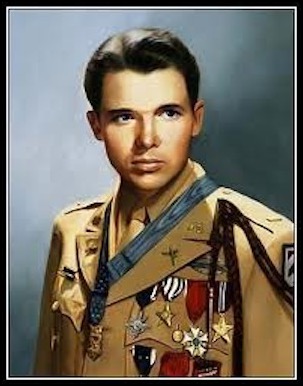

20 Photos
14/04/13 16:19
On the recent Holocaust Memorial Day. there are links to a site that displayed 20 photos that change the Holocaust narrative. In the midst of the horror and loss of too many lives, people still could smile and have some small bursts of normal life. The people still go on and try for surviving along with their fellow people. They feel the photos show they were survivors, not just victims.
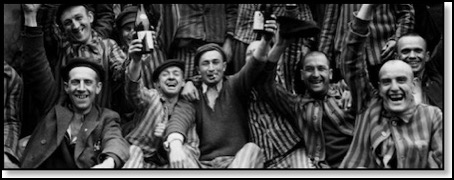

Gettysburg This Summer
14/04/13 16:03
On July 1 this summer, it will be the 150th anniversary of the Battle of Gettysburg. Bob and I were fortunate to visit Gettysburg and be able over a few days to travel the battle sites. It was a great experience. I remember being on Little Round Top looking across the way to where so many Confederate soldiers came to attack Union soldiers dug in on this hill. The Cornfield……The Peach Orchard…….The Bloody Angle…..where Pickett marched his troops. So much history, so much sadness. A short article explains how such a visit becomes a part of America’s soul to those who visit and those who wish to visit.
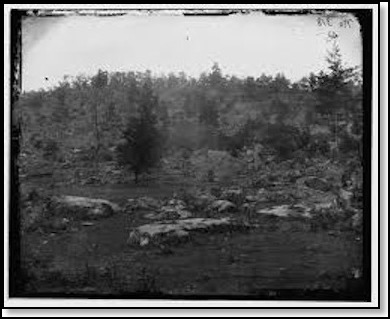

Legacy of the USS Thresher
08/04/13 09:28
Before the USS San Francisco survived hitting an underwater mountain when cruising along as a submarine, the submarine loss that set the bar for SubSafe was the USS Thresher.
“Thresher was the fastest, deepest diving, most capable submarine in the word,” Rear Adm. David Duryea, Naval Sea Systems Command’s, deputy commander for undersea warfare told USNI News in a recent interview. “This was the pride of the U.S. Navy.”
On 9 April 1963, Thresher put to sea to conduct a series of sea trials following an overhaul accompanied by USS Skylark (ASR-20), a Penguin-class submarine rescue ship, according to the 1975 book The Thresher Disaster.
The next morning, Thresher descended to 1,000 feet in a deep-diving test.
Forty-six minutes after reaching test depth, things began to go very wrong.
Thresher suffered a mechanical failure and Harvey’s attempts to bring the boat to the surface failed.
Four minutes after Skylark learned there were problems, Thresher sent her last garbled transmission, “exceeding test depth.” One minute later Skylark detected a noise that shared the characteristics of an implosion.
The next day, Navy officials announced the ship was lost.
Read about it here.
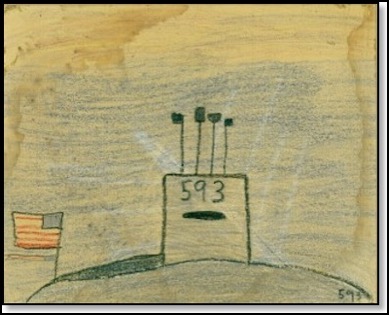
Child’s picture of the USS Thresher
“Thresher was the fastest, deepest diving, most capable submarine in the word,” Rear Adm. David Duryea, Naval Sea Systems Command’s, deputy commander for undersea warfare told USNI News in a recent interview. “This was the pride of the U.S. Navy.”
On 9 April 1963, Thresher put to sea to conduct a series of sea trials following an overhaul accompanied by USS Skylark (ASR-20), a Penguin-class submarine rescue ship, according to the 1975 book The Thresher Disaster.
The next morning, Thresher descended to 1,000 feet in a deep-diving test.
Forty-six minutes after reaching test depth, things began to go very wrong.
Thresher suffered a mechanical failure and Harvey’s attempts to bring the boat to the surface failed.
Four minutes after Skylark learned there were problems, Thresher sent her last garbled transmission, “exceeding test depth.” One minute later Skylark detected a noise that shared the characteristics of an implosion.
The next day, Navy officials announced the ship was lost.
Read about it here.

Child’s picture of the USS Thresher
SubSafe Program
07/04/13 09:13
Eight years ago, USS San Francisco (SSN-711) ran full speed into a mountain more than 500 feet below the ocean’s surface.
One sailor died.
Fifty years earlier, the crew might not have been as lucky, said Rear Adm. David Duryea, Naval Sea Systems Command’s deputy commander for undersea warfare told USNI News in an interview.
Duryea oversees the Navy’s SUBSAFE program, the series of rigorous checks in design, manufacture, and maintenance of the service’s nuclear submarine fleet— and the reason the San Francisco lost just one sailor. He died of head injuries.
“I’m not sure a non-SUBSAFE sub could have survived that,” Duryea said. “It’s my opinion the SUBSAFE program helped insure that ship was able to rejoin the fleet.”
San Francisco rejoined the Fleet in 2009.
Read the story here.

One sailor died.
Fifty years earlier, the crew might not have been as lucky, said Rear Adm. David Duryea, Naval Sea Systems Command’s deputy commander for undersea warfare told USNI News in an interview.
Duryea oversees the Navy’s SUBSAFE program, the series of rigorous checks in design, manufacture, and maintenance of the service’s nuclear submarine fleet— and the reason the San Francisco lost just one sailor. He died of head injuries.
“I’m not sure a non-SUBSAFE sub could have survived that,” Duryea said. “It’s my opinion the SUBSAFE program helped insure that ship was able to rejoin the fleet.”
San Francisco rejoined the Fleet in 2009.
Read the story here.

Warsaw Ghetto Uprising
06/04/13 09:00
Israel holds its Holocaust Remembrance Day tomorrow and it is in conjunction with the Warsaw Ghetto Uprising during World War II. A recent article describes the remembrances of a young girl, now a woman of 84 years of age, whose friends stayed to fight in the uprising while she was sent out of the Ghetto. She and part of her family ended up in Bergen-Belsen and to finally survive the war. She will speak at the remembrance held tomorrow in Israel. One can read about her story here.
Two days before her comrades embarked on an uprising that came to symbolize Jewish resistance against the Nazis in World War II, 14-year-old Aliza Mendel got her orders: Escape from the Warsaw Ghetto.
The end was near. Nazi troops had encircled the ghetto, and the remaining Jewish rebels inside were prepared to die fighting. They had few weapons, and they felt there was no point in giving one of them to a teenage girl whose main task to that point had been distributing leaflets.
"They told me I was too young to fight," said the survivor, now 84, who uses her married name, Aliza Vitis-Shomron. "They said, `You have to leave and tell the world how we died fighting the Nazis. That is your job now.'"
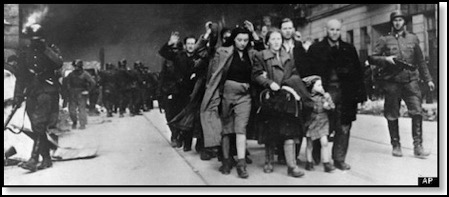
Two days before her comrades embarked on an uprising that came to symbolize Jewish resistance against the Nazis in World War II, 14-year-old Aliza Mendel got her orders: Escape from the Warsaw Ghetto.
The end was near. Nazi troops had encircled the ghetto, and the remaining Jewish rebels inside were prepared to die fighting. They had few weapons, and they felt there was no point in giving one of them to a teenage girl whose main task to that point had been distributing leaflets.
"They told me I was too young to fight," said the survivor, now 84, who uses her married name, Aliza Vitis-Shomron. "They said, `You have to leave and tell the world how we died fighting the Nazis. That is your job now.'"

Banality of Evil
29/03/13 08:57
Throughout history, people with evil intentions to others have arisen. Hitler, Stalin, Pol Pot, Saddam Hussein, Eichmann, Qaddafi are all of that ilk. Yet, later on in life, some of these people are found in small walks of life living simply and not like the power players they think are.
Great evil never rises to the occasion. We have expectations of it that are never met. The philosopher Hannah Arendt gave us that singular lesson in her extraordinary Eichmann in Jerusalem, first published in 1963. The crimes had been monumental, but the man she glimpsed in a glass booth was a disappointment: “medium-sized, slender, middle-aged, with receding hair, ill-fitting teeth, and nearsighted eyes, who throughout the trial keeps craning his scraggy neck toward the bench.” The very ordinary—“banal”—man, and the extraordinary crimes.
A further discussion is found here.

Great evil never rises to the occasion. We have expectations of it that are never met. The philosopher Hannah Arendt gave us that singular lesson in her extraordinary Eichmann in Jerusalem, first published in 1963. The crimes had been monumental, but the man she glimpsed in a glass booth was a disappointment: “medium-sized, slender, middle-aged, with receding hair, ill-fitting teeth, and nearsighted eyes, who throughout the trial keeps craning his scraggy neck toward the bench.” The very ordinary—“banal”—man, and the extraordinary crimes.
A further discussion is found here.

Alexander Hamilton
28/03/13 08:06
Ron Chernow has written an outstanding biography of Alexander Hamilton, one of our Founding Fathers. Hamilton helped stabilize the early nation’s economy and manage our early war debt from the Revolution. He was a strong Federalist and government management of the money supply and finance.
But Hamilton had established the first political precedent of national involvement in money and finance. That history and its supposed success would be continually asserted to pave the way, at least in part, for the Federal Reserve System in the early twentieth century.
More about this can be read here.
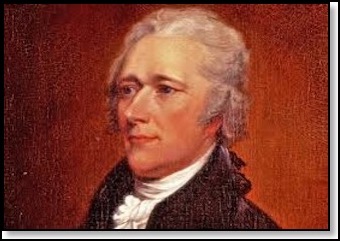
But Hamilton had established the first political precedent of national involvement in money and finance. That history and its supposed success would be continually asserted to pave the way, at least in part, for the Federal Reserve System in the early twentieth century.
More about this can be read here.

Lock Pickers in Olden Days
13/03/13 10:51
“Ripper Street” is a crime drama found on BBC America Saturday nights. It has the feel of “Copper” which is set in New York City among the Irish in 5 Corners as a drama. There was an interesting story that brought these two dramas to mind and that is one on lock pickers. One American traveled to England to open a supposed impossible to open safe. He had gained a reputation in the United States of being able to open supposed difficult locks. It is a fascinating history of this trade, crime, and people in that day and age of England. Check it out here in this article in Slate online.
They were drawn by a curious invitation: “To witness an attempt to open a lock throwing three bolts, and having six tumblers, affixed to the iron door of a strong room.” The men gathered around the door to a vault, once the repository of records for the South-Eastern Railway. At their center was an unassuming figure, an American named Alfred C. Hobbs, clad in waistcoat and collar. At 11:35 a.m., Hobbs produced a few small tools from his pocket—“a description of which, for obvious reasons, we fear to give” a correspondent for the Times wrote—and turned his attention to the vault’s lock. His heavy brows knitted, Hobbs’ hands flitted about the lock with a faint metallic scratching. Twenty-five minutes later, it opened with a sharp click. Amid the excited murmur, the witnesses asked Hobbs to repeat the task. Having relocked the vault, he once again set upon it with deft economy. The vault opened “in the short space of seven minutes,” as the witnesses would testify, “without the slightest injury to the lock or the door.”
They were drawn by a curious invitation: “To witness an attempt to open a lock throwing three bolts, and having six tumblers, affixed to the iron door of a strong room.” The men gathered around the door to a vault, once the repository of records for the South-Eastern Railway. At their center was an unassuming figure, an American named Alfred C. Hobbs, clad in waistcoat and collar. At 11:35 a.m., Hobbs produced a few small tools from his pocket—“a description of which, for obvious reasons, we fear to give” a correspondent for the Times wrote—and turned his attention to the vault’s lock. His heavy brows knitted, Hobbs’ hands flitted about the lock with a faint metallic scratching. Twenty-five minutes later, it opened with a sharp click. Amid the excited murmur, the witnesses asked Hobbs to repeat the task. Having relocked the vault, he once again set upon it with deft economy. The vault opened “in the short space of seven minutes,” as the witnesses would testify, “without the slightest injury to the lock or the door.”
Knights in Car Parks
12/03/13 10:44
One never knows that you can dig up when you go removing old car parks in parts of Great Britain. First there was Richard III of England who was located under a car park. Now they have found a 13th century knight buried under a car park removed to make way for a new building in Edinburgh. You wonder what story he could tell about life in those times. The location had been the place of a Blackfriars Monastery at one time. An article describing the discovery is found here.
Along with the knight or nobleman's grave and skeleton, the excavation has revealed the exact location of the monastery, which was founded in 1230 by Alexander II (King of Scotland 1214-49) and destroyed during the Protestant Reformation in 1558.
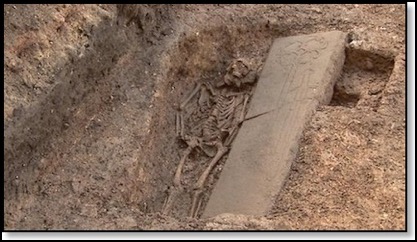
Along with the knight or nobleman's grave and skeleton, the excavation has revealed the exact location of the monastery, which was founded in 1230 by Alexander II (King of Scotland 1214-49) and destroyed during the Protestant Reformation in 1558.

Stonehenge
11/03/13 11:37
Having been to Stonehenge, or at least looking in from the perimeter, there are reports from researchers that Stonehenge was possibly a graveyard to start. To learn more, please read this article about this new theory. An excerpt…….
British researchers have proposed a new theory for the origins of Stonehenge: It may have started as a giant burial ground for elite families around 3,000 B.C.
New studies of cremated human remains excavated from the site suggest that about 500 years before the Stonehenge we know today was built, a larger stone circle was erected at the same site as a community graveyard, researchers said Saturday.
"These were men, women, children, so presumably family groups," University College London professor Mike Parker Pearson, who led the team, said. "We'd thought that maybe it was a place where a dynasty of kings was buried, but this seemed to be much more of a community, a different kind of power structure."
Parker Pearson said archeologists studied the cremated bones of 63 individuals, and believed that they were buried around 3,000 B.C. The location of many of the cremated bodies was originally marked by bluestones, he said. That earlier circular enclosure, which measured around 300 feet (91 meters) across, could have been the burial ground for about 200 more people, Parker Pearson said.
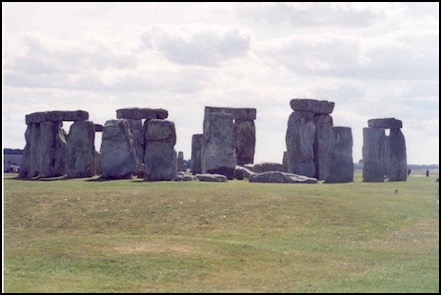
British researchers have proposed a new theory for the origins of Stonehenge: It may have started as a giant burial ground for elite families around 3,000 B.C.
New studies of cremated human remains excavated from the site suggest that about 500 years before the Stonehenge we know today was built, a larger stone circle was erected at the same site as a community graveyard, researchers said Saturday.
"These were men, women, children, so presumably family groups," University College London professor Mike Parker Pearson, who led the team, said. "We'd thought that maybe it was a place where a dynasty of kings was buried, but this seemed to be much more of a community, a different kind of power structure."
Parker Pearson said archeologists studied the cremated bones of 63 individuals, and believed that they were buried around 3,000 B.C. The location of many of the cremated bodies was originally marked by bluestones, he said. That earlier circular enclosure, which measured around 300 feet (91 meters) across, could have been the burial ground for about 200 more people, Parker Pearson said.

The Searchers
09/03/13 09:05
Considered one of the best and most classic Westerns in movie genre is The Searchers with John Wayne. The story behind the John Ford directed movie is the capture of Cynthia Parker as a young girl by Comanche raiders and her life as a Native American captive until rescued. One of her offspring was Quanah Parker, a legend in Comanche lore, and Texas history. He became a large landowner in Texas after living and fighting as a Comanche. A recent book describes the making of the movie and our struggle as we tamed the West with settlers with the Native American peoples. For another take on this topic and book, the Wall Street Journal has this article
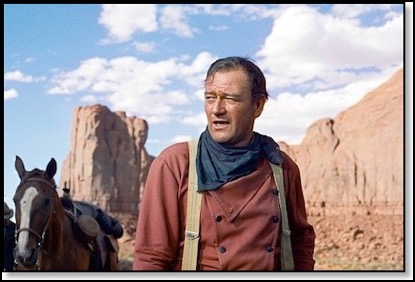
John Wayne in The Searchers
Two more articles on this topic can be found here and here.

John Wayne in The Searchers
Two more articles on this topic can be found here and here.
Vikings
07/03/13 08:49
What with the new Vikings television show on the History Channel, it brings back the visits to Norway and the Viking museum outside Oslo. The long ships are impressive and it is amazing that the Vikings traveled across the North Sea and the Atlantic Ocean. The TV series is set in 739 A.D. when the Vikings were setting out to raid Britain and Ireland. This was a turning time in history, the Vikings brought a lot of murder and mayhem along with many things that are part of our English history such as towns and markets. An interesting article on the find of a possible “Viking Sunstone” that may have been used to find the sun and navigate across the large open waters. An allusion to such a crystal or sunstone was made in the TV series.
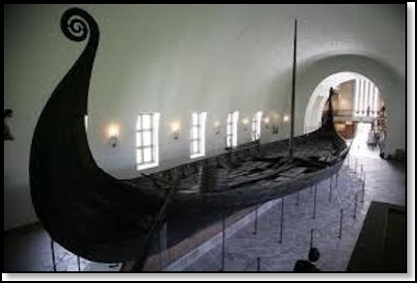
A Viking Ship

A Viking Ship
Hitler and Stalin
05/03/13 15:18
An author who knows this historical period and its significance has written a piece in the New York Times comparing the quantity versus quality of deaths under Hitler versus Stalin. Who was worse? It would be no lesser of two evils if faced with either.What a truly terrible time in our history and to occur in a civilized 20th Century. Timothy Snyder is the author and I have his one book, Bloodlands. To understand the time, the article in the Times is found here.
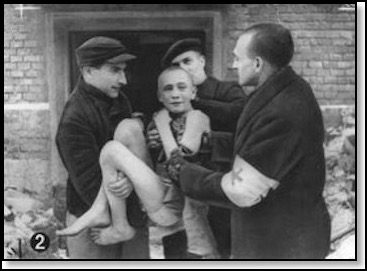

The Great Escape
04/03/13 20:31
Steve McQueen was a movie star playing in The Great Escape. He could go home to a more glamorous lifestyle. Unfortunately, the story was based on a real life escape from a Stalag in Poland not far from the Baltic. Many escaped and were recaptured. 50 of those were killed in retaliation to the escape on Hitler’s orders. The men who carried out the executions were found by great detective work and put on trial. An interesting story about what is a horrible episode from World War II.
Holocaust News
03/03/13 20:28
Researchers have found that the number of concentration camps and ghettos used by the Nazis was higher than originally thought. The work indicates there were close to 42,500 of such named places during the war. More details can be found here in this article.
Women of the Gulag
20/02/13 08:22
One of the saddest and most interesting books I have read in the last few years was Bloodlands by Timothy Snyder. It describes the large area of land in eastern Poland, Ukraine, Belarus, and the Baltics where the Germans and Soviets fought for control before, during, and after World War II. A large portion of the book discussed the Great Famine and Great Terror plus the purge that Stalin wrought on these countries and also the Russian Motherland itself. There will be a new book out called Women of the Gulag. It describes the effects of Stalin’s actions against the men in these women’s’ lives and the spillover to the women. To rise to the top and be brought down by a psychotic megalomaniac afraid of potential rivals. An article describing the book and 5 of the women is found here. A page related to this topic is also here.
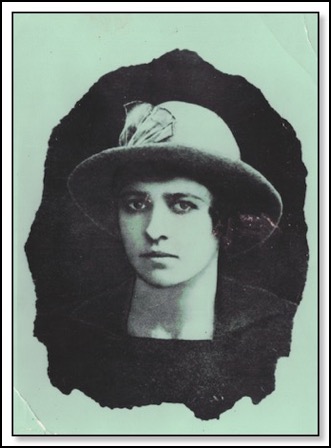

1963
18/02/13 13:50
I came across this article in The Atlantic Magazine online. They posted 50 photos from the year 1963. A number of the photos were key influencers on issues of that day. One photos is of an older Buddhist monk who set himself ablaze in protest to the suppression of the monks in South Vietnam by the government. The photo helped to lead to the government’s downfall. Another was a police dog lunging a a black youth during marches in Alabama.This photo’s appearance got the Kennedy government more deeply involved in moving Civil Rights for African-Americans forward. Of course there are the photos of the time around President Kennedy’s assassination in November. An interesting read about this time in history is in Bill O’Reilly’s book, Killing Kennedy. A look at the world 50 years ago.
Early Grant
17/02/13 10:07
Last night, Richard and Josi Lewis, our neighbors here in Berlin, invited us to dine out at Red Lobster in Eugene. We had a lively discussion. They are readers and book lovers too. We ended the evening at Barnes and Noble where I purchased as one of 3 books, an biography of Grant. I told them of a recent blog article of the Ohio Congressman, Thomas Hamer, who helped Grant get into West Point in one of the last slots he had available to give. The story of Thomas Hamer’s influence on history and what his loss might have meant to our country is found in the article here.
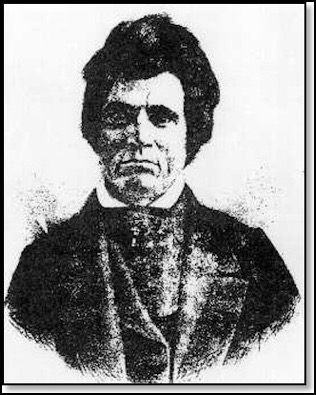
General Thomas Hamer

General Thomas Hamer
